
Vermont’s Mountain Sports and Life VT SKI RIDE + www.vtskiandride.com THE EXTREME SKIERS RETURN THE GREAT SNOWBOARDING HOMECOMING BACKCOUNTRY’S RUBY TOUR 3 PERFECT VERMONT WEEKENDS WINTER/SPRING 2024 FREE! FLASHBACK FLASHBACK THE BEST OF THE S ARE BACK
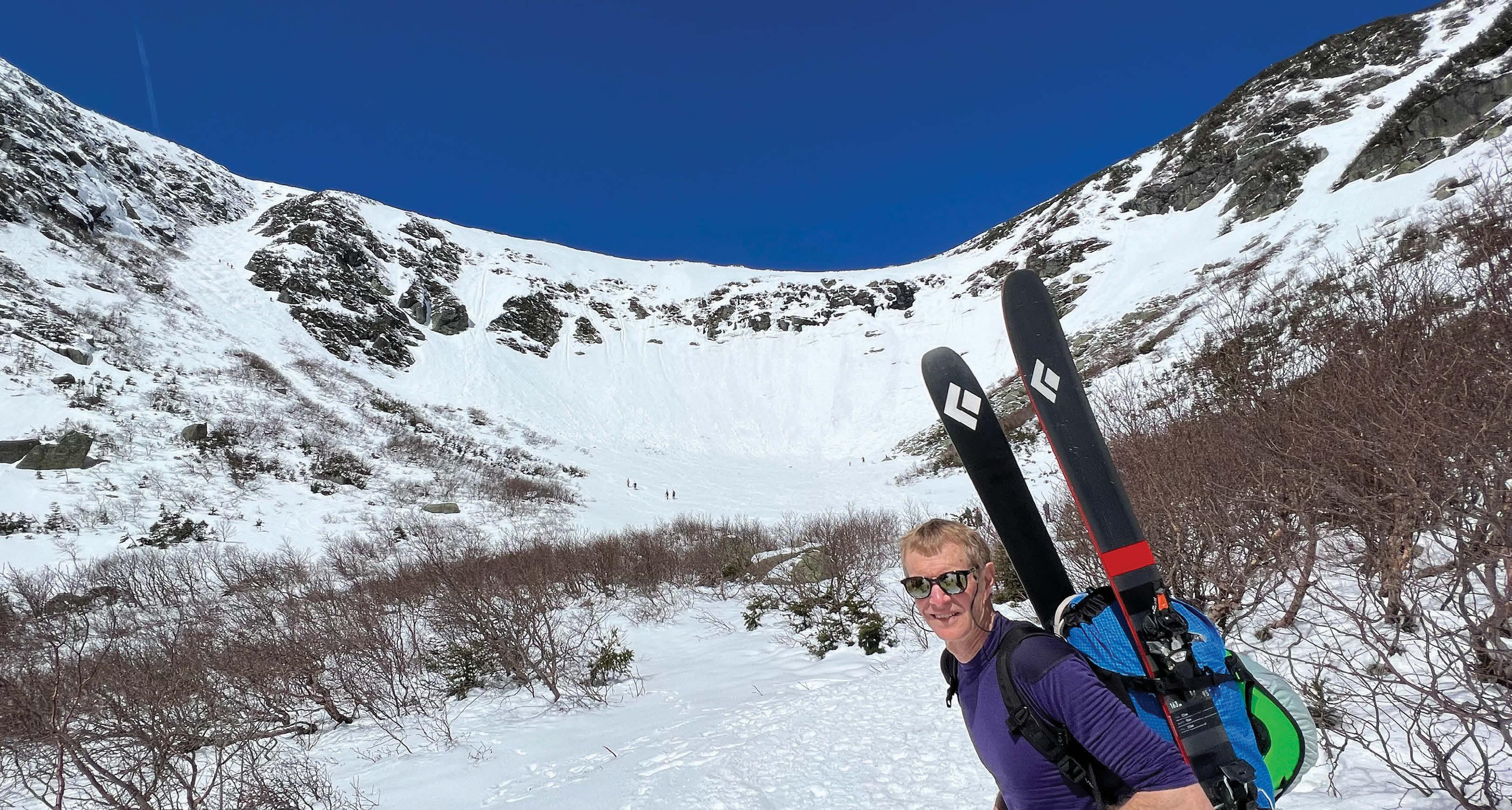
Dr. Nofziger always listens carefully and gives considered advice that helps me (almost) keep up with the younger generation.
–Ben Benedict, 72
Southwestern Vermont Medical Center is now member of Dartmouth Health.getting better.
 Matthew Nofziger, MD, SVMC Orthopedics
Matthew Nofziger, MD, SVMC Orthopedics
While we’ve been partners for years, Southwestern Medical Center and Dartmouth Health are coming together to provide better care. As a member hospital, you improved access, upgraded technology and specialty care including cancer treatments, orthopedics So now, the great care you’ve always received from even better. All right here, close to home.
Southwestern Vermont Medical Center is now a member of Dartmouth Health.
Learn more at svhealthcare.org
While we’ve been partners for years, Southwestern Vermont Medical Center and Dartmouth Health are coming even closer together to provide better care. As a member hospital, we bring you improved access, upgraded technology and expanded specialty care including cancer treatments, orthopedics and heart and vascular care.
This is what exceptional looks like.
Aging gracefully doesn’t mean living with pain or limiting activity. Along with his colleagues at SVMC Orthopedics, Dr. Matt Nofzinger delivers on our mission of providing exceptional care—including non-surgical options and same-day joint replacement—to help patients escape the limits of pain and injury and get back to living the life they love. No exceptions.
Learn more at svhealthcare.org
So now, the great care you’ve always received from SVMC will be even better. All right here, close to home.
svhealthcare.org/ortho
getting better.
SVMC Orthopedics 802-442-6314 Bennington, VT Williamstown , MA svhealthcare.org/ortho
Ben Benedict at the base of Tuckerman’s Ravine, Mt. Washinton, May 2023. Ben has been a patient of Dr. Matthew Nofziger for over ten years.

VERMONT AND NEW HAMPSHIRE DAYS AT THE BEAST.
As if it wasn't great enough to call these states home already, Vermont and New Hampshire residents are cordially invited to ski or ride Killington Resort on Tuesdays and Wednesdays for the biggest deal available. Pay just $83 midseason, with even more discounted rates during early and late season. Online purchase and valid VT/NH identification are all that's required to score this deal. Offer not valid on peak dates. Scan code or visit killington.com/tickets to purchase.



802.655.0009 RedHouseBuilding.com Timeless Craftsmanship + Employee Owned
Fine Homebuilding + Construction Manage ment
Ryan Bent Photography
CONTENTS
FEATURES
28 | Design With a View
A Chicago transplant wanted a minimalist, modern house but one that fit into Vermont’s rural landscape. Here’s what he built.
34 | Return of the Natives
Some of the best all-mountain skiers in the world —the people you watched in the extreme ski films of the 1990s — grew up skiing at Bolton Valley. Now they are back. Plus, tips for skiing trees.
42 | Homecoming
This March, many of the greatest snowboarders of the last four generations will come back to Stratton for one helluva party.

COLUMNS & DEPARTMENTS
8 | FIRST TRACKS | The Rites of Spring
Our picks for the best tailgate parties, extreme challenges, spring brewfests, maple sugaring and more.
11 | SKI AREA NEWS | Saving Cross Country
Cross country ski areas are fighting the impacts of climate change with technology, eco-friendly systems and Yankee ingenuity.
19 | PERSPECTIVE | My Winter Family
What does it mean to be part of a ski community?
23 | APRES | Ultimate Vermont Weekends
Whether you want to spend $500 or $1,500 on a perfect ski weekend, these three ski towns have you covered. Here are our picks.
52 | COACH | Master the Moguls
You’re not a “good” skier unless you can ski bumps. These four tips will help you get your game on.
55 | RETRO VT | The Ruby Tour
Forty years after three friends first mapped and skied the Catamount Trail they are back at it.
61 | GREEN MOUNTAIN CALENDAR
64 | CHAIRLIFT Q/A | Rescue Chief
When 23 skiers were lost on one cold afternoon in Killington, here’s who helped to coordinate the rescue.
vtskiandride.com Winter/Spring 2024 3
WINTER/SPRING 2024
at play in
Valley’s Devil’s Playground in the 1990s.
THIS PAGE: Zeb Powell keeping the Stratton crowd entertained at Homesick in 2023.
COVER: Dean Decas
Bolton
Photo by Hank DeVre
Photo by Peter Cirilli

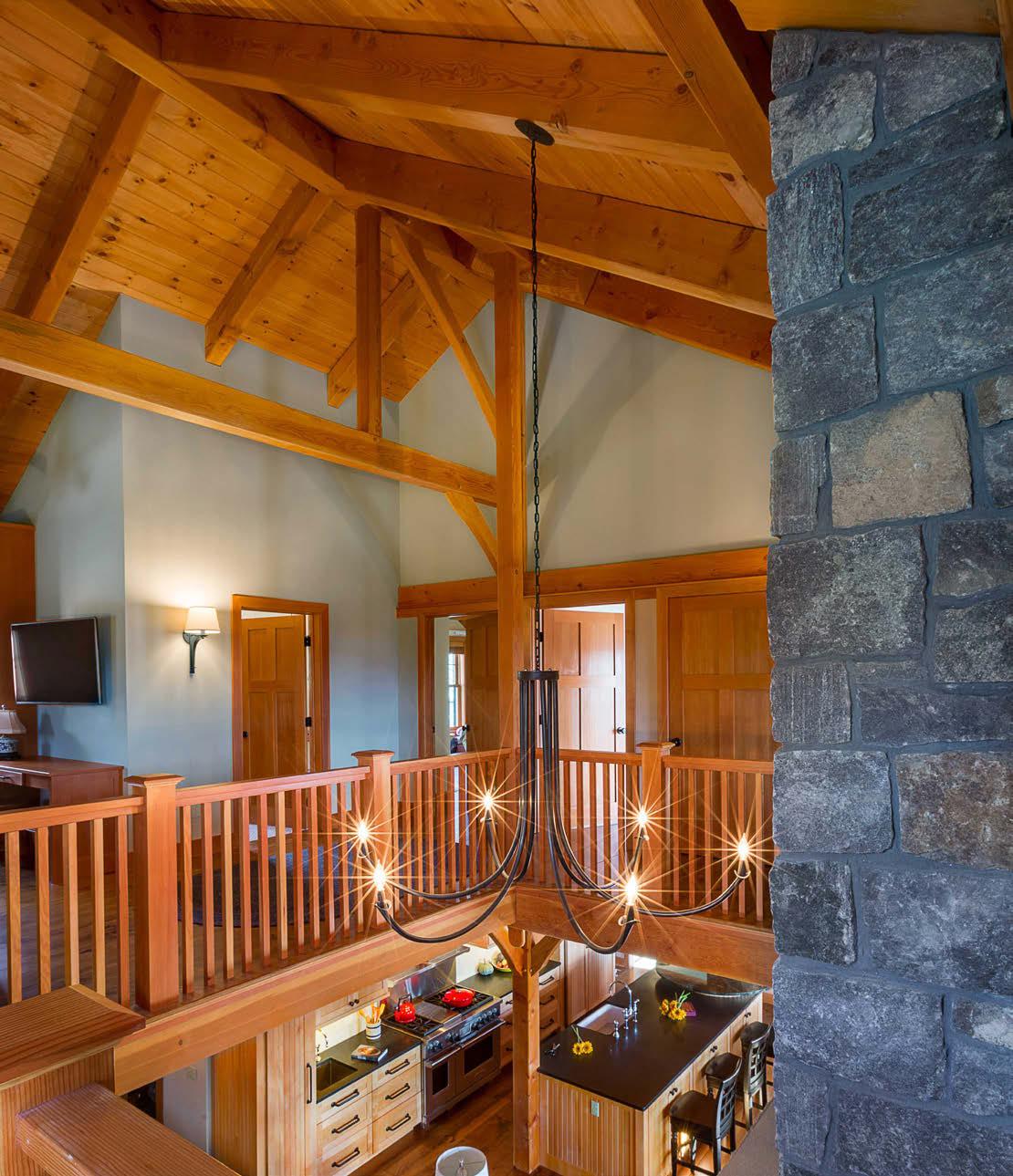
FROM THE TOP
1990s Flashback

Was the 1990s the best era in skiing and riding?
If you were in Vermont then, the answer may well be yes. This was a time when snowboarding was exploding like fireworks as Dave Schmidt writes in “Homecoming.”
It was a time when a handful of 20-something skiers from Vermont were dominating the credits in Warren Miller films: the DesLauriers and the Egans defined “extreme skiing” in the U.S., with Vermont skiers such as Dean Decas, Tom Day, Robbie Huntoon and a handful of others in films as well.
And backcountry skiing was getting a huge boost from the newly mapped Catamount Trail and the association that sprang up around it.
Flash forward: In this issue we celebrate a number of “returns.” The DesLauriers bought back Bolton Valley in 2017. Now, with son Eric’s return, four of founder Ralph DesLauriers five children run the resort.
In Homesick, Gary Land and Barry Dugan have created a seismic event that has brought the greatest names from three generations of snowboarding back to Stratton, reliving the glory days of the 1990s.
And the three founders of the Catamount Trail are returning to ski the trail they founded and mapped 40 years go.
Hey, we’re sorry if you missed the ‘90s. But stick around, the best of that era is back and carrying on. — Lisa Lynn, Editor
CONTRIBUTORS
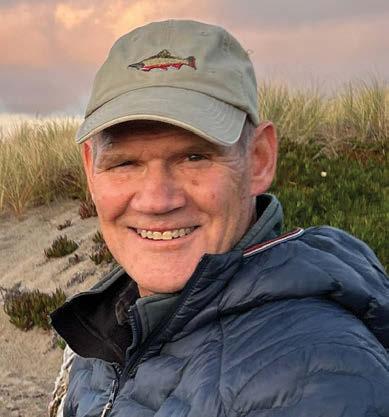
p. 11
Angelo Lynn writes about the future of cross-country skiing in this issue. The publisher of this magazine and of The Addison Independent, he is a past president of The New England Newspaper and Press Association..

p. 42
Dave Schmidt who covered Homesick for us, worked at Burton from 1986 to 2003 and was VP of Global Sales for over 10 years. He’s currently a business consultant and photographer living in Williston.

p. 46
David Goodman is a contributing editor and author of Best Backcountry Skiing in the Northeast, inspired in part by his early tours on the Catamount Trail, which he covers in “The Ruby Tour.”
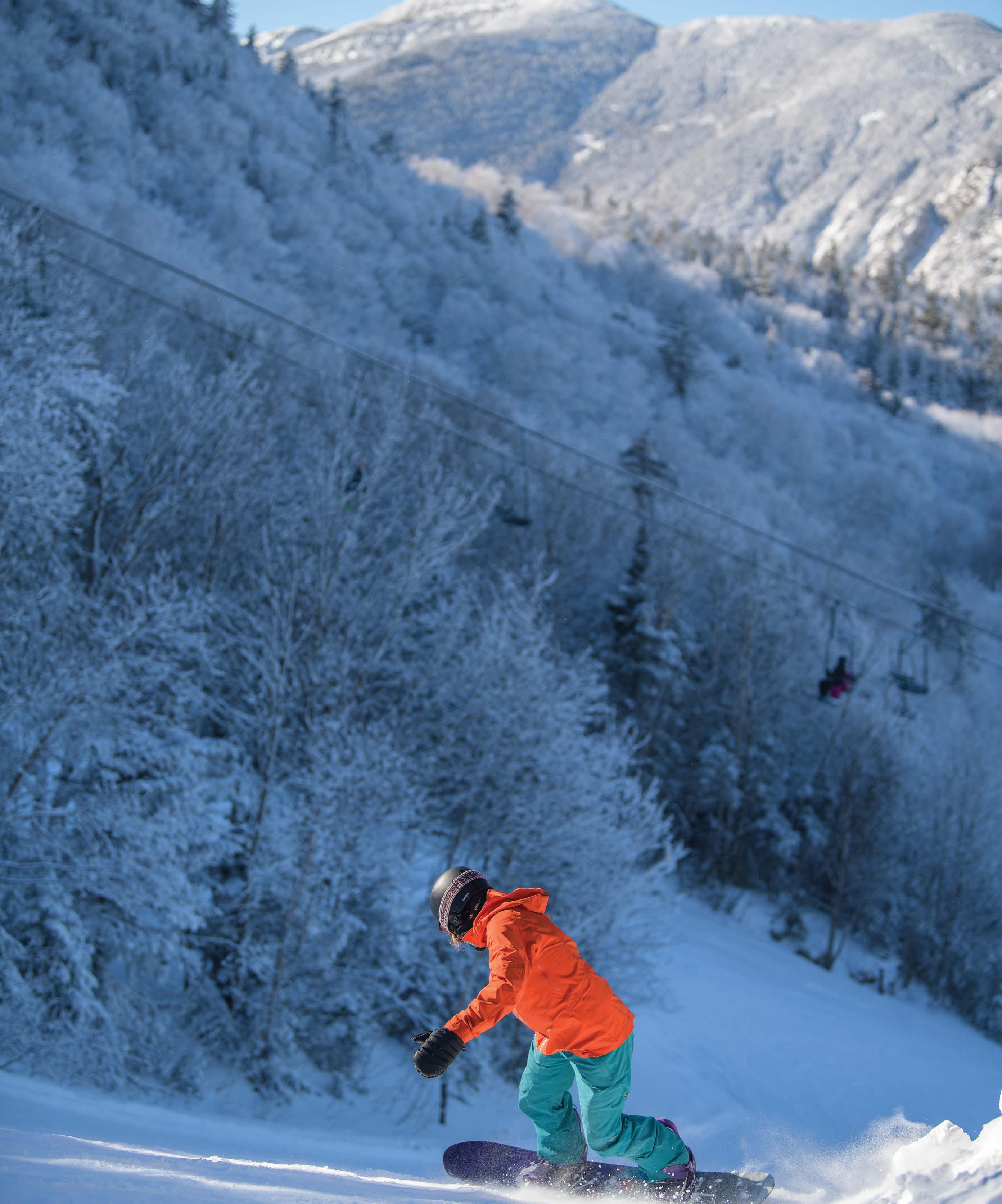
4 Winter/Spring 2023/24 vtskiandride.com
Serving Vermont and Upstate New York • 888-484-4200 mckernongroup.com Visit our website for the portfolio of this home and more!
Shaun Palmer at the U.S. Open at Stratton in the 1990s. Photo by Hubert Schriebl.


VT SKI RIDE +
EDITORIAL
Publisher Angelo Lynn angelo@vtskiandride.com
Editor/Co-Publisher Lisa Lynn editor@vtskiandride.com
Creative Director David Pollard
Contributing Writers and Photographers: Victoria Gaither, David Goodman, Ali Kaukas, Brian Mohr, Lindsay Selin, Doug Stewart, Jeb Wallace-Brodeur
ADVERTISING SALES & DISTRIBUTION
For general advertising and media kits: lisa.lynn@vtsports.com | 802-388-4944
Greg Meulemans greg@vtskiandride.com
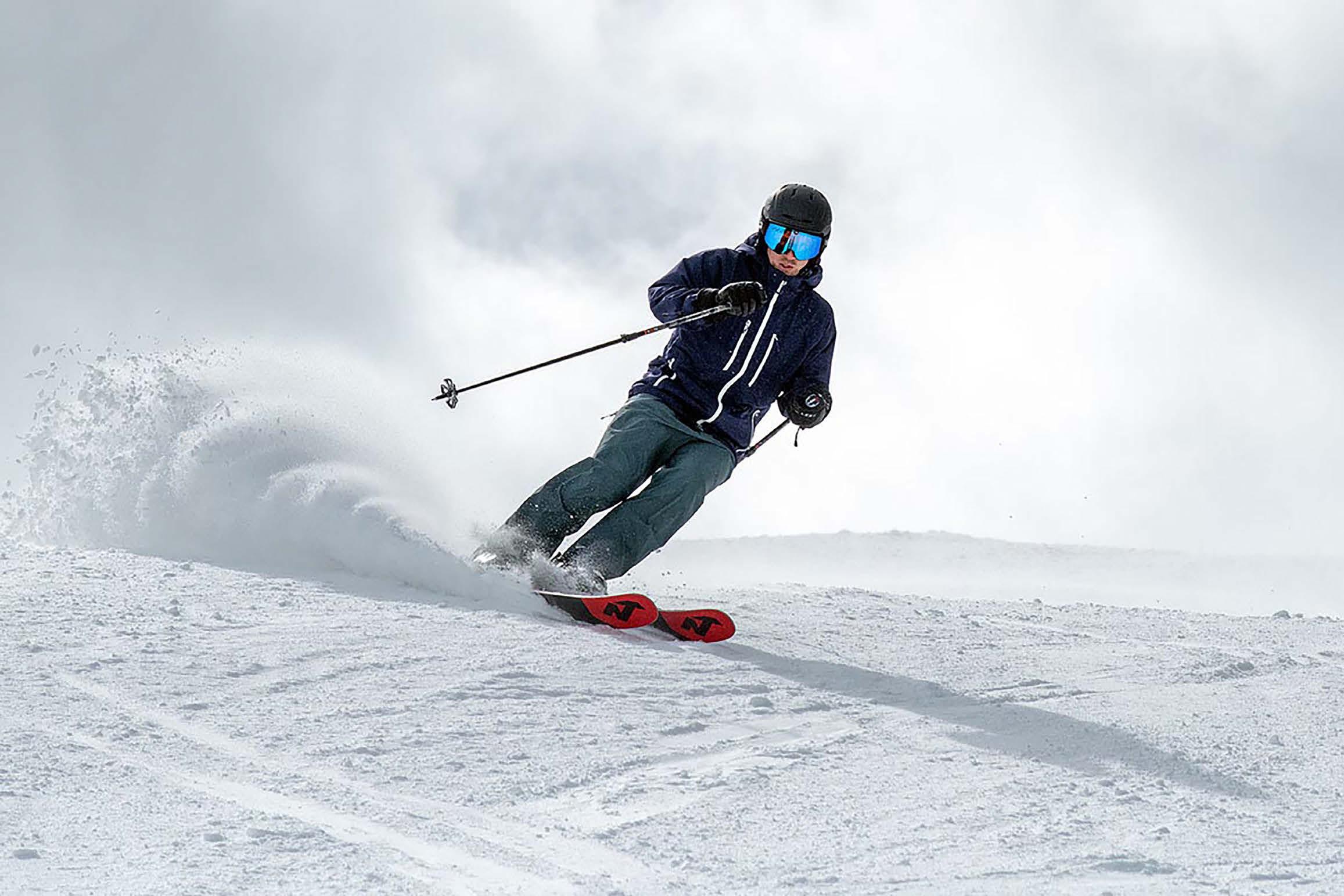


Dave Honeywell dave_golfhouse@madriver.com
Wilkie Bushby willbush7@gmail.com
VT SKI+RIDE is published four times a year by Addison Press Inc., 58 Maple Street, Middlebury, VT 05753
VT SKI+RIDE print subscriptions are available for $60 (U.S.) per year. Digital subcriptions are free. Subscribe at vtskiandride.com.







HEADQUARTERS
What’s New at VTSKIANDRIDE.COM? GET THE NEWS FIRST Sign up for our e-newsletter for breaking news and deals, contests and more. to see videos and stories that you won’t find in print. SUBSCRIBE FOR FREE Don’t miss an issue—read our free digital edition and find back issues at vtskiandride.com Follow us on Facebook, Twitter and Instagram.
6 Winter/Spring 2023/24 vtskiandride.com

Welcome Home
The decision to build your new home can feel overwhelming, but with the right help it can also be deeply rewarding. At Bensonwood, we draw from more than 50 years of homebuilding experience to guide you through a smooth design build process resulting in faster time to completion, lower energy bills and a comfortable, healthy home for you and your family to enjoy for generations.

www.bensonwood.com

THE RITES OF FIRST TRACKS
WHAT’S NEW AT SKI AREAS AROUND VERMONT.
Eclipse Parties
Jay Peak gets the gold for going all in for the April 8 solar eclipse. Northern Vermont is in the direct path of the eclipse, which will happen between 3:26 and 3:31 there. Jay Peak will have a free concert with Pink Floyd cover band Pink Talking Fish playing Dark Side of the Moon. Silver to Smuggler’s Notch which is hosting Cirque de Fuego fire performers and fireworks on April 7 and then a carnival on the afternoon of April 8, with free viewing glasses. Bronze goes to Burke Mountain for its viewing party package with a “Cosmic Breakfast” and “out of this world signature cocktails” at a pop-up bar.

MAPLE SUGARING
Each spring, plumes of smoke go up from sugar shacks around the state as Vermonters boil the spring run of maple sap into sweet syrup. Don’t miss visiting a local sugar house over Maple Open House Weekend (March 23-24). Gold for the best sugarhouse is a tie: To visit the Trapp Family Lodge’s sugaring operation you actually have to cross country ski or snowshoe there. But just next to Cochran’s ski area is a sugar shack that’s run by members of the Olympic medal-winning ski racing family. They produce Slopeside Syrup from the maples that line the ski trails. Slopeside Syrup is also often served up over snow to racers at Stowe’s annual Sugar Slalom (April 1-2), which earns bronze.
BREWFESTS
Vermont has more breweries per capita than any state and, it seems, more brewfests as well. Sample a Sip of Sunshine and a flight of 7 other local craft brews at Smugglers’ Notch’s Brew & Ski Weekend (March 29-April 1). Mount Snow’s Sip of Spring festival (April 6) is a chance to sample local craft beers, ciders, and ready-to-drink beverages. The event also features giveaways, food trucks, and live music.

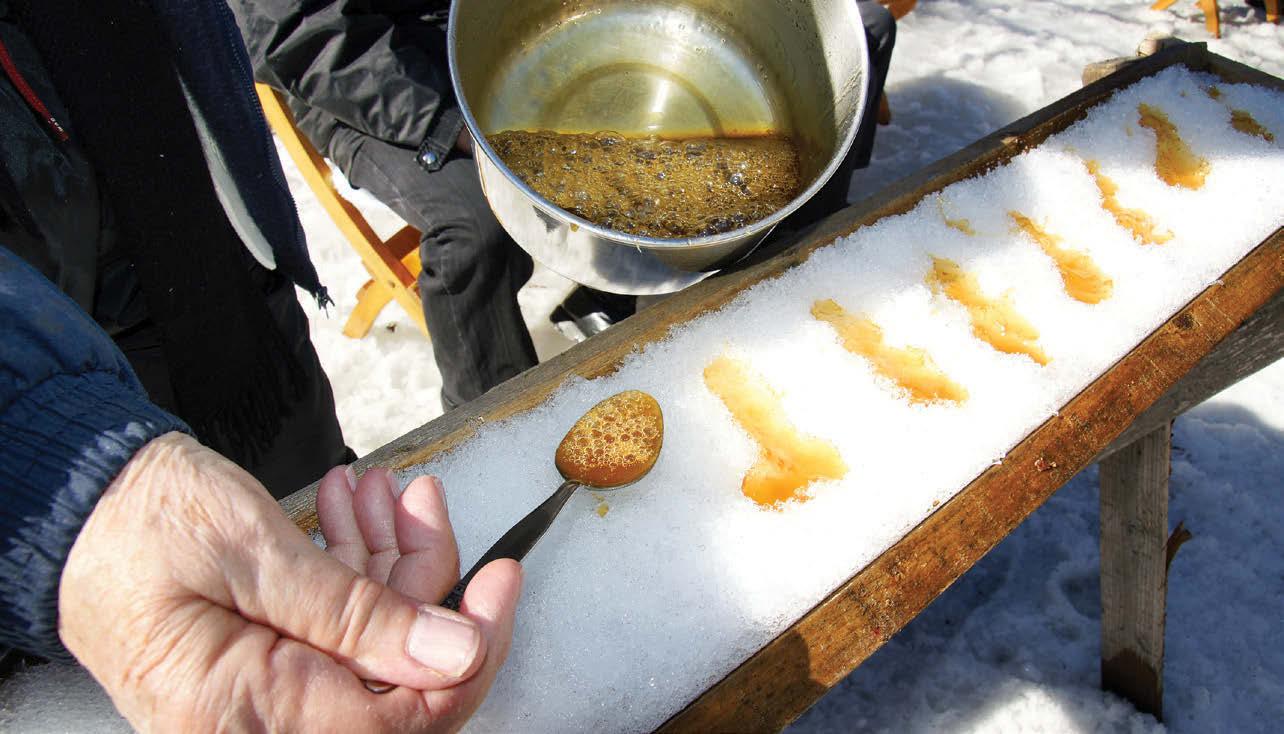
8 Winter/Spring 2024 vtskiandride.com
SPRING
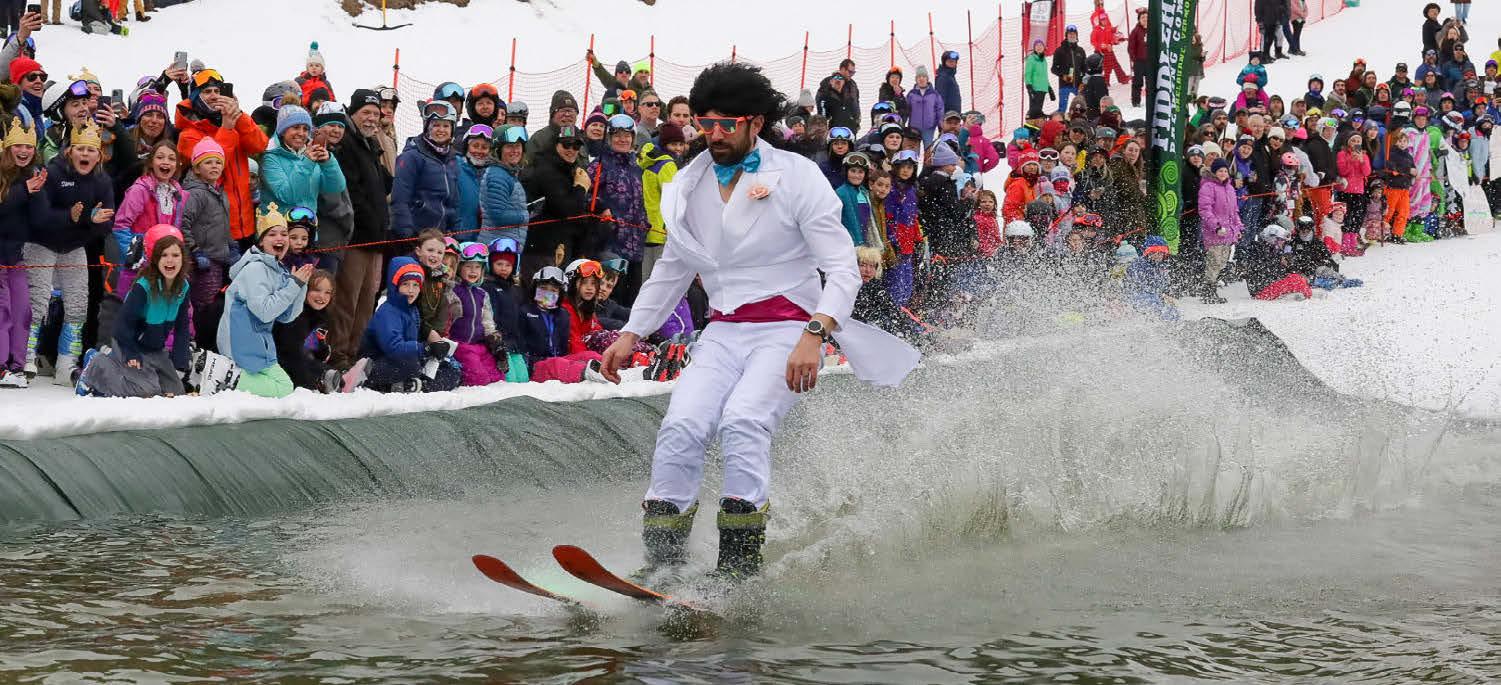
Extreme Challenges
Magic Mountain’s Tuck-It (Feb. 17) gets the gold here: it’s just you, a pair of skis and a radar gun. Silver goes to Mad River Glen though for its long-standing Rockefeller Challenge (March 16) where you pick up as much speed as possible going downhill to see how far you can coast up the Rockefeller Trail on the other side. Bronze goes to an event that returns after a long hiatus: the Mad River Triathlon (April 14) involves running the Mad River path, paddling the Mad River, cycling up to Sugarbush’s Mt. Ellen, skinning up the mountain on skis and then racing down.

In honor of the silly season, we’re handing out medals for some of the best spring events at ski areas around the state.
POND SKIMMING
Nothing says spring skiing like pond skimming. Mount Snow, Stratton, Okemo, Killington, Sugarbush, Mad River Glen, Smuggler’s Notch, and Jay Peak all dig out trenches – 100 feet or so – fill them with water and encourage costumes and antics. The winners send it across, the others sink (and get pulled out). It’s hard to say who does it better but the award for creativity goes to Burke Mountain (left), which holds an annual Prom Skim – prom dresses and suits encouraged. Check each resort’s website for dates, as pond skims are often dependent on weather and conditions.
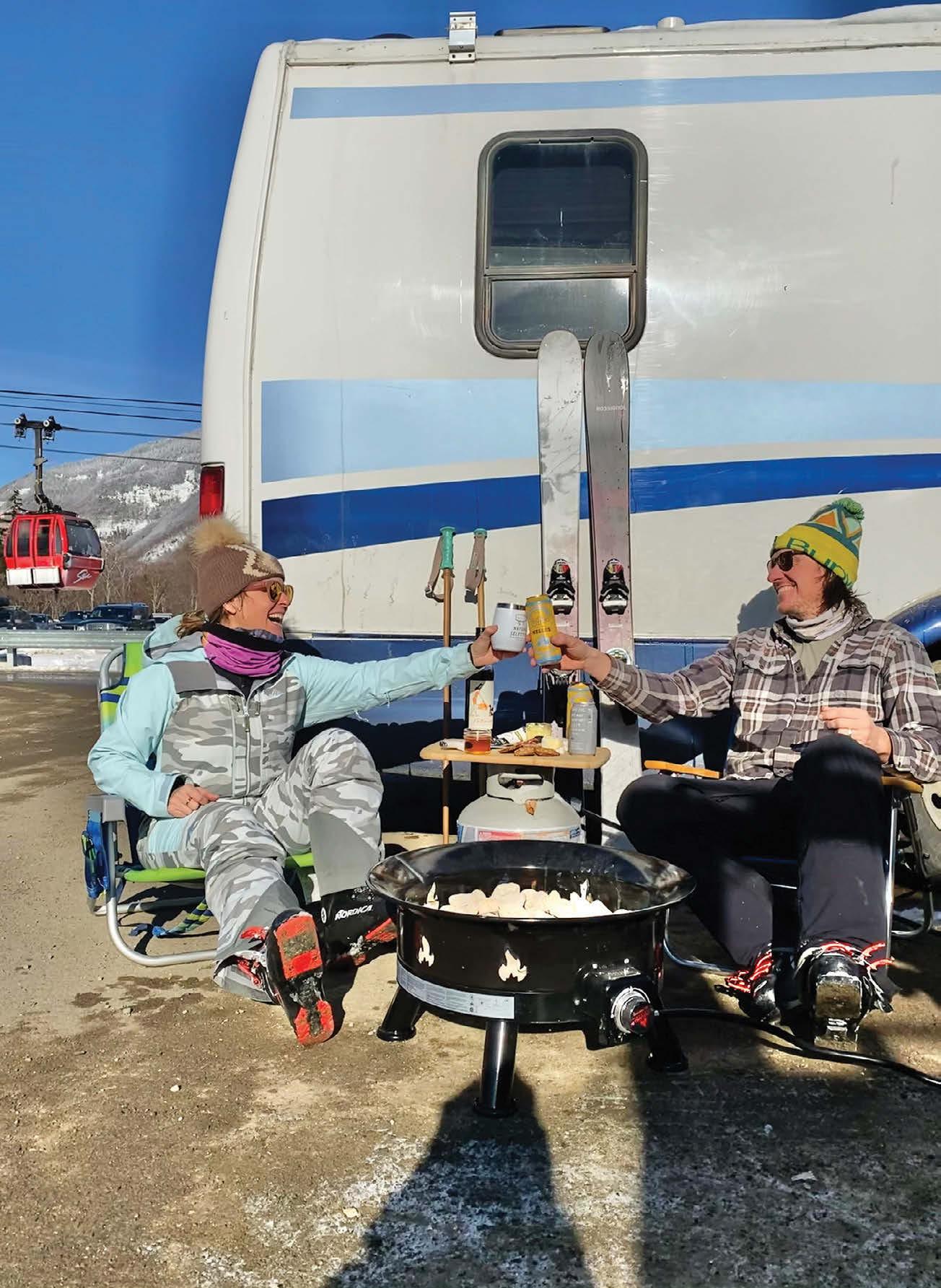
TAILGATING
“All this just to party in the mud with your friends,” is the motto of @FreeLot1, the unofficial and often hilarious Instagram for Smugglers’ Notch Resort’s parking lot scene. That motto also sums up spring tailgating. With BBQs, costumes, fire pits, music and libations, ski area tailgating has reached a new level, post-pandemic. Taking the gold for the best spring tailgate scene?
Killington’s Bear Mountain lot (especially the weekend of the Bear Mountain mogul challenge.) Smuggs’ Lot 1 gets silver both for the attitude and yes, the fact that it is still free. Bronze goes to Stowe’s Mt. Mansfield lot (shown at left) for style.
vtskiandride.com Winter/Spring 2024 9

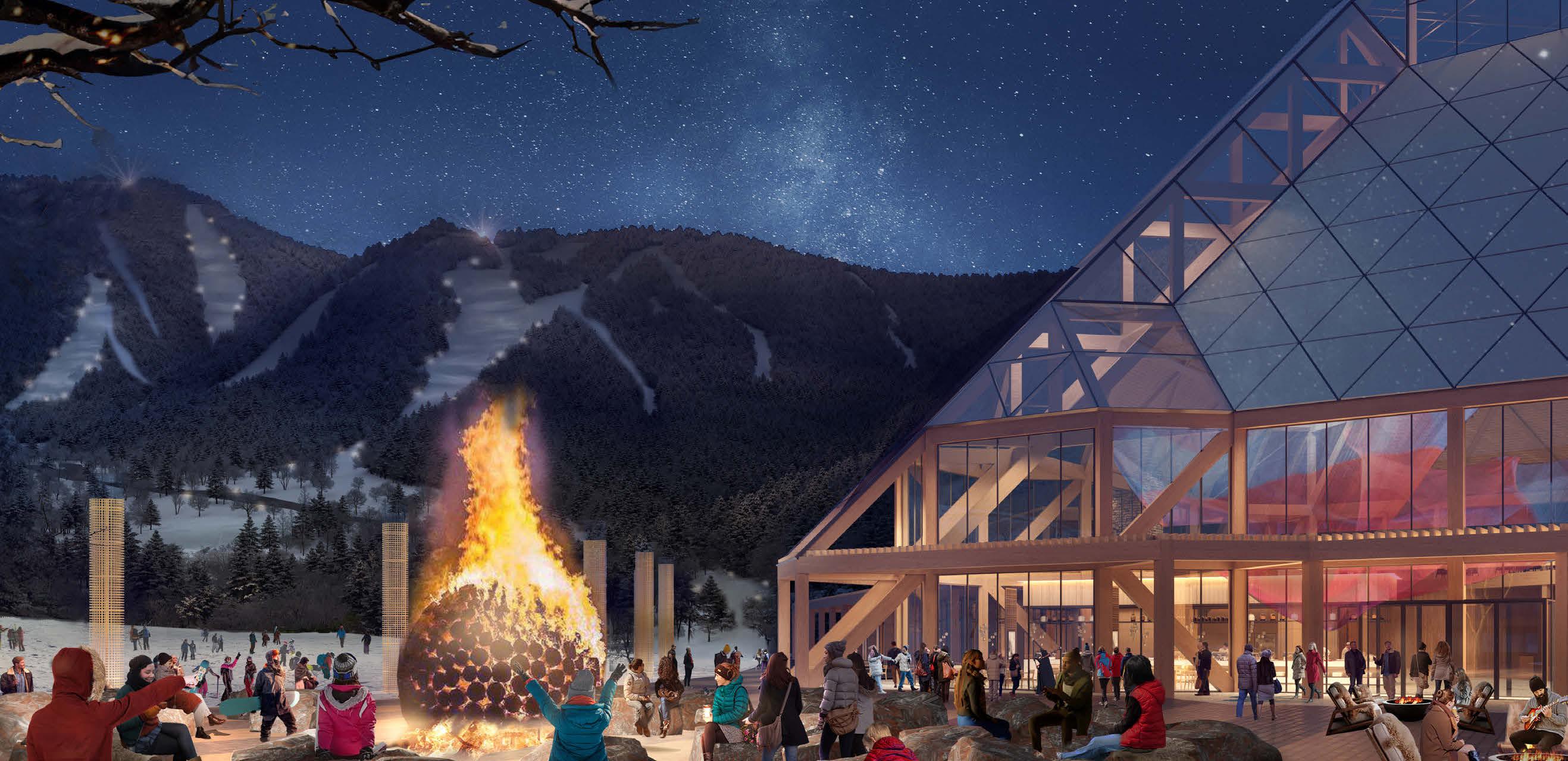
LIVEKILLINGTON.COM
PEAK OF TOMORROW
Unexpected New Mountain Lifestyle by Great Gulf. DISCOVER MORE AT CONDOS. TOWNHOMES. HOME SITES. COMING SOON! RENDERING IS ARTIST CONCEPT E. & O. E.
THE
An


Saving Cross Country
Around Vermont, cross country ski areas are fighting the impacts of climate change with technology, eco-friendly systems and good old Yankee ingenuity. By Angelo Lynn


In a ski season that’s been warmer than normal, author and environmental activist Bill McKibben still managed to log 55 days on cross-country skis by January 10. He even logged 25 miles before Thanksgiving, training on less than a half-mile loop of man-made snow at the Rikert Outdoor Center near his home in Ripton.
That’s impressive given the unusually warm temperatures and rains that have plagued this season. But Rikert’s 5K racing loop, one of a few in the state that has a piped snowmaking system, allowed many skiers to start early.
McKibben, who wrote the book Long Distance about his year training as if he were an Olympic cross country ski racer, is one of the die-hards who ski no matter the conditions. “Hey, bear in mind that I will ski on anything. Fast grass is enough,” he said.
The author of numerous books on climate change, McKibben is also keenly aware of the threats to the sport’s future. Recently, he reminded me that 20 years ago the EPA said in their regional climate report for northern New England that “cross country skiing might
well become extinct in the second half of this century, along with snowmobiling.”
That’s a dire prediction for a state that has turned out cross country Olympians from John Caldwell to Bill Koch to rising star Ben Ogden.
Just as McKibben was logging his 50th day of the season, Jessie Diggins – who makes her summer home at Stratton – was on her way to win the Tour de Ski, cross country skiing’s equivalent to the Tour de France, and a World Cup event.
But for many Nordic ski areas in Vermont, the future is uncertain. Vermont’s Timber Creek in southern Vermont shut its doors last season, “after 39 happy years” of running the 14K operation, said owner Kelly Kahler. Essentially a one-man shop, Kahler retired and shuttered the area because the prospects of finding anyone to buy the center were slim.
The Landgrove Inn, once home to the Ogden family of cross country fame, sees fewer and fewer days when trails are covered. New owners have changed the focus from skiing to painting workshops.
And while some inns like Blueberry Hill Inn in Goshen, and the Highland Lodge in Craftsbury, still feature cross country skiing and snowshoeing, many of their trails are no longer groomed as they once were because of increased costs and, more to the point, winters that often don’t provide reliable snowfall.
Add in the unusually warm rains of this season, and that’s just another layer of frustration in an already challenging business.
BRIGHT SPOTS
Still there are bright spots. Blueberry Hill Inn has resurrected the Pig Race that the late innkeeper Tony Clark started in 1971. To be held March 16, it will challenge skiers to race the course on classic skis regardless of weather, terrain or grooming. Yet another classic race, the Bogburn Classic, long held at the Haydock family’s private trail system in Pomfret, moved to the Rikert Outdoor Center for the second consecutive year.
A piped system of snowguns on a 5K racing loop has helped skiers at Rikert Outdoor Center in Ripton extend their season, on either end.
NORDIC vtskiandride.com Winter/Spring 2024 11
Photo by Josh Hummel

While the course had to be modified with shorter loops, the ski race drew a record turnout of 255 participants. “Funny thing about that race this year,” Rikert’s business manager Robert Drake said. “We only had 105 registered a couple days before the race, but because we were able to make snow and the conditions were good, we were able to connect a few good loops. By race day on January 6, people really turned out.”
In 2012-2013, Rikert spent $850,000 to put in what was at the time the most sophisticated snowmaking at a cross country center in North America, which included a piped system around the 5K racecourse. “It saved us this year for sure,” said Drake.
“What we’re seeing is that our day pass numbers are affected by the weather, but not our passholders. We’ve actually seen an uptick in passholders, largely because we have a snowmaking system that gives us a chance to produce a reliable ski surface throughout most of the season.”
Of the 30 or so cross country areas in Vermont (see our Cross Country Ski Areas guide, p. 16-17), seven now have established snowmaking systems. Early this season, even Prospect Mountain, the southern Vermont ski area known for its natural snow thanks to the fact it has the highest base elevation of any Nordic area in Vermont, began testing its new snow guns.
For this season, movable snow guns will cover a 1.2-kilometer loop where local high school athletes and Williams College’s team can train. As part of a $900,000 capital campaign, the ski area hopes to add a new 3.9-kilometer trail with snowmaking in the next few years.
The Trapp Family Lodge Outdoor Center in Stowe recently added a new HKD Halo 2.0 fan gun. “It’s amazing,” said Sam von Trapp, whose father opened the first cross country center in America at the Trapp Family Lodge in 1968.
“It’s really made a difference covering the open meadow that greets everyone at the Outdoor Center facilities, and it gets skiers from there into the woods where we’re better able to preserve the snow throughout the season,” von Trapp says.
The Outdoor Center has had guns before but the new one will help to extend the ski season. As Lauren Stagnitti, the director of outdoor recreation, notes: “This new gun is more powerful, producing more snow per hour. It also has longer power cords so it can be placed farther out in the field, which will really make a difference in the spring when we start to lose snow on the lower trails.”
Last year, Stagnitti said, the ski area had a late start, opening everything by mid-January, but a late spring allowed them to stay open until April 9th.

FARMING SNOW
Reese Brown, executive director of the national Cross Country Ski Area Association, says everyone in the industry is keenly aware of the challenges. “At all the conferences we go to across the country the topic of conversation is the low snow and warming climate, both of which are so critical to our winters. And there are no easy answers,” says Brown, who lives in Woodstock. But ski areas are responding, he adds. “What are they doing? They’re doing a lot.”
Snow farming is one strategy that includes gathering the snow blown or plowed into piles, and using snow cats to move that snow onto the trails. Crafstbury Outdoor Center even worked with University of Vermont researchers to study if they could stockpile snow over the summer beneath a pile of wood chips. It worked.
Manicuring the trails, Brown said, is one of the most important pre-season strategies to a successful season. That entails keeping the trails as rock- and
For many years the popular Bogburn Classic was held on a private trail system in Pomfret. The last two years, due to poor natural snow, the event has moved to Rikert (above) where it is as popular as ever.
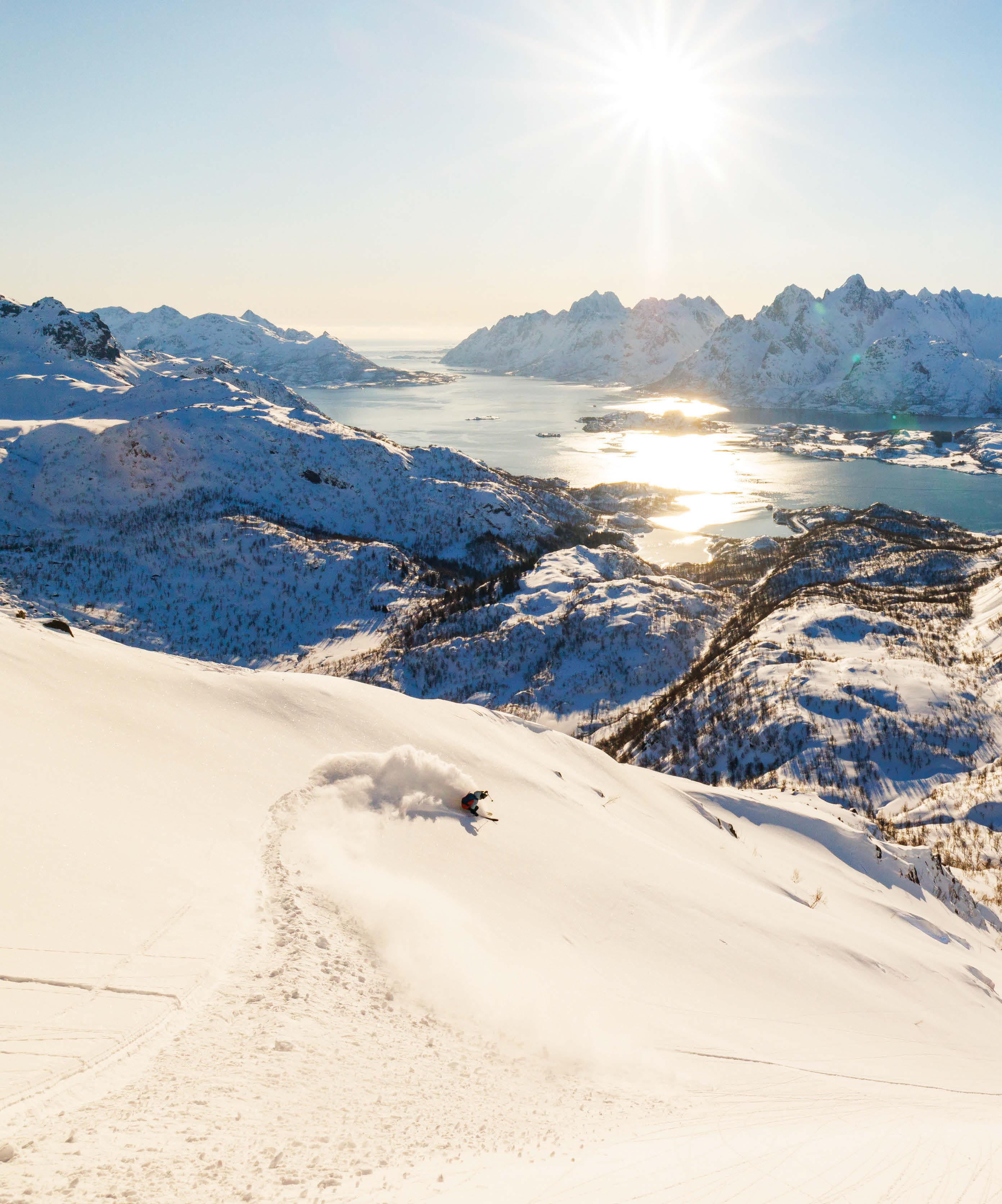
12 Winter/Spring 2024 vtskiandride.com NORDIC
Courtesy photo.


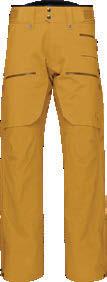
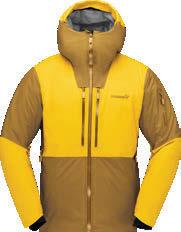
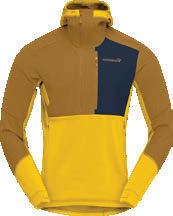


norrona.com Adventures: If you want to travel here or to one of our unique lodges, we offer great packages or tailor-made adventures. Norrøna Stores: New York, Boulder, Castle Rock. Our mission is to create the greatest outdoor products and offer unique adventures. Crafted with quality, function, design, and sustainability through four generations since 1929. The lofoten collection Innovative features, bold colors, signature design. Welcome to nature
At the Woodstock Inn & Resort, creating true connection is at the heart of everything we do. We invite you to lean in. To come closer. And to feel the experience of every moment.


Specializing in Custom Diamond Snowflakes


Closer To What Matters
woodstockinn.com
Woodstock, Vermont |
Come Closer to Wellness.
our full collection at: ferrojewelers.com/collections/vermont-inspired
See
Sleepy Hollow in Hinesburg is preparing for a future generation of skiers (below) by using renewable energy to power its snowguns and striving to be carbon neutral.

inches of snow can make a skiable surface.
Drainage ditches, once common on steeper pitches to prevent erosion, are being removed. The lack of snow this past decade has made it mandatory that ski areas replace the drainage ditches with culverts so the snow doesn’t have to be deep enough to fill in the ditch as it melts—an increasingly common headache as rains come more frequently at the height of the season.
Brown also said ski areas throughout the country are becoming more aware of the role a tree canopy plays over the trails. In some cases, the canopy needs to be thinned to allow for snow to land on the trail, while in other cases it can be desirable to protect trails from warming too fast in the spring sun.
Similarly, Brown said, ski areas are removing poplar trees, in particular, because their leaves fall late in the season after the first snows. Their dark color then absorbs heat and can create melted spots on the trails.
Lastly, many of the larger areas throughout the country are diversifying. Fat biking is now common at many cross-country centers and some areas in more metropolitan or high traffic areas are turning to snow tubing.
FACING CHALLENGES
The drawback to many of these strategies is that they are expensive. “You’re just not going to get a small cross county center putting in a multi-million snowmaking system,” Brown says.
Even the relatively affordable fan guns used to make piles of snow cost near or over $60,000, and

then a snowcat is needed to spread the snow around.
But there’s good news. “What we’ve found is that it’s fine for skiers to go round and round on a loop. We’ve seen that in play and you know what, the skiers don’t mind it. If the snow is good, they’re happy to glide around a relatively small loop until more snow arrives.”
Bill McKibben certainly is. He can recall very few days this season, if any, when he’s not been able to ski at Rikert. “Once there’s a strip of that man-made snow compacted, it’s all but impervious,” he says. “Of course, you have to be willing to loop the same half kilometer, but I find the motion of cross country skiing endlessly soothing. I seem to think better in motion.”
Nor is McKibben surprised by this season’s dismal start because scientists have been warning of warming winters for the past 30 years.
“In one sense a winter like this is not surprising, but it’s still so painful,” he says. “Winter is the whimsical season, when friction gives up its grip on the Earth for a while and lets you slide across the surface. That we’d sacrifice that to help Exxon’s profit margin is sad indeed.”
CLIMATE SOLUTIONS?
Several Vermont ski areas are working toward some creative solutions to reducing their impact on the climate.
At the Sleepy Hollow Inn and Cross Country Center in Hinesburg the snowmaking system covers 3 of its 32 kilometers of trails, but is entirely powered by renewable energy, thanks to the center’s 10 solar arrays. The center also has electric snowmobiles and has experimented with an electric grooming machine. More than 700 of Sleepy Hollow’s 800 acres are also enrolled in the Family Forest Carbon program, which enables it to earn carbon credits.
The Craftsbury Outdoor Center has been tracking and looking to reduce its carbon footprint for over a decade. Heat from the snowmaking system is funneled back into the central heating system for the center’s buildings which also rely on solar panels. They produce enough energy to cover the campus’s electric needs. Additional heat and energy come from wood boilers and a 20,000-gallon insulated water tank with copper heat exchange coils that act like a giant battery for storing thermal energy.
“Climate change is not mysterious,” McKibben says. “If we build enough solar panels and wind turbines and batteries, we can cut the rising slope of temperature. We’re not going to get the winters of my youth back, but we might be able to stop us short of one long mud season.” u
NORDIC
Courtesy photo.
vtskiandride.com Winter/Spring 2024 15
CROSS COUNTRY
centers of vermont



The Nordic Center is the gateway to Bolton Valley’s legendary backcountry terrain. It offers guided tours, lessons and rental equipment to get you out to enjoy some of the best Nordic skiing and snowshoeing in New England. Bolton has a 100 km Nordic trail system with 15 kilometers of groomed trails.
boltonvalley.com • 802-434-6876
4302

Trapp’s XC Center is the first in the U.S., celebrating 56 years!
Experience one of the premier Nordic centers in the East, featuring 160 km, with 65 km of tracked and skating terrain. Plus, a full retail shop, rentals & lessons. Don't miss a ski to the Bierhall, Kaffeehaus or Slayton Pasture Cabin for a warm lunch and a roaring fire in the hearth.
trappfamily.com • 802-253-8511
700 Trapp Hill Rd • Stowe, VT 05672

Our Nordic Center has been enriched with professional grooming equipment, great additions to our rental fleet, private instruction and a retail offering with some essential gear and Edson Hill logo-wear available. After a day on the hill skiing, snowshoeing or fatbiking, enjoy elegant dining or a cozy meal in the Tavern.
edsonhill.com • 802-253-7371
1500 Edson Hill Rd • Stowe, VT
NORTHERN
SPONSORED CONTENT Ski Area Total Terrain Machine Tracked Skating Terrain Fat Biking Town Phone Website Blueberry Lake 35 km31 km31 km Warren 802-496-6687blueberrylakeskivt.com Bolton Valley XC 100 km15 km15 km Bolton Valley802-434-6876boltonvalley.com Dashney Nordic Center (Burke Mountain) 14 km14Km14 km East Burke 802-626-1466skiburke.com Catamount Outdoor Family Center 35 km35 km35 km Williston 802-879-6001 catamountoutdoorfamilycenter.org Edson Hill 10 km10 km10 km Stowe 802-253-7371edsonhill.com Hazen's Notch Association 32km32 km32 km Montgomery Center802-326-4799hazensnotch.org Jay Peak Resort 25 km25 km25 km Jay 802-327-2199jaypeakresort.com Kingdom Trails 62 km12 km12 km50kmEast Burke 802-626-0737kingdomtrails.org Memphremagog Trails 35 km35 km35 km Derby 802-334-1357mstf.net NorthWoods Stewardship Center 18 km13 km1.6 km East Charleston802-723-6551northwoodscenter.org Ole’s Cross Country Center 45 km45 km45 km Warren 802-496-3430olesxc.com Sleepy Hollow Inn & Bike Center 32 km32 km32 km Huntington 802-434-2283skisleepyhollow.com Stowe XC Ski Center 45 km45 km45 km Stowe 802-253-3658stowe.com Smugglers’Notch Nordic Center 30 km ---- Smugglers Notch802-332-6854 smuggs.com/nordic Trapp Family Lodge XC Center 70 km70 km70 km Stowe 802-253-8511trappfamily.com
Ripton
Rikert Nordic Center,
Bolton Valley Access Rd • Bolton, VT

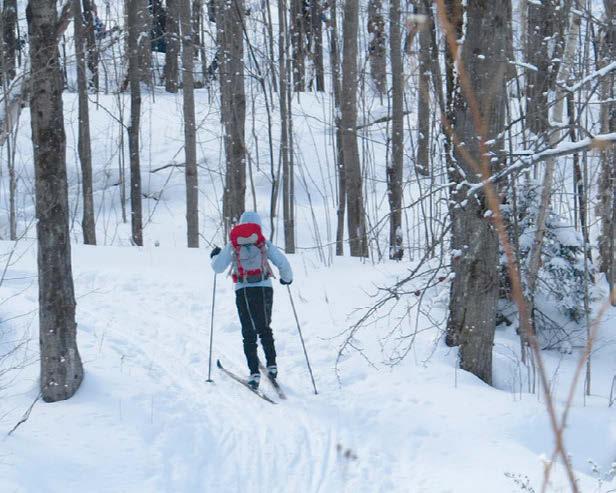
Blueberry Hill, Goshen Bolton Valley, Bolton







Rikert's 55 km of trails wind through old forests, farm fields and past Robert Frost's summer cabin. The Center offers a full service rental shop and ski school, plus fat biking! Jump on early season skiing with 5 km of snowmaking. Open 7 days a week and home to the Middlebury College Panthers.
rikertoutdoor.com • 802-443-2744
106 College Cross Road • Ripton VT

With an extensive network of winter trails throughout Mt. Peg and Mt. Tom, the Nordic Center offers more than 45 km of groomed trails for skate and classic crosscountry skiing. Snowshoers & fat bike riders may utilize the groomed ski trail areas in addition to a series of ungroomed trails for a more invigorating hike.
woodstockinn.com • 802-457-6674
14 The Green • Woodstock, VT

The BHOC trail system offers over 45km of well-marked and maintained ungroomed trails within the Moosalamoo Recreation Area for year-round outdoor adventures. No trail fees, BHOC operates on a donation basis and is a non-profit 501(c)3 company dedicated to recreational access.
blueberryhilltrails.com • 802-247-6735
1245 Goshen Ripton Rd • Goshen, VT
Trapp Family Lodge, Stowe
Hill, Stowe
Ski Area Total Terrain Machine Tracked Skating Terrain Fat Biking Town Phone Website Blueberry Hill Outdoor Center 45 km-- Goshen 802-247-6735blueberryhilltrails.com Brattleboro Outing Club 33 km33 km33 km Brattleboro 802-246-7843 brattleborooutingclub.org Grafton Trails & Outdoor Center 30 km30 km30 km Grafton 802-843-2350graftontrails.com Landgrove Inn 15 km15 km15 km Landgrove 802-824-6673landgroveinn.com Mountain Top Resort 60 km40 km40 km Chittenden 802-483-2311mountaintopresort.com Fox Run Nordic Center 11 km11 km11 km Ludlow 802-228-1396foxrunnordic.org Okemo Valley Nordic Center 22 km22km22km Okemo 802-228-1600okemo.com Prospect Mountain XC 30 km30 km30 km Woodford 802-442-2575prospectmountain.com Quechee Club 16 km16 km16 km Quechee 802-295-9356skiquechee.com Rikert Outdoor Center 55 km50 km40 km Ripton 802-443-2744rikertoutdoor.com Stratton Mountain Nordic Center 13 km10 km10 km Stratton Mountain 802-297-4567 stratton.com Viking Nordic Center 30 km26 km26 km Londonderry802-824-3933vikingnordic.com Wild Wings Ski Touring Center 25 km25 km10 km Peru 802-824-6793wildwingsski.com Woodstock Inn Nordic Center 45 km45 km45 km Woodstock 802-457-6674woodstockinn.com Snowmaking
Edson
SOUTHERN
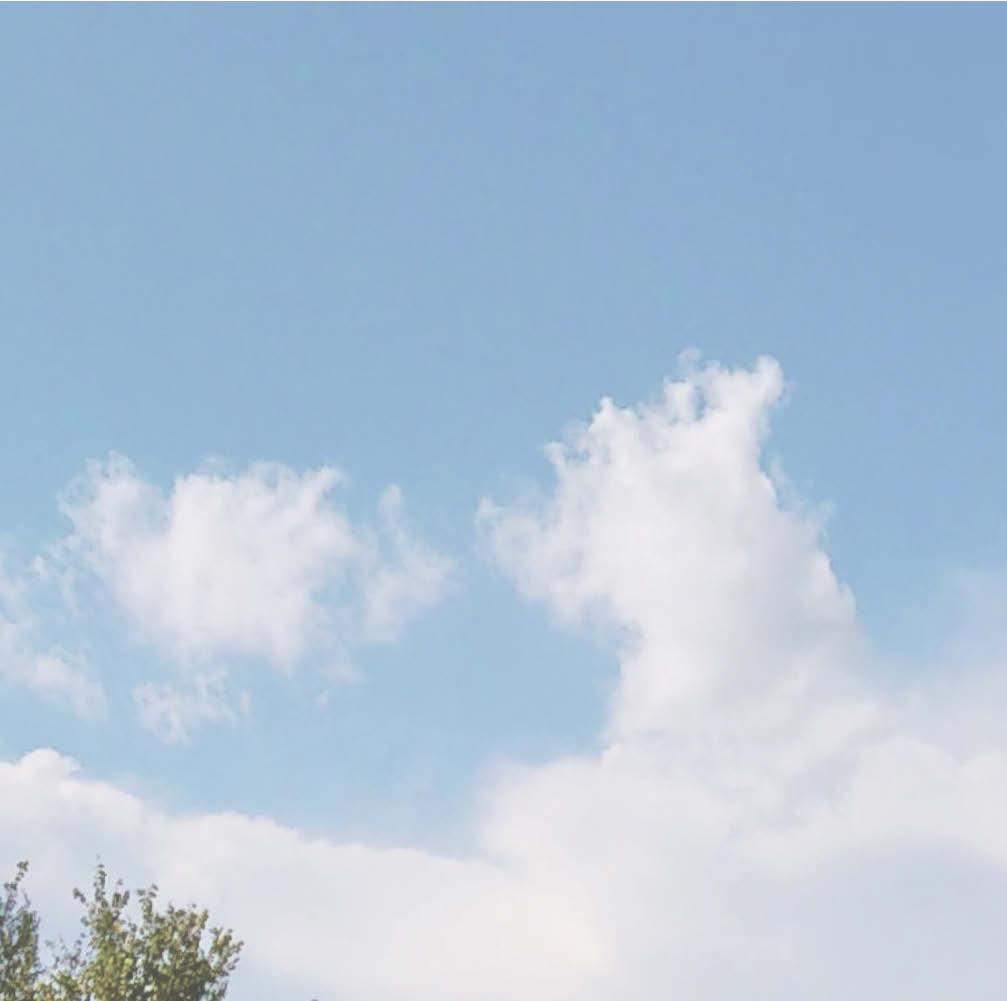


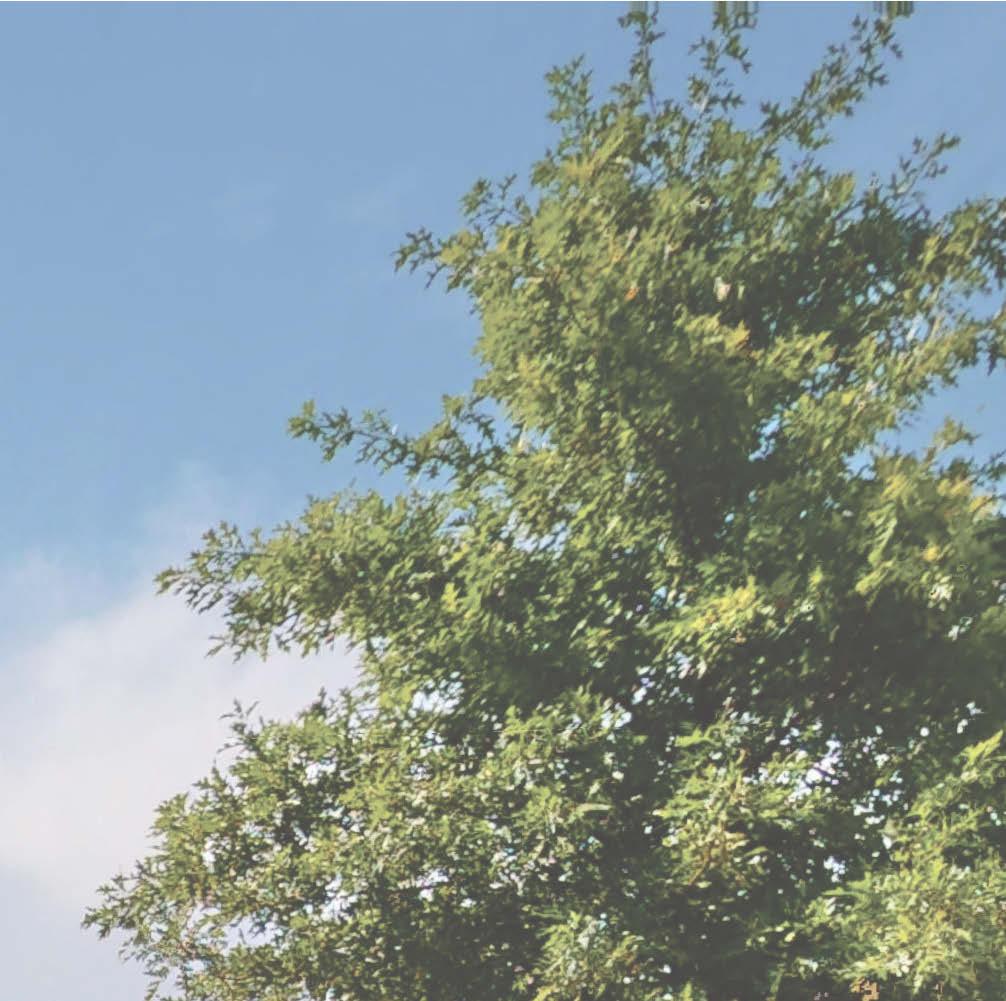


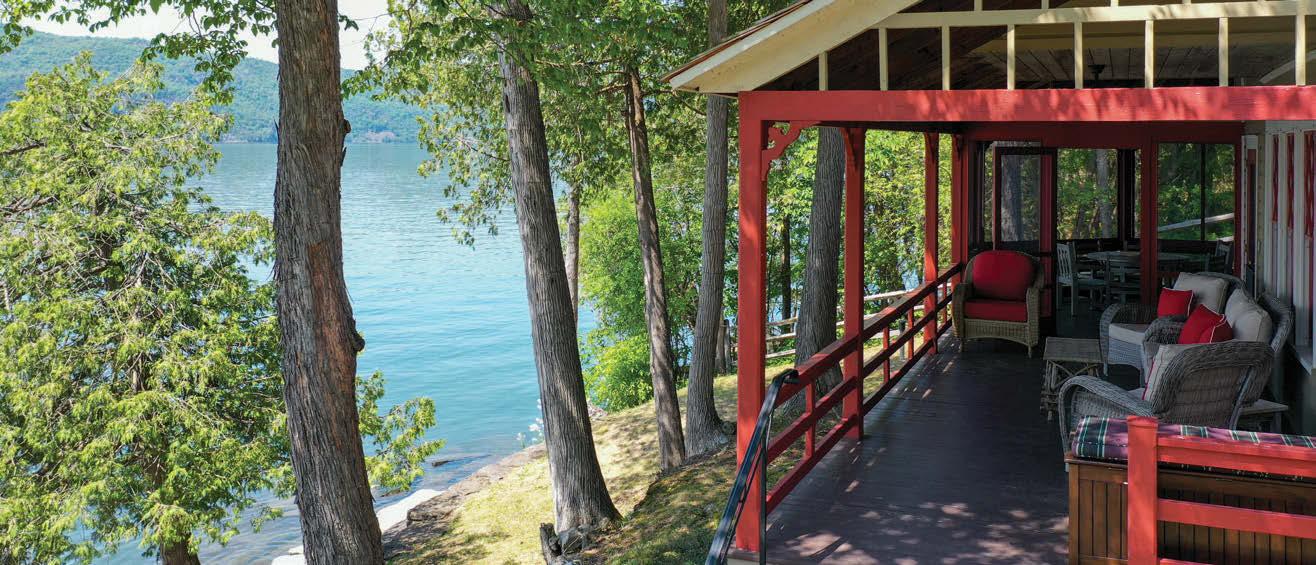


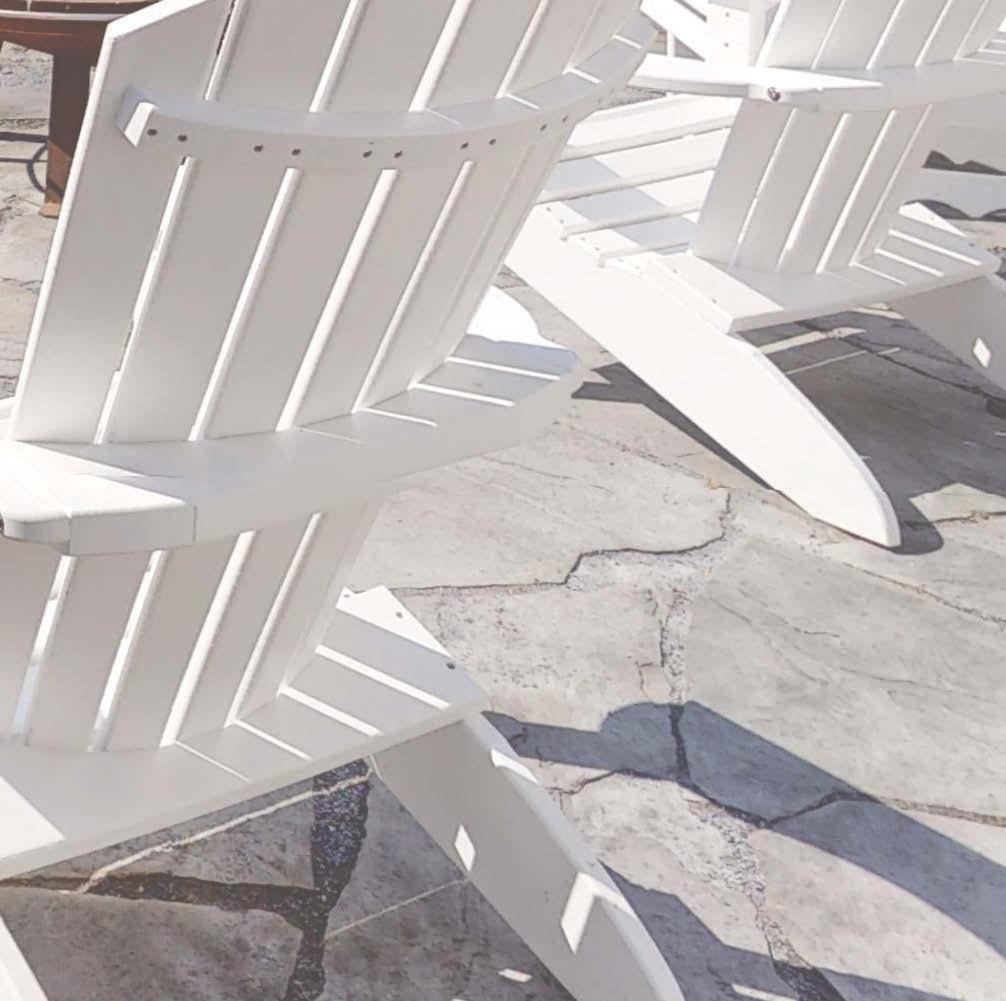

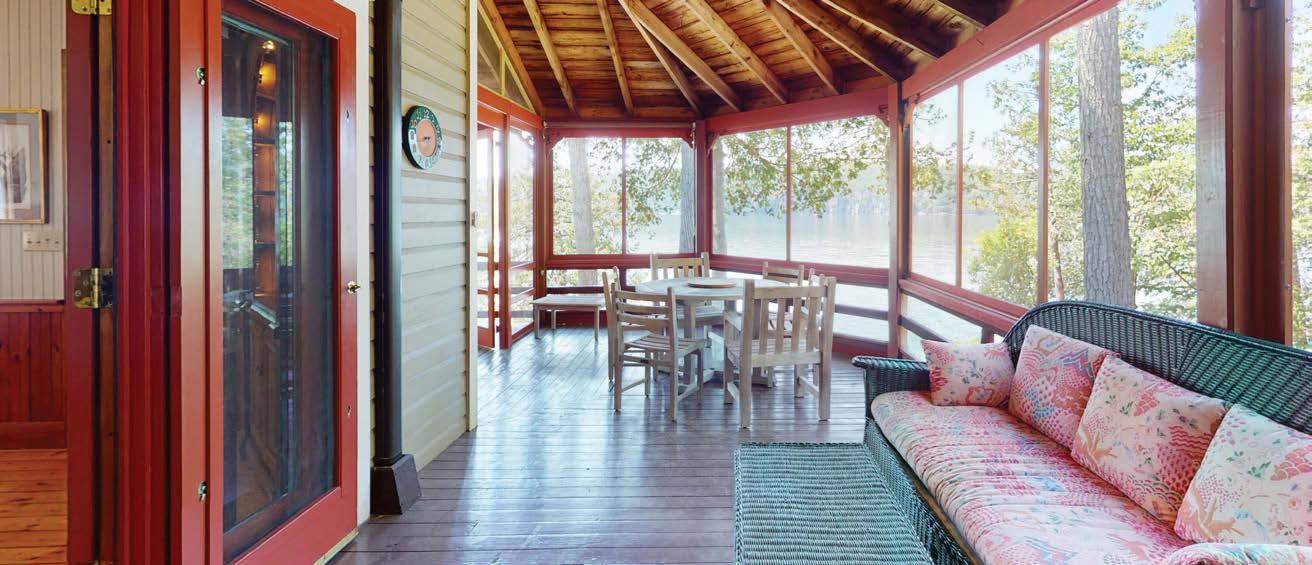

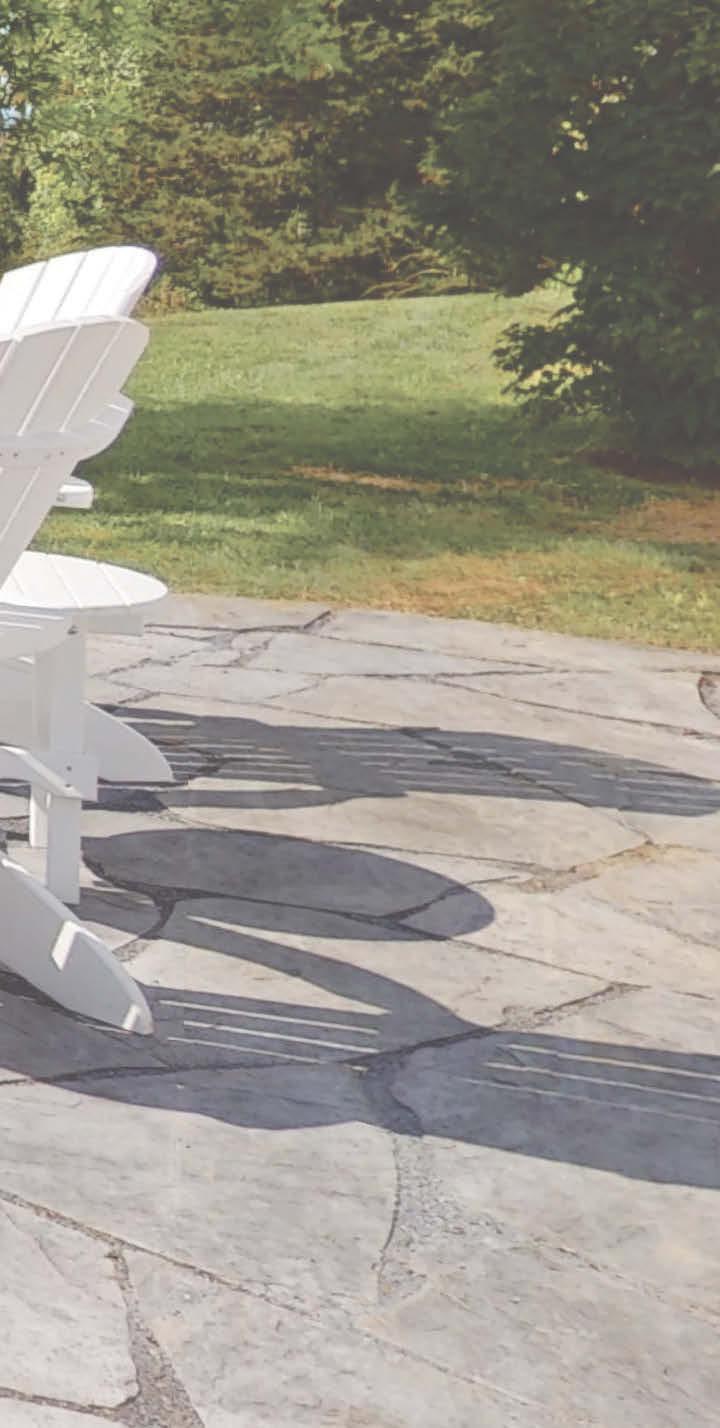

ipjrealestate.com 34 Main Street, downtown Middlebury info@ipjrealestate.com | 802.388.4242 Play hard. Rest well. You’re at home in Vermont.



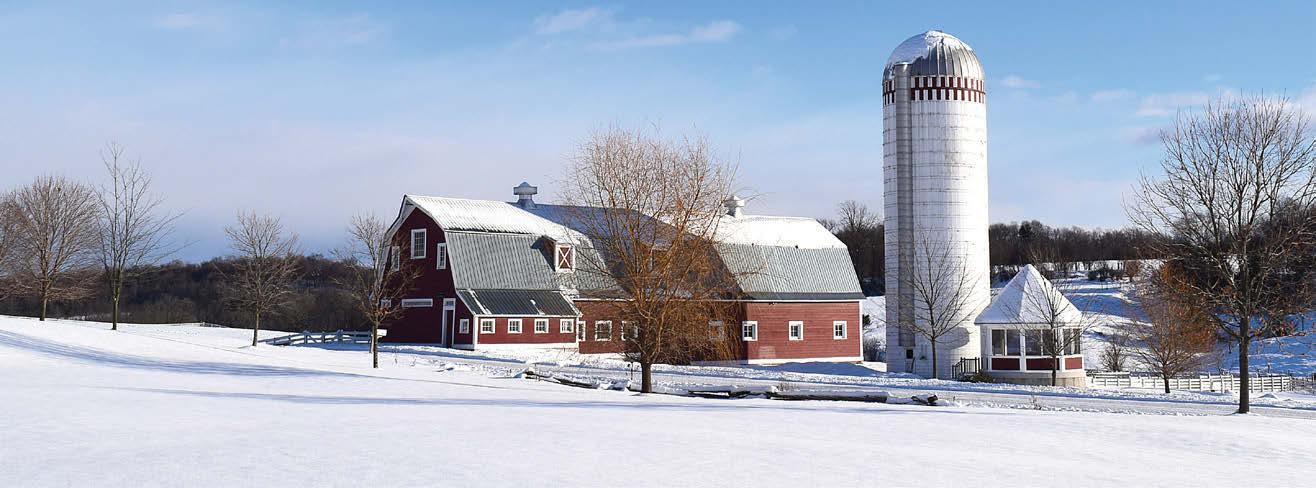




My Winter Family
What does it mean to be part of a ski town community? It means being seen and recognized. By Victoria Gaither.

The
Ialways wanted to know what it felt like to be part of a winter ski community. As a kid, I watched shows on television of good-looking people in ski outfits on the slopes or sitting in front of a fireplace, drinking cocktails and laughing. I wanted to reach into the TV and grab that feeling. It all seemed so perfect to me at that young age.
As an adult, I now live that experience through being a part of the Killington ski winter community. Living it is way, way better than any TV show ever depicted. Back then, people of color were always missing in those ski scenes. In 2024, I am happy to see a different scene play out at my ski resort: At Killington, I see Black people now in my real-life version, and Asians and Latinos and people of all colors. We may come from different places – even different worlds — but on the ski slopes or in the ski town, we have a connection.

Feeling like you are part
of a winter community means seeing people who look just like you and being connected and all that comes with that.
Usually, when I see another person of color at a ski lodge booting up, skiing, or at the bar, our eyes instantly connect, and we smile at each other.
It’s a quiet kind of happiness and joy we share instantly. It makes me want to start a conversation and hear their story of what brought them to the mountain.
My friend Brandon Pearce and I talked about what makes a winter community for him and why people of color factor in: “When I see anyone of color around me, I enjoy imagining how they got it, just like me. I want to send a hello signal even if there is no chance to talk.”
That hello signal Pearce speaks of is an automatic connection like a high-speed Internet service that says, ‘I see you.’
That’s the thing about being part of a winter community. It goes beyond just skiing for people of color—images, identities, and history factor in. It’s about being seen and feeling like you belong.
It’s a feeling that people of color give to each other, and it’s priceless. It has nothing to do with my skiing ability but goes to my sense of self-worth, a sense that I am worthy to be in that space.
One particular day in February at the K-1 bar, a group of Black skiers and snowboarders shared good times, laughs, and experiences.
We didn’t plan on that happening, but the universe had ideas for us that day.
You could feel the energy in the room, and for a moment, it felt like the spotlight was on us, but in a good way. That visual, I believe, moved the needle for everyone at the lodge that day, both Black and white.
Among the group was Anais Ovalle and her wife, Emily Black. Anais was actively looking to connect with more people who looked like her, and a mutual friend on Instagram connected us.
She is now a part of my Killington winter community. Listening to Anais talk about her love of skiing and encouraging me to keep at it was touching. With her
PERSPECTIVE vtskiandride.com Winter/Spring 2024 19
author (bottom photo, far right) grew up seeing images and ads of people enjoying après-ski. Back then, those people were mainly white. Now, that’s slowly changing.

smile, she can make anyone believe in skiing and life. Her energy is contagious. It was skiing and winter that brought her and Emily into my life. And off-season, I follow their adventures, too.
I met my best friend Nichelle Sanders at Killington. Sanders always invites people of color to her home in Mendon to share a meal and conversation. “I do it because I want people to feel seen and included,” she says. “Cooking is the oldest way to create fellowship and conversation.”
At Nichelle’s table, you will also find white people, Asian people, and Latino people. Having a diverse group brings about learning and understanding. Sprinkled into the ski conversations at dinner, we talk about life, dreams, and fears.
There is value in having people who also don’t look like you. My friend April Hemming, who is white, was one of the first people I met at Killington, and she too is a symbol of my winter community.
April and I met a few years back at Still on the Mountain and have since become friends. She said, “I love running into you at the umbrella bar to catch up and have a drink together. I love to see that you are out with friends skiing and enjoying every day. I always want to see what winter activity you are up to. You have truly become a winter staple in Killington.”
My friend Brett Harris is another staple in the Killington community. Though she lives in New Jersey, I call her the Queen of Killington because she always seems everywhere on the mountain in the winter.
By the time I arrive in Killington each season, Brett is already making her rounds with friends, and from her movements, I get to see the new and cool places to go. She is my sort of field reporter. So far, she has nailed it! You best believe me: if there is a new restaurant, bar, group, event, or happening in town, then Brett has the scoop. Without Brett, my winter community feels like skiing on a patch of dirt.
It’s not just the people on the ski slopes who make a difference. Another aspect of being a part of a winter community is simply seeing familiar faces like bartenders and servers, the greeter at your favorite restaurant, your favorite musician, the guy who tunes your skis or snowboard, and the worker from Peru who may be experiencing snow for the first time.
It’s seeing a friend in the lodge you haven’t seen since last winter and giving them a big hug.
It’s swapping ski stories of what happened to you on the slope that day, and being glad you are still alive to tell the tale.
It’s the feeling of being beaten up by a mountain but ready to return tomorrow and try again.
It’s all the little things in between, like booting up, putting your face masks on, and positioning your ski goggles so they don’t irritate your face.
Never underestimate the value of people; my community is only as good as those around me.
Unlike the movies I watched growing up, I now see Black people sitting at the lodge, skiing and riding the slopes, looking fabulous in their ski gear, laughing with a cocktail... but more importantly, I now see myself. u
SKIING AND SEEING COLOR
There are iconic vintage ski images that show up over and over on posters, apparel and framed prints: a blond, broad-shouldered ski instructor standing heroically atop a mountain ridge, a smiling brunette with a 1950s bob in stretch pants and leather boots, a bearded ski bum blasting down a tree run.
Now, thanks to the artist Lamont Joseph White, images of skiers with Afros and dark skin have been showing up on everything from skiwear to, new this season, a gondola car in Park City, Utah.
White, who was born and raised in New York City, didn’t pick up snowsports until he was in his 20s. He had graduated from New York’s Fashion Institute of Technology and began working in the fashion industry. An artist and illustrator, he has designed campaigns for Adidas, Converse, Cole Haan among other brands, and for fashion publications.
He started out learning to ski at a local New Jersey mountain but in 2000, he began flying to Park City, Utah to snowboard. Twelve years later he moved there.
In 2020, White started painting a series of Black skiers and snowboarders he called “Skiing in Color.” His website now features posters, prints and apparel that are as stylish as the classic ski images of the 1950s. “Skiing in Color is a conversation about representation and seeing people who look like you in places where they may not be expected,” White says in a video created by Vail Resorts’ Epic Pass.
Last fall, “Uplifted” a new painting by Lamont Joseph White, was used to wrap Cabin #1 on Park City’s Quicksilver Gondola, as part of his

20 Winter/Spring 2024 vtskiandride.com PERSPECTIVE
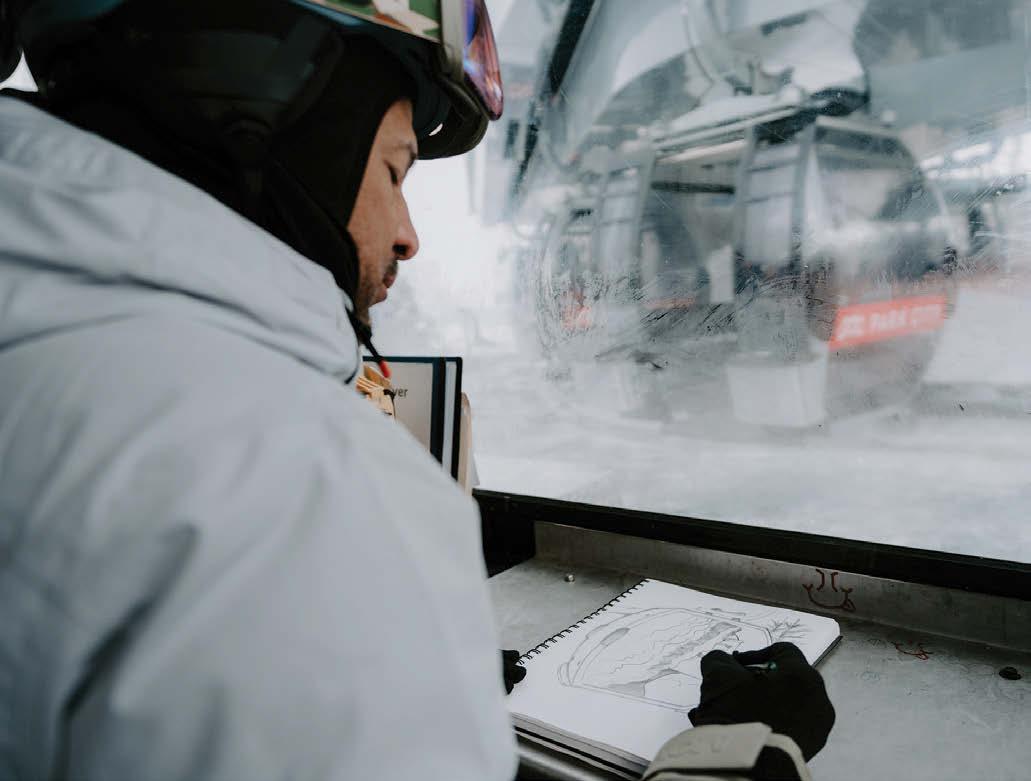
collaboration with the Vail Resorts-owned ski area that he calls home and the company’s Gondola Series (which also includes a wrapped cabin at Stowe). The Park City artwork features two prominent local Black skiers: Quincy Shannon and Jen Picarrizi. For White, it was a message of representation and inclusion. “
“My art represents a goal: the normalization of Black and Brown faces in ski and mountain spaces,” he says. White’s artwork also appears on the walls of Park City’s Miner’s Camp restaurant. It is for sale in Park City’s retail outlets as well as on his website, along with posters, giclee prints, hoodies and other apparel.

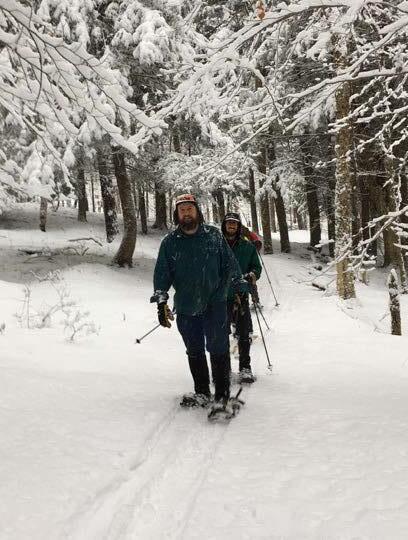
Other brands have also partnered with White to showcase Black skiers and riders. Seirus Innovation, which was founded in the 1970s by Mike Carey, a former star NFL referee and his friend Joe Edwards, has been the most prominent Black and family-owned business in the ski industry. The company has expanded from its original product, Cat Tracks (rubber soles that could be attached to ski boots for walking) to include more than 20 patents.
It now produces both regular and heated gloves, base layers, face masks and other cold-weather gear. Carey, his wife Wendy Carey (Seirus’ CFO) and daughter Danica (the chief marketing officer) now run the company and both Mike and Wendy Carey have played senior leadership roles in Ski Industries of America, the snowsports trade group. Recently, Seirus has used White’s artwork on its Dynamax and Magnemask headliners.
Krimson Klover, the women-owned apparel company has also used White’s artwork on its line of stylish, colorful baselayers . A portion of the proceeds from the line goes to Hoods in the Woods, an organization which makes snowsports accessible to underserved communities at no cost.
“ The power of what we see informs what we know to be normal. There are times when that needs to be re-evaluated when it comes to representation,” White has said about the collaboration.








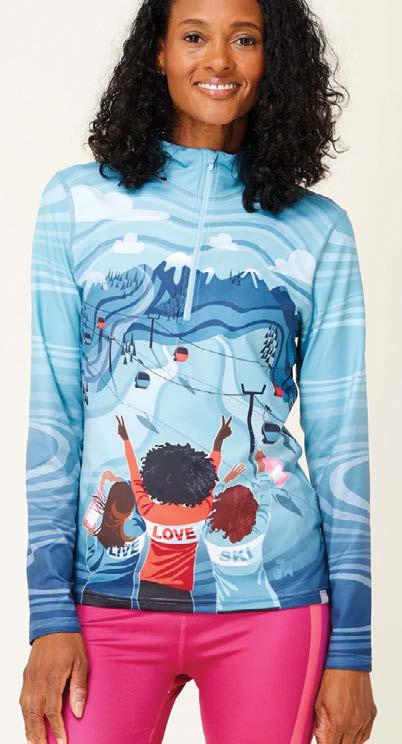
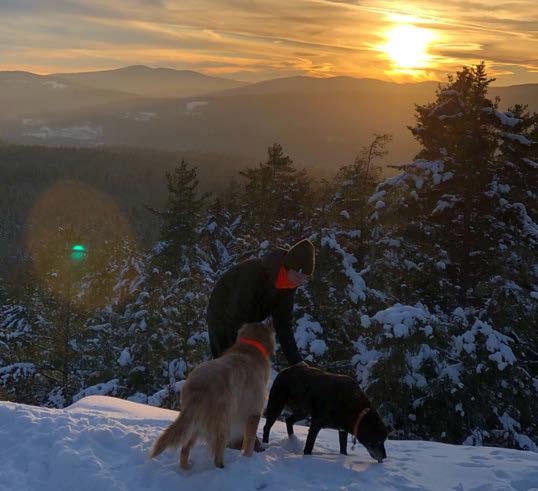



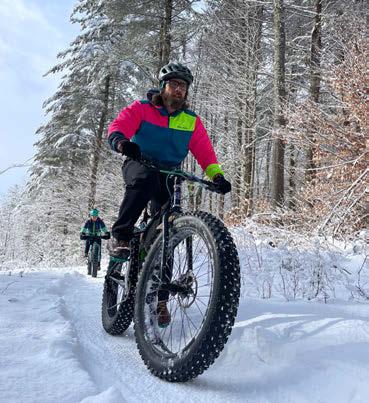









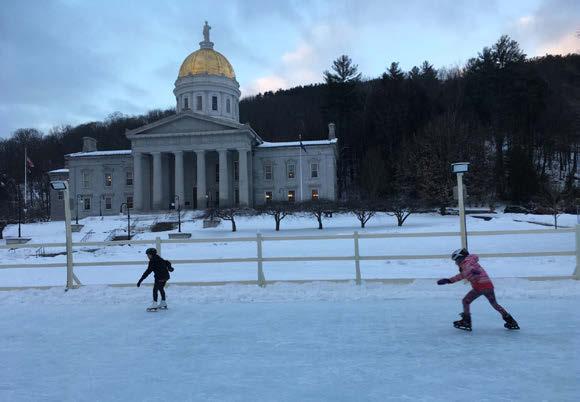


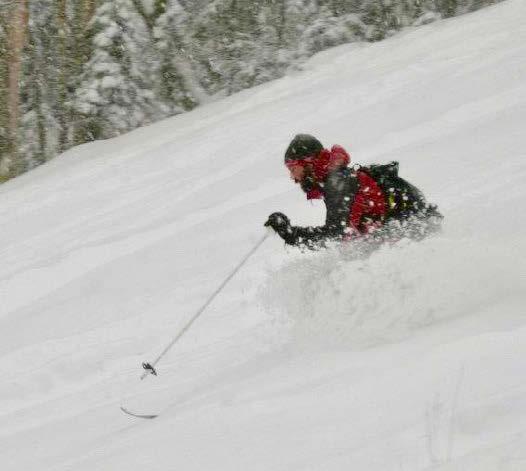
find gear, apparel and great ideas for a fun day outside @ our new shop on Main St. Montpelier, VT • onionriver.com • (802) 225-6736 Gear up & get outside!
Artist and snowboarder Lamont Joseph White’s designs showcase diversity. They now wrap a gondola in Park City and appear on Seirus’ Magnemask headliners (opposite page) and Krimson Klover’s St. Anton baselayer (above)

Ultimate Vermont Weekends
Historic inns, award-winning meals, classic Vermont villages, massages, dog sledding .... whether you are looking to spend $1500 or $500, we’ve put together three perfect winter weekend stays.
By Lisa Lynn

APRES 22 Winter/Spring 2024 vtskiandride.com
With its postcard-perfect village, decadent desserts, a spa and a room inspired by Mary Rockefeller, it’s hard not to feel supremely pampered at the historic The Woodstock Inn. Even the cross-country trails at the Woodstock Nordic Center and Mt. Tom are impeccably groomed.
Aperfect day starts with snow. Light, cold flakes fall through the night. By morning, the trees are blanketed. You rise early, down a cup of coffee and head out.


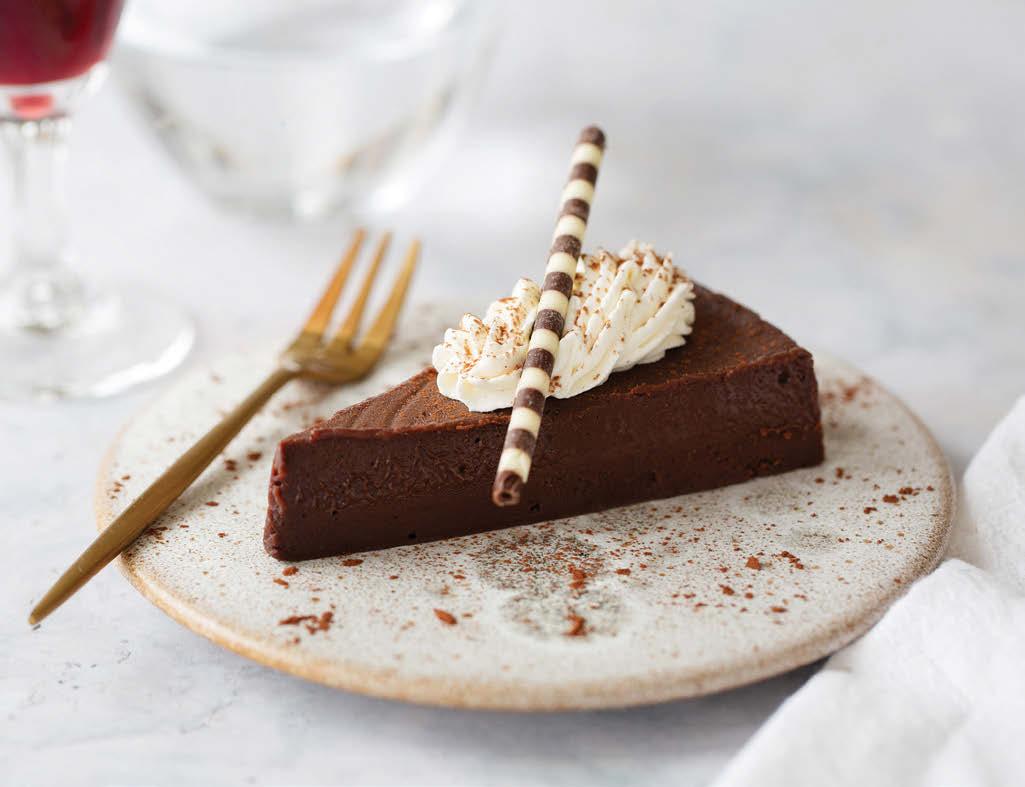

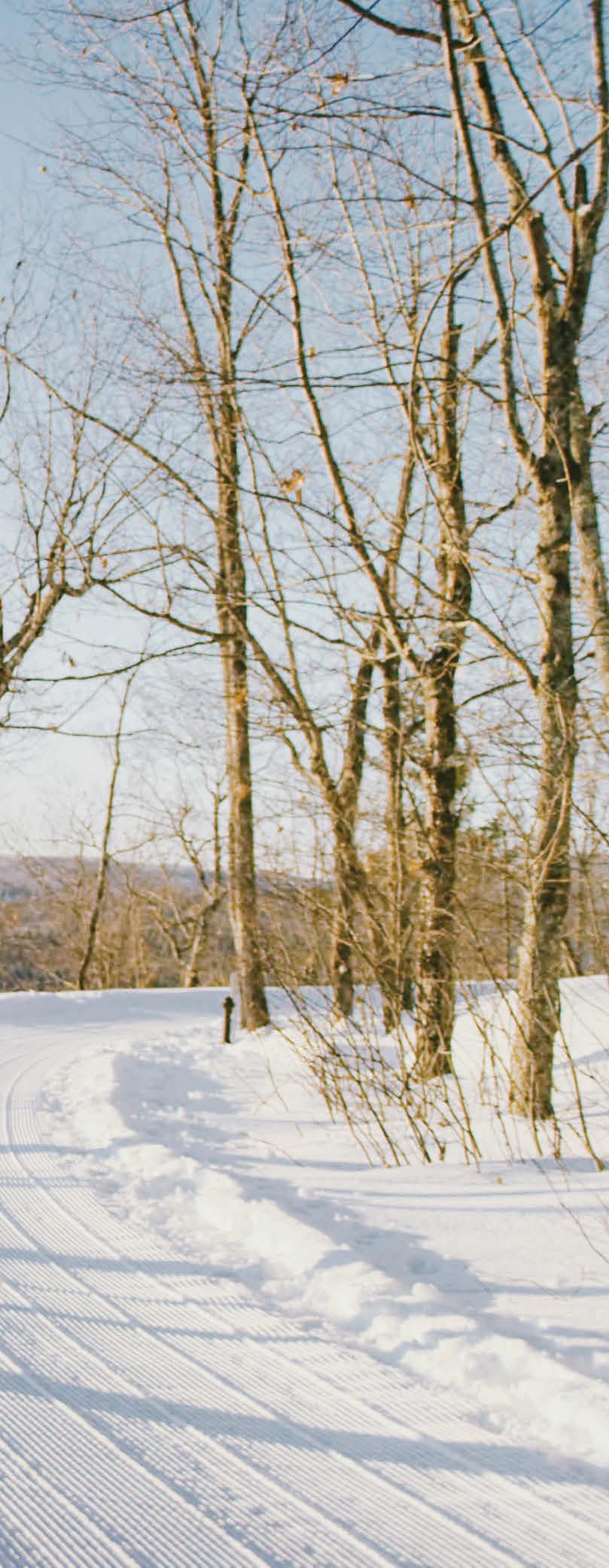
But even assuming you ski bell to bell, that’s only part of a ski day or weekend. Half of the weekend is what you do after you leave the mountain; where you eat, where you stay. We put together three classic Vermont weekends – from all-out luxe at historic inns to more budget-friendly options.
The “splurge” options below add up to around $1500 for a day of skiing, a night of lodging, massage, food and beverages for two, while the “save” options come to about $500 all inclusive.
WOODSTOCK
Every Vermont skier should make a pilgrimage to Woodstock where lift-served skiing was born. The local ski area, Saskadena Six (formerly Suicide Six), traces its heritage back to 1934 when the first rope tow in the U.S. was set up in a farmer’s field.
SPLURGE: Today, much of the town of Woodstock looks nearly the same as it might have 100 years ago. Colonial and red brick buildings line the main street and the stately The Woodstock Inn, once owned by Laurance Rockefeller, presides over the green.
The inn, its Saskadena 6 alpine ski hill and its cross country touring center are all part of the Woodstock Foundation, set up by the Rockefellers and dedicated to preserving the town’s sense of community and genteel history. Many of the inn’s rooms and suites are individually designed and reflect local history. One is patterned after Laurance Rockefeller’s study, another after his wife Mary’s bedroom.
Those suites go for upwards of $1,000 a night. But you can save on a splurge weekend by booking a two-night Sip and Stay package, which includes a room (rates start at $457 midweek) and two lift tickets to Saskadena 6. From now through the end of March, you also get a $50 credit toward food or drinks.
Open Wednesdays through Sundays until mid-March, Saskadena 6 remains one of Vermont’s hidden gems: a mid-sized mountain with few crowds, great grooming and steeps that earned the hill its original name: Suicide 6. Spend the day arcing turns before getting lunch at Perley’s Pourhouse at the base.
In the afternoon, check into the Woodstock Inn’s spa, leaving enough time to relax in the outdoor whirlpool, the eucalyptus steam room or dry-cedar sauna. Feeling decadent? Book the $300, 100-minute Signature Experience, an exfoliating scrub and hydrating body wrap followed by a fullbody massage.
After, wander into town to browse shops that range from Ferro Custom Jewelers for estate jewelry to Vermont-made Danforth Pewter. Stop in for a craft cocktail at the Au Comptoir cocktail bar but head back to The Woodstock Inn for dinner.
The inn’s executive chef, Matthew McClure is a seven-time finalist for the James Beard Foundation’s regional “Best Chef” award and works with seasonal produce (including what’s grown in the inn’s own Kelly Way gardens) to prepare dishes such as maple cured cod with eggplant caponata and couscous.
SAVE: Though much of Woodstock feels both Vermont-elegant and old-world pricey, it doesn’t have to be. Daily lift tickets at Saskadena 6 are $59 Wednesdays through Fridays and go as high as $99 on holiday weekends. For a $35 trail pass (weekends) you can also explore the more than 45 kilometers of Nordic trails that leave right from the center of town and snake through the Mt. Tom area and the Marsh Billings Rockefeller National Historic Park. On some winter weekends there are torchlit snowshoe hikes ($12) through the park with s’mores around a campfire and the park has free loaner snowshoes, on a firstcome basis. On certain winter dates, sleigh rides ($5 per person) also run through the park.
In town, some of the descendants of the Billings (for whom the park is named) still run F.H. Gillingham & Sons, a classic general store that has been in the same family since 1886 and has all sorts of memorabilia. Stop in there before heading to Worthy Kitchen for one of their renowned burgers. If you were able to get a reservation at Cloudland Farm – a working farm that serves family-style dinners on Fridays and Saturdays — the $63 three-course dinner is a treat. After, fall into a four-poster bed at The Shire, where riverfront rooms go for $135 to $232, depending on the night.
vtskiandride.com Winter/Spring 2024 23

MAD RIVER VALLEY
With Sugarbush and Mad River Glen ski areas just a few miles apart and cross-country skiing at Ole’s and Blueberry
Hill, the Mad River Valley has been a skiers paradise for more than 70 years. Waitsfield is a bustling small town, and the tiny village of Warren, with its covered bridge, classic meeting house and Colonial-era homes is as Vermont as it gets.
SPLURGE: Last week, you looked at the weather report. Snow. Lots of it. Seeing the forecast, you booked a ride for the coming weekend on the Sugarbush Sunrise Tours. The weather delivered. It’s now 6:45 a.m. and you’re one of 8 guests in the Husky snowcat that’s leaving the Lincoln Peak base area. For $125 per person (plus an Ikon pass or other lift ticket) you should be able to get five runs in untracked powder before the lifts even start to turn. The rest of the ski day is gravy.
By noon, your legs are sore so you stop for a sit-down lunch of sesame-crusted ahi tuna over artisan lettuce at Rumbles Bistro at the Lincoln Peak base ($31) before heading out for a Umiak Outfitters’s dog sled tour. The 1.5 hour tours leave from the Sugarbush golf course and cost $449 per sled (for two).
After, you are ready for the room and dinner waiting for you at the Pitcher Inn in Warren and the massage you booked at the inn’s new spa.
Innkeeper Tracy Kelly greets you with a warm smile and guides you across the street to where your massage therapist is waiting. The building has just been reopened as a spa and uses locally made natural products from Ursa Major and Lunaroma. There will be facials and other treatments available soon, but the spa just opened in early January.
You almost fall asleep on the table as massage therapist Sally Kendall expertly works the kinks out of your quads and releases cricks in your back and shoulders. At $180 for an hour it is worth every penny. The space alone is calming. The works of local artists — including Rory Jackson and Kate Gridley — hang on the walls there and in the inn, a reflection of the fact that the Pitcher Inn’s owner also owns Edgewater Galleries, based in Middlebury.
Returning to the Inn you discover with some delight that you are booked in the Ski Room, one of the inn’s dozen rooms and suites, each with a unique theme and design and ranging in price from $600 to $1,080.
The Ski Room, like much of the inn, was designed by acclaimed architect (and Warren neighbor) David Sellers. Like much of Sellers work, it is both stunning and whimsical. A fire roars in a wood stove set into a massive brick chimney. You curl up in front of it on the leather couch and admire the vintage skis propped against the wall and the leather boots near them.
Just next to the fireplace, Sellers installed an old ticket
window salvaged from Mad River Glen. It opens into a small, private kitchen. The bedroom, clad in barnboard feels as if you were in your own Ralph Lauren version of a Vermont ski cabin from the 1960s, with vintage postcards, magazines and even a pair of old ski socks hanging from the walls.
Before dinner, you head to Tracks, the Inn’s lowerlevel bar for a spot of Mad River Distillers’ whiskey and a game of shufflepuck.
Then it is upstairs to the main restaurant, 275 Main where a fireside table is set with white tablecloths. The inn’s chef, Jeff Innis, is known for using an open fire to prepare meals such as roasted vegetables and hearty game. Antique pots and pans hang from the mantel.
Tonight, you opt for a poached pear salad and a melt-in-your-mouth-tender Beef Wellington, made with local beef and plated with wild mushroom duxelles. The breads, desserts and pastries are prepared fresh each day by Jordan Holmes whose croissants and pastries are also available at the Warren Store across the street.
Sated, tired and wanting to start fresh the next day, you sink into bed as the sound of the brook that runs past the inn lulls you to sleep.
SAVE: In the morning, you make a pilgrimage to Mad River Glen where it’s still possible to purchase a weekend lift ticket for less than $100 if you buy ahead and online (or take advantage of the late-afternoon, two-hour $39 lift ticket.) Poke into the trees and you may still find some untracked stashes. For lunch, go for a grilled cheese on locally made Red Hen bread at the ski area’s General Stark’s pub. It costs $12 and local beef burgers just $16.
After a day of skiing, head to Mad River Massage to work out the sore muscles. Some therapists there have more than 20 years’ experience and an hour’s massage goes for $110. It’s a casual and warm place that also uses local Ursa Major and other brands. Then, go for a warm pretzel at Lawson’s Finest Liquids’ brewpub in Waitsfield and one of their award-winning brews, such as Maple Tripple Ale.
For dinner, don’t miss the original American Flatbread pizza, located in the old farmhouse at Lareau Farm, for creative flatbreads topped with farm-fresh local produce, meats and cheeses.
From there, It’s a short hop across Route 100 to the new inn at Mad Bush Falls, Rider’s Outpost. The simple, stylish rooms there start at $139 midweek. There’s an option to add on a $99 daily gear package that lets you demo a full set-up of ski, snowboard, XC ski, or fat bike gear from the on-site shop run by Outdoor Gear Exchange and swap them out each day. A $39 add-on package gets you a spot at the Savu Sauna communal hour and, if you are brave, a plunge in the Mad Bush falls that the inn is named for. After, your sauna package includes a pick of any appetizer on the inn’s Après-Piste menu.

One of 12 unique rooms at The Pitcher Inn, The Ski Room, above, is loaded with ski memorabilia from the 1960s. Ensure a good night’s sleep and work up an appetite for a wood-fired flatbread at American Flatbread’s
24 Winter/Spring 2024 vtskiandride.com APRES
Lareau Farm restaurant (far right) by booking a Sunrise Tour on a snowcat for first tracks at Sugarbush (right).
Courtesy photos.
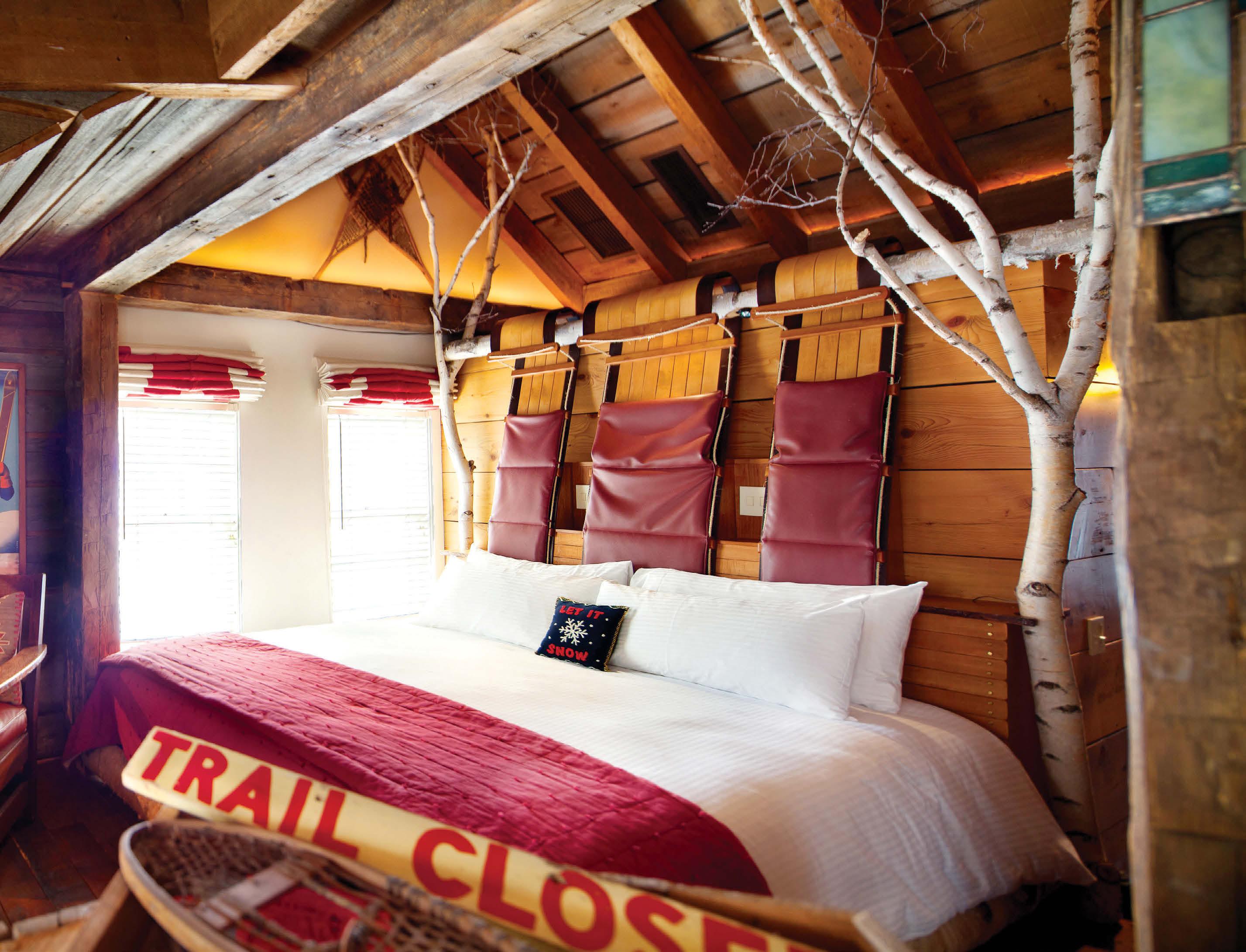


vtskiandride.com Winter/Spring 2024 25

WILMINGTON VALLEY
In southern Vermont, this scenic valley stretches from the historic town of Wilmington north (along Route 100) eight miles to West Dover. Historically, several ski areas operated in this area but today only Mount Snow and the private
Hermitage Club have lift-served skiing. Mount Snow is a sure-fire scene come spring, especially at its Carinthia terrain parks where some of the nation’s best freeskiers and riders throw huge airs.
SPLURGE: Once known as Haystack Mountain, the Hermitage Club is now a members-only ski resort but if you can secure an invite, its tony, wood-paneled base lodge and crowd-free ski trails are a luxury. Assuming you have an Epic Pass, ski Mount Snow’s 85 trails, 83% of which are covered by snowmaking.
For bit of luxury, check into the Hermitage Inn. Once part of the Hermitage Club and then abandoned, the inn and its 112 acres were bought by a couple from Boston, Mary Lou Ricci and Tim Hall, who set out to renovate the property. They transformed the interiors with an eye toward quiet luxury. The inn reopened in late 2021. Many of the rooms in three buildings (the historic inn, the Carriage House and Coldbrook building) have fireplaces and start at around $500 a night. There’s also a small spa area where you can book a massage ($165 for an hour) with an add on of CBD oil ($50) to relieve your sore muscles.
One of the Hermitage Club’s most unique features? Refurbished gondola cars for private dining outdoors. Set just off the inn, each gondola is heated and has been refitted with leather banquettes, wood tables, and a chandelier. After skiing, reserve one for an après-ski alpine fondue experience ($75 per person) that comes with a glass of Franciacorta sparking wine. Executive chef Chris Bonnivier has also created a prix-fixe ($150 person) five-course dinner that is served in the gondolas. Inspired by Italy’s Piedmont cuisine, it starts with fondue and ends with decadent desserts.
The wine list has earned the restaurant awards from Wine Spectator. If you are in the mood to celebrate you will find an extensive list of exceptional sparkling wines.
The valley also has a handful of other posh inns such as the White House, a stately historic mansion once owned by a lumber baron with views that stretch out across the valley, an excellent Italian restaurant and rooms that start at around $283 a night.
SAVE: Start the day at Dot’s of Dover for apple cinnamon French toast with local maple syrup. Then head to Mount Snow. If you don’t have an Epic Pass, be prepared to pay $135 or more (buying online, ahead of time) for a Mount Snow lift ticket. Ski the mountain but don’t miss Bruce


Jacques hilarious concerts at Cuzzins (3:30 to 7:00 pm on most Saturdays) at the base.
If you have backcountry gear and the snowpack is solid, explore the new glades that Southern Vermont Trails Association has been developing in the Stratton Town Forest or that the Dutch Hill Alliance of Skiers and Hikers has maintained on the abandoned trails of the old Dutch Hill ski area in Readsboro.
PizzaPalooza and Beer Naked Brewery sit atop another former ski area, Hogback Mountain, on Route 9 in Marlboro where you can drive up to the summit, ski down, and then skin back up for a brew and a slice. For more local brews, try Snow Republic Brewery’s or head to Wilmington to Valley Craft Ales.
Just down the street, Alpenglow Bistro serves excellent Alpine fare, including fondue. From there, walk to The Vermont House, a lovely Colonial, recently refurbished whose rooms start at $128 midweek. u
The Hermitage Inn (top) serves fondue in reburbished and heated gondola cars (below). At Mount Snow, spring brings out freeskiers who put on a show at Carinthia’s terrain parks.
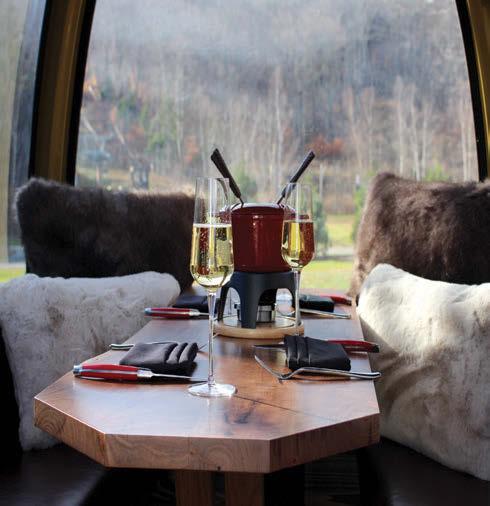
26 Winter/Spring 2024 vtskiandride.com APRES
Courtesy photos.




Your Marvin source for over 30 years Visit our showrooms in Williston, VT & West Lebanon, NH wdbrownell.com DREAMING OF A WINTER WONDERLAND? 802.521.7101 eldarchitecture.com Stowe,Vermont
Dream Home

A Chicago transplant knew what he wanted when he set out to build a home in
28 Winter/Spring 2024 vtskiandride.com
A huge wall of windows, an open-framed porch roof and the warm tones of the yakisugi (Japanese charred wood ) siding marry the home to the landscape beyond. The design riffed off a classic barn shape for the main living spaces with “woodshed” wings that house four bedrooms and ensuite baths.
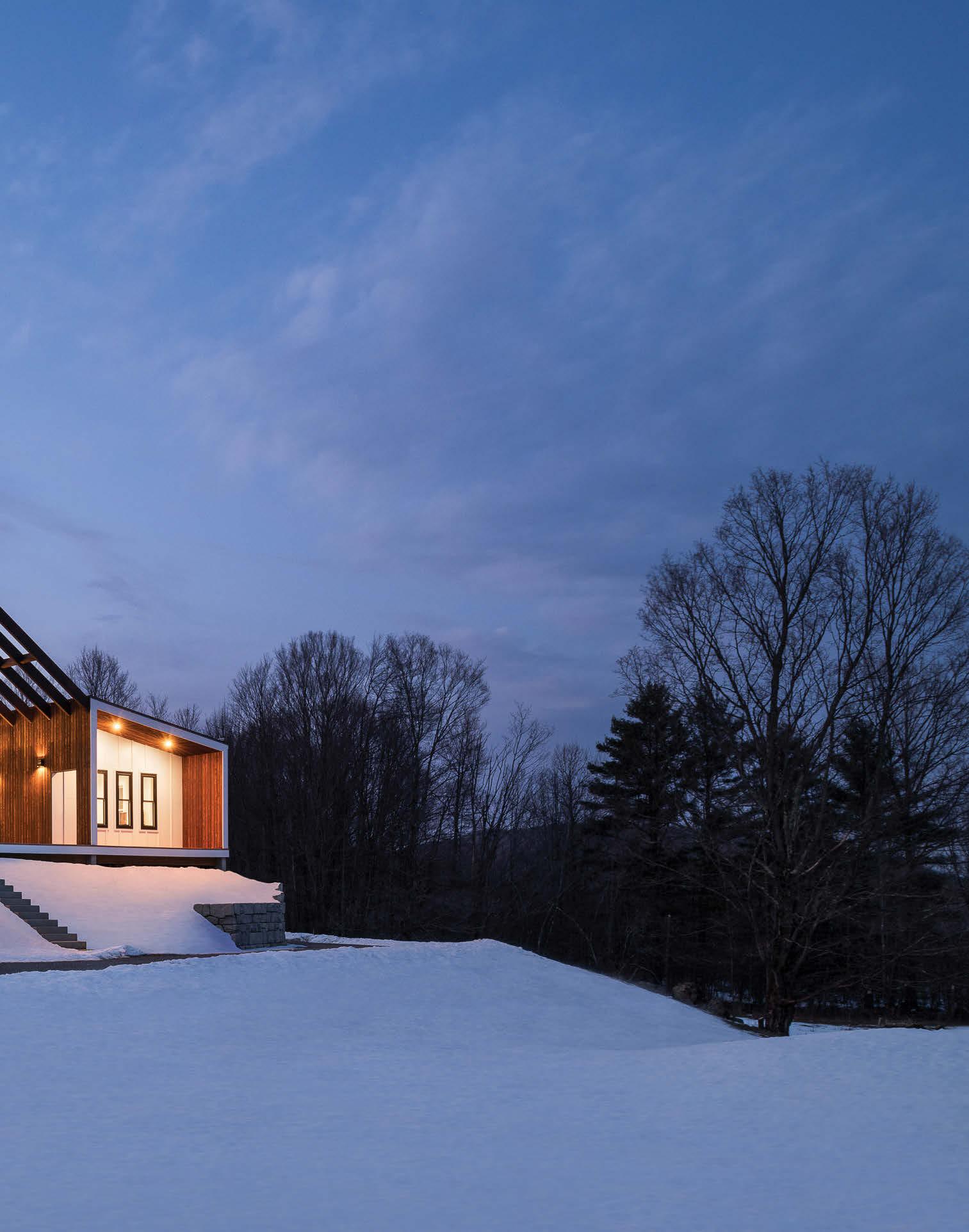
a view to design
Vermont. With help from G4 Designs, he created a modern, minimalistic space.
BY LISA LYNN | PHOTOS BY RYAN BENT
Winter 2024 29
vtskiandride.com


West of Mount Mansfield,
about halfway between Smugglers’ Notch Resort and Burlington, a dirt road runs along a hilltop ridge. Farmhouses and stone walls line the road. Snow-covered fields stretch on either side.
A classic red barn and horse pasture mark where the driveway to the property starts. The drive snakes past a wetland and then you see it: A modern, white structure on the hillside seems to hover above the snowy landscape.
“Coming to Vermont and being in this wintery place, I wanted a home that would be modern but fit into the vernacular,” says the owner, a professor at the University of Vermont. “I loved how the roof line of the house echoes the roof line of the barn by the road,” he says.
Gary and Melanie (they asked that only their first names be used) moved to Vermont from Chicago in 2018. They had been looking for homes that would be close enough to Burlington so Gary could be on call at the hospital but had some land. After years of city living, they wanted a quiet country setting. “We looked a lot of homes and then we found this piece of land and decided to build,” Gary explains. A former farm, it had 60 acres of fields, wetlands and woods.
“The owner really didn’t want to see it subdivided and we were happy to have the acreage,” says Melanie. “Though because of the wetlands, we were somewhat limited in where we could site the house,” Gary notes.
Their new home, completed in 2020 by Blackrock Construction, is shored up against the hillside, allowing the driveway to remain largely out of sight as it wraps below the porch and back to a garage and basement.
The raised home site and porch offer magnificent views of the fields and hills beyond. Those views were things the couple wanted to maximize. They did so with a wall of windows that makes up most of the front of the home.
Marrying Tastes
“This house is all Gary,” says Melanie, waving to the vaulted ceiling of the home as I step inside. It is simple, open and modern. The wall of windows, the large porch and open-framed roof above it give the feeling of living outdoors. The main living area is vaulted, with a kitchen off to one side, a library at the back with a loft above, and living quarters in the wings.
“I have no experience in architecture or building but I had an idea of what I wanted: a clean, simple aesthetic,” Gary says. “I am a fan of the Scandinavian style of architecture and I also wanted a wrapped porch.”
While the couple worked with G4 Design’s Steve Guild and Bobby Harriman out of Burlington, much of the concept for the home was Gary’s. “I wanted to share my ideas, so I started making these 3D paper models and sent G4 pictures and mock-ups. I also found this traditional Japanese burnt or charred cypress wood, yakisugi from Nakamoto Forestry, that we wanted to use for the porch siding.” The charring process, he notes, helps preserve the wood.
Harriman describes the collaboration: “We started out with
30 Winter/Spring 2024 vtskiandride.com
 Gary and Melanie (pictured at left) did much of the design for the home themselves. Each bathroom features a different, bold schematic using tiles sourced through Floor Coverings International. One of the owners’ bathrooms has black walls tiles (Emser Alchemy Silver), while a guest bathroom features Glazzio’s Magical Forest Periwinkle Dust subway tile (opposite, top).
Photos opposite by Lisa Lynn
Gary and Melanie (pictured at left) did much of the design for the home themselves. Each bathroom features a different, bold schematic using tiles sourced through Floor Coverings International. One of the owners’ bathrooms has black walls tiles (Emser Alchemy Silver), while a guest bathroom features Glazzio’s Magical Forest Periwinkle Dust subway tile (opposite, top).
Photos opposite by Lisa Lynn

 The main living area (above) is open with antique brass doors from the Hotel Saranac closing off a cozy library. The couple found the doors at Architectural Salvage in Essex Junction and had them refinished by Champlain Metals. The kitchen (opposite page, top) opens onto the living room. Its pergola-like crossbeams set it apart and echo the lines of the porch and the facade of windows (opposite bottom). Porcelain wall tiles —Porcelanosa Statuario— provide a light, airy feel to one of the owners’ bathrooms (below).
The main living area (above) is open with antique brass doors from the Hotel Saranac closing off a cozy library. The couple found the doors at Architectural Salvage in Essex Junction and had them refinished by Champlain Metals. The kitchen (opposite page, top) opens onto the living room. Its pergola-like crossbeams set it apart and echo the lines of the porch and the facade of windows (opposite bottom). Porcelain wall tiles —Porcelanosa Statuario— provide a light, airy feel to one of the owners’ bathrooms (below).
basic shapes – a classic gable or A-frame but then made probably 20 different versions.” Using 3D modeling, G4 did a series of renderings that helped bring Gary’s vision to life. Harriman continues: “The main portion of the house is not unlike a barn. You see the classic gable, and its cathedral ceiling where the engineered timber beams are visible.”
He adds: “Gary and Melanie wanted to have the living spaces separate from the central area. Often, barns would have woodsheds added on, so we used those ‘woodshed wings’ to house the bedrooms.”
In one wing are two guest suites and a laundry room. In the other, the owners’ his-and-her suites: Gary’s with a bathroom tiled all in black, Melanie’s in white. “We have very different styles,” Melanie notes. Antique desks, a vintage wood radio and beds with ornate headboards reflect her love for browsing salvage and antique stores. Gary’s taste tends more toward minimalist modern.
A centerpiece of the home is the sliding brass doors to the library. “We found these at a salvage shop in Essex,” Gary notes. “They were from the Hotel Saranac,” he says referring to the grand hotel that was built in the Adirondacks in the Roaring Twenties.
Builder Blackrock Construction mounted the salvaged doors on a sliding track. Rolled open, they reveal a small library. There, a leather couch sits against a wall painted in a rich burgundy. White bookcases house the couple’s collection and a coffered ceiling, painted a cool blue-gray, gives a sense of calm. The library complements the great room beyond: a cozy place to curl up in the quiet with a window looking onto a back porch, with woods and stone walls stretching beyond.
As Gary shows me the porch he notes, “One night I awoke and thought I heard sirens—a sound I was used to in Chicago— then I realized we had a whole pack of coyotes on the back porch.”
Secret Spaces
In addition to the library and bedrooms, there are other spaces that feel tucked away, secret hideouts of sorts that the couple says their two cats love to explore. Above the library is a loft that adds 471 sq. ft. to the 3,485 sq. ft. first floor living areas. An intricate, metal circular staircase winds up to it. “We wanted something that echoed the sliding metal doors but didn’t take up too much space,” sates Harriman.
“Our original plan was to have a pool table or something like that in the loft,” notes Gary. However, when faced with the prospect of getting a heavy pool table up to the loft, the couple decided to relinquish that area, for now, to their cats.
The kitchen, though opening onto the main living area, also feels apart, thanks to the non-structural crossbeam that houses spotlights. The effect is that of a pergola, that, like the open roof on the porch, heightens the feeling of living outdoors. Tucked in off the kitchen, next to the front guest bedroom, is a large laundry and mud room. On the other side, tucked behind it, a small pantry.
What is hidden to most eyes is the vast space below the main living area – a basement that extends the entire footprint of the home and opens onto the three-car garage.
While much of that remains unfinished, that may be where the pool table or ping-pong table eventually go.
It’s a design that remains flexible and open to possibilities, awaiting the next vision. n


vtskiandride.com Winter/Spring 2024 33

Return of the Natives
34 Winter/Spring 2024 vtskiandride.com
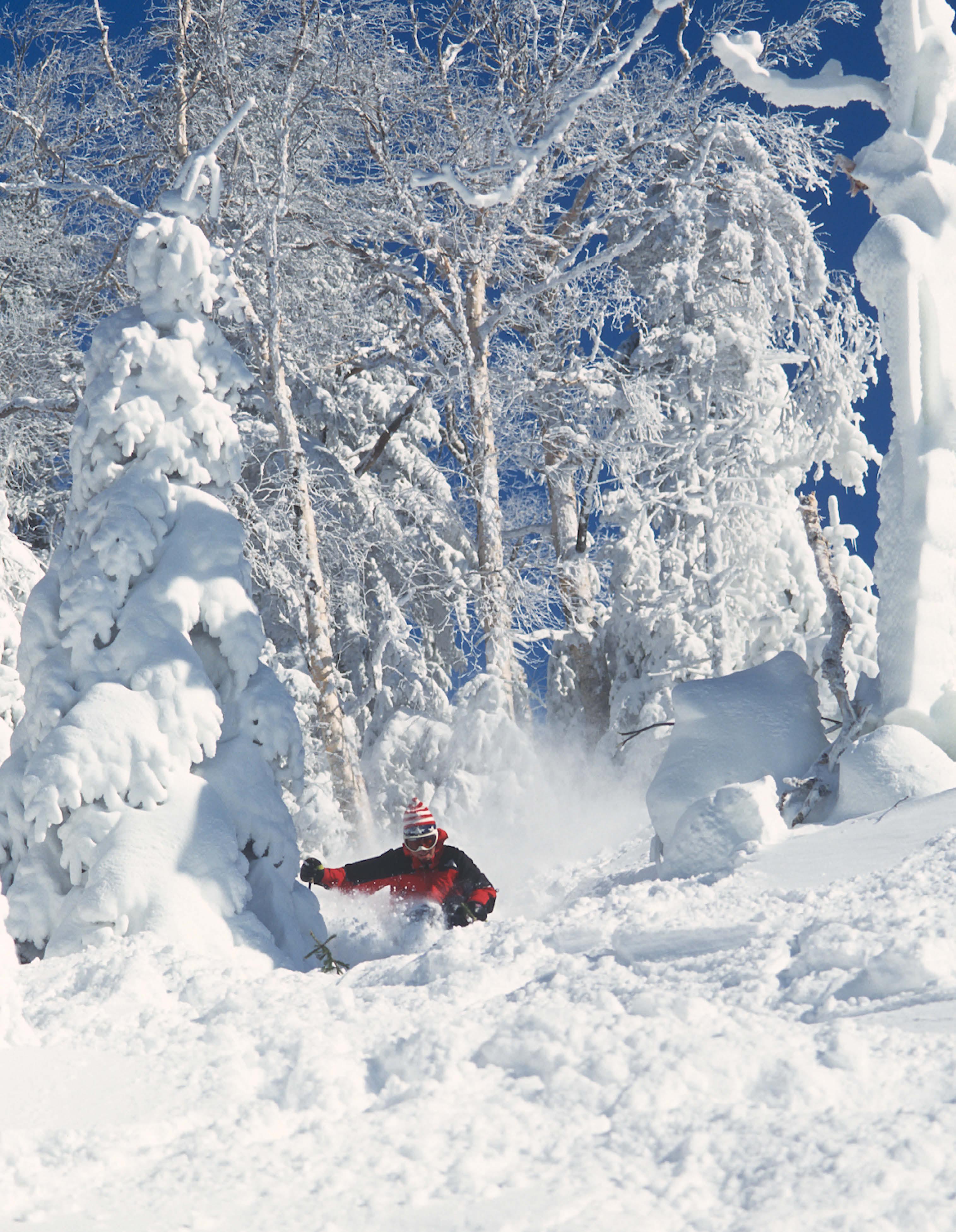
In the 1990s, Bolton Valley Resort launched a family of skiers who helped bring “extreme skiing” to movie screens around the world. Now, the DesLauriers are back.
By Lisa Lynn
vtskiandride.com Winter 2024 35
Adam DesLauriers (at left in January 2024) learned to ski at the mountain his father developed, Bolton Valley. DesLauriers, at right skiing Spillway at Bolton in the 1990s, was coached by his brother Eric, one of the X-Team coaches. Today, Eric is back as Operations Director and Adam has helped develop a backcountry program at Bolton. Photo left by Jen Bennet, right by Hank DeVre.
One day in early January 2024, Dean Decas and Adam DesLauriers were carving up the backcountry at Bolton Valley. The two skiers slid quietly through stands of birch and brushed under snow-laden hemlock. They nosed into narrow powder-filled ravines that slice the Green Mountain’s granite ribs. Each skier had a signature style – a style familiar to anyone who has seen them in ski films.
In past decades, at this time of year you might have found Dean Decas guiding in Chamonix, teaching clients to navigate steep couloirs. Adam DesLauriers might have been arcing down a big face in Alaska’s Chugach, either skiing for the camera or filming one of his brothers, Eric or Rob, doing so.
But there was something about Bolton Valley that made them come back. “Skiing Bolton is like going back in time,” Decas said in an interview this January. “The terrain really hasn’t changed much — it’s one of the few places in the Vermont backcountry where you will not see a lot of other people — and the mountain still has that down-home feel. It’s also a place you can let your kids roam free without worrying.”
Dean and Adam guide now at Bolton Valley. But that ski day in January wasn’t about work. It was about freeskiing. It was about ripping the same terrain that helped form some of North America’s best all-mountain skiers; people who made many of the ski films of the 1990s that defined “extreme skiing.”
Between them, Adam and his brothers Eric and Rob —a year
apart and decade older than Adam — have appeared in dozens of ski films. Take Scott Gaffney’s 1997 Promised Land, a film he made for the North Face and whose outtakes he wove into his own director’s cut (produced by Eric and Rob DesLauriers) called Breathe. The footage shows segments of Rob skiing in Nepal, Adam in the Chugach. Decas is there. So are former Vermonters Alan Riley of Bolton, Kasha Rigby of Stowe, Matty Herriger of Killington — much of it filmed skiing in Chamonix. Legends such as Scot Schmidt and Chris Davenport star in the film as well.
Watch those films today with the knowledge that this was before fat skis, helmets or modern avy gear and it gives new appreciation for how a few kids from Vermont ended up defining an era in skiing.
Now, the DesLauriers are back and redefining the Northeast’s all-mountain skiing.
The Proving Ground
In 1966, Ralph DesLauriers founded Bolton Valley Resort. He started by cutting ski trails high in the Green Mountains on some of the 8,000 acres he had originally purchased as timber land. Four years earlier, his family farm in Richmond had been bifurcated by the new highway, I-89, which made Burlington just a 30-minute drive away. Ralph was in his 20s and had two young sons, Eric and Rob. Building a ski area at 2,000 feet of elevation in Bolton Valley seemed like a good idea at the time.
Ralph made it his mission to make the ski area accessible
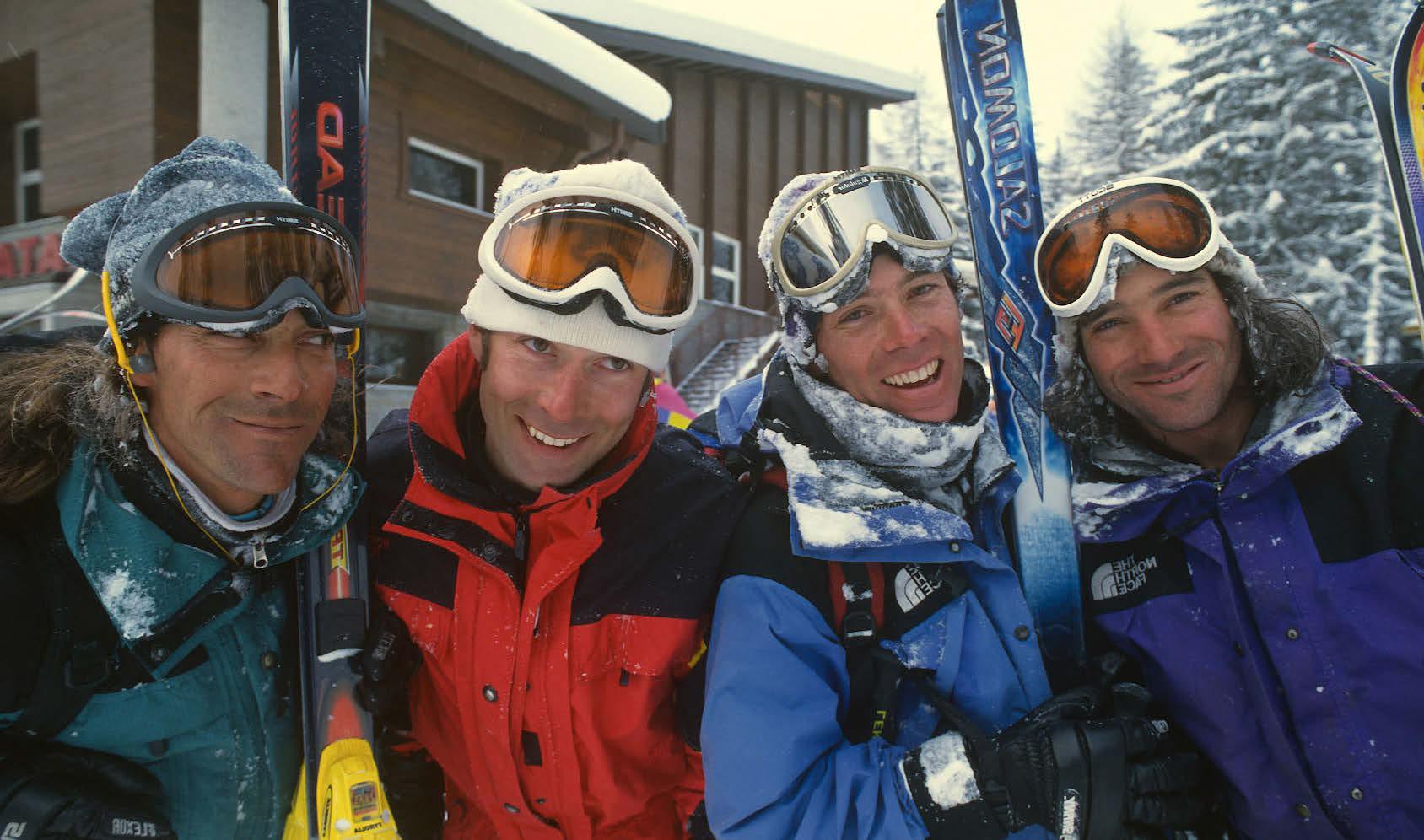

36 Winter/Spring 2024 vtskiandride.com
In the 1990s, skiers from Vermont were the stars of many of the Warren Miller and other ski films. In 1996 (left to right), Dean Decas, Eric and Rob DesLauriers and Matt Herriger on set in Chamonix, straight skis in hand. At right, younger brother Adam charging the glades back home in Bolton Valley in the ‘90s. Photos by Hank DeVre
to as many children from around the region as he could. After school, kids would bus up the long mountain road from around Chittenden County.
With his own children, Ralph took a somewhat free-range approach to on-mountain parenting.
“I remember back when Eric and Rob were about 11 and 10 years old and ski patrol coming into my office and saying: ‘We got a problem,’” Ralph, the patriarch remembers in an episode of “Story Time With Ralph,” a fascinating series of video interviews posted to Bolton’s website.
“I said ‘What’s the problem?’” Ralph continues.
“Back then, ski patrol and the state insisted everyone stay on trails.
“Ski patrol said ‘It’s Eric and Rob, they’re skiing in the trees.’
“I said, ‘Well, just pull their passes’” Ralph recalls.
“So ski patrol then says ‘That’s the problem, we can’t catch them.’ After that, they never tried again.”
Eric was the eldest of the miscreants. “Back then, you have to realize there were only five kids living in Bolton Valley,” says Eric. The woods, as Ralph, now 88, remembers (“and I’m as old as the dickens,” he admits), had never been logged. The century-old (and older) trees had grown tall, creating a canopy that blocked the sun from feeding the puckerbrush that covers so much of Vermont’s understory. The terrain was the boys’ year-round, nearly private playground. “We’d get out of school at about 2:30 and in about an hour and a half, we could easily get 10 runs in,” Eric remembers.
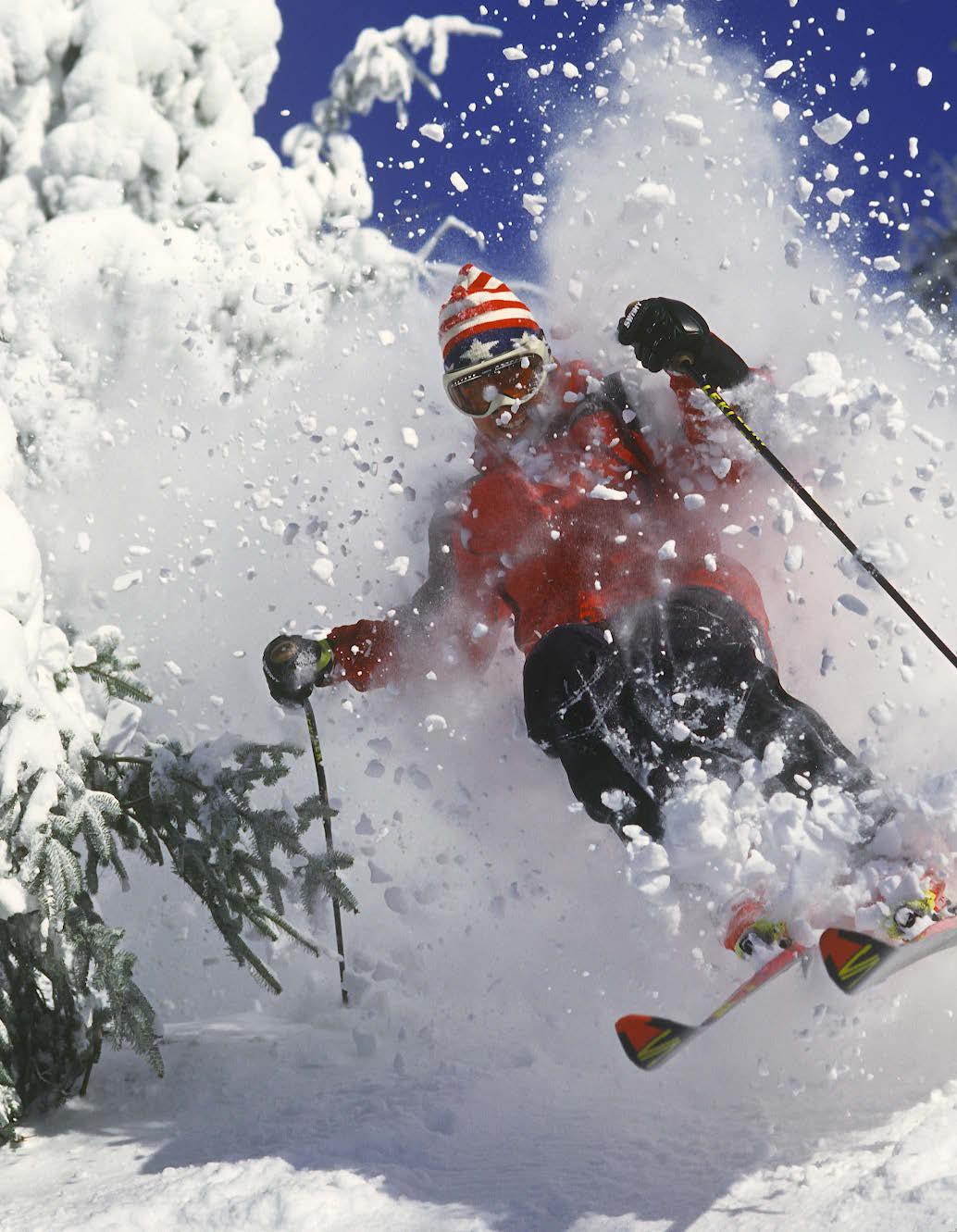
“We laughed our beans out.”
At the time, the proving ground was if you could ski off Big Rock, a boulder off Showoff under what is now the Vista lift. “That thing was huge!” Eric recalls. “At the time, my uncle Chuck DesLauriers had skied it. A bunch of other guys who were a little older than us like Tom Day had skied it by the time that Rob and I got up the courage to.”
Eric remembers the first time he dropped Big Rock. “I’ll never forget what it felt like to be standing there looking at a boulder that’s twice as tall as we were and then hiking up, heart beating, to scope it out. You had to hit that landing just at the right speed. If you went too far, it’s flat and if you didn’t go far enough it was flat. The first time I think I just barely made it. The second time, I hit the flats and I landed so hard my head went right between my knees. I was lucky my knees missed my face. To this day, when I’m coaching kids I say: ‘If it looks like you are going to land flat, don’t forget to have your legs far enough apart so your head can go between your knees.’”
Soon the brothers and their friends were jumping Big Rock five across at once.
“There’s nothing really like jumping big rocks that shoot you right into the air. A lot of big mountain cliffs are down-takeoffs so they look quite different,” says Eric.
Eric went on to run the Big Mountain Freeski team at Palisades Tahoe, but not before he had coached his little brother, Adam, a top slalom ski racer, to a spot at the Junior Olympics.
Go West, Young Men
The lessons the DesLauriers learned skiing the woods and rocks and bumps and ice at Bolton Valley were ones that would stay with them. After graduating from the University of Vermont, Eric and his brother Rob (who earned his B.A. at Cornell in a hotel management track), both headed out to Lake Tahoe. When Adam graduated from UVM in 1996, a decade later, he followed.
“Getting to Tahoe was like landing right in the heart of the zone,” Eric recalls. “We had a lot of friends from Vermont there. There was Tom Day, from Montpelier who went on to be a Warren Miller cameraman, and the Egan brothers, Dan and John. We got lucky. I mean I was in my first Warren Miller film within two weeks of moving to what’s now Palisades Tahoe (then Squaw Valley).”
It was 1987 and Eric, who had been doing a road trip to ski areas around the West was on his last dollar. He used his savings to enter a mogul contest. In an upset, he won. The $500 prize purse helped him extend his stay in Tahoe.
Robbie Huntoon, a Killington freestyle skier who played a stunt double in Hot Dog, The Movie was there too.
“I was working at Wildflower Baking Company making cookies and one day Robbie says, ‘Hey, let’s go skiing’,” Eric remembers. “In one run we hit three classic cliffs. Robbie smiled and just said ‘Welcome to the Big Mountain, boys.’ We’d been skiing powder in Vermont, and we’d been skiing rocks and trees and so when we got into those big jumps, it came pretty naturally,” Eric says. “At the bottom of KT-22 I got that famous line: ‘Hey, you want to be in a Warren Miller film?’”
That was early December 1988. The film was White Magic
vtskiandride.com Winter/Spring 2024 37
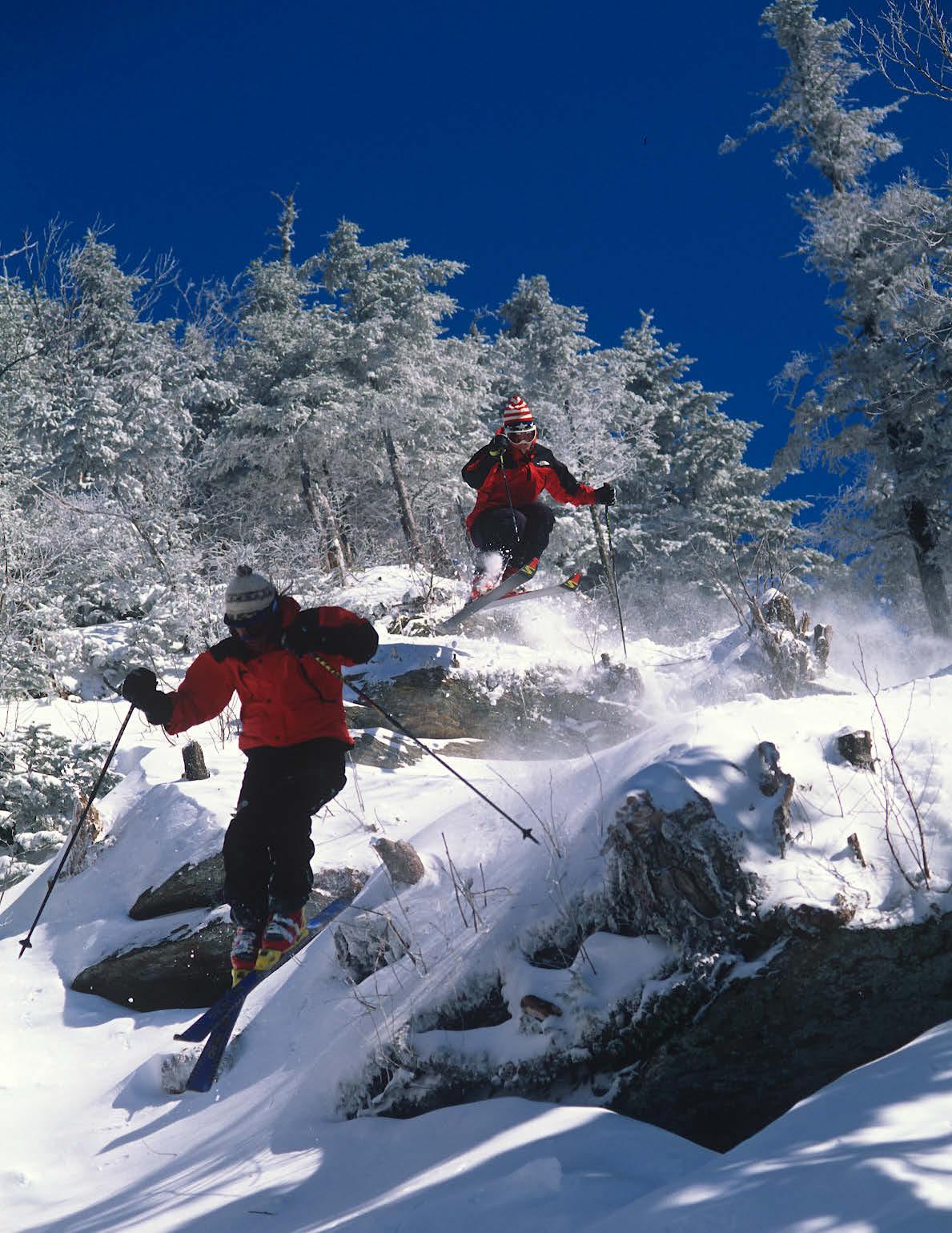
38 Winter/Spring 2024 vtskiandride.com
Skiing the trees, rocks and ice of Bolton’s backcountry gave Dean Decas (left), Adam DesLauriers (right) and others of their era the skills they would later put to work skiing big mountain faces in front of film crews. Photo by Hank DeVre
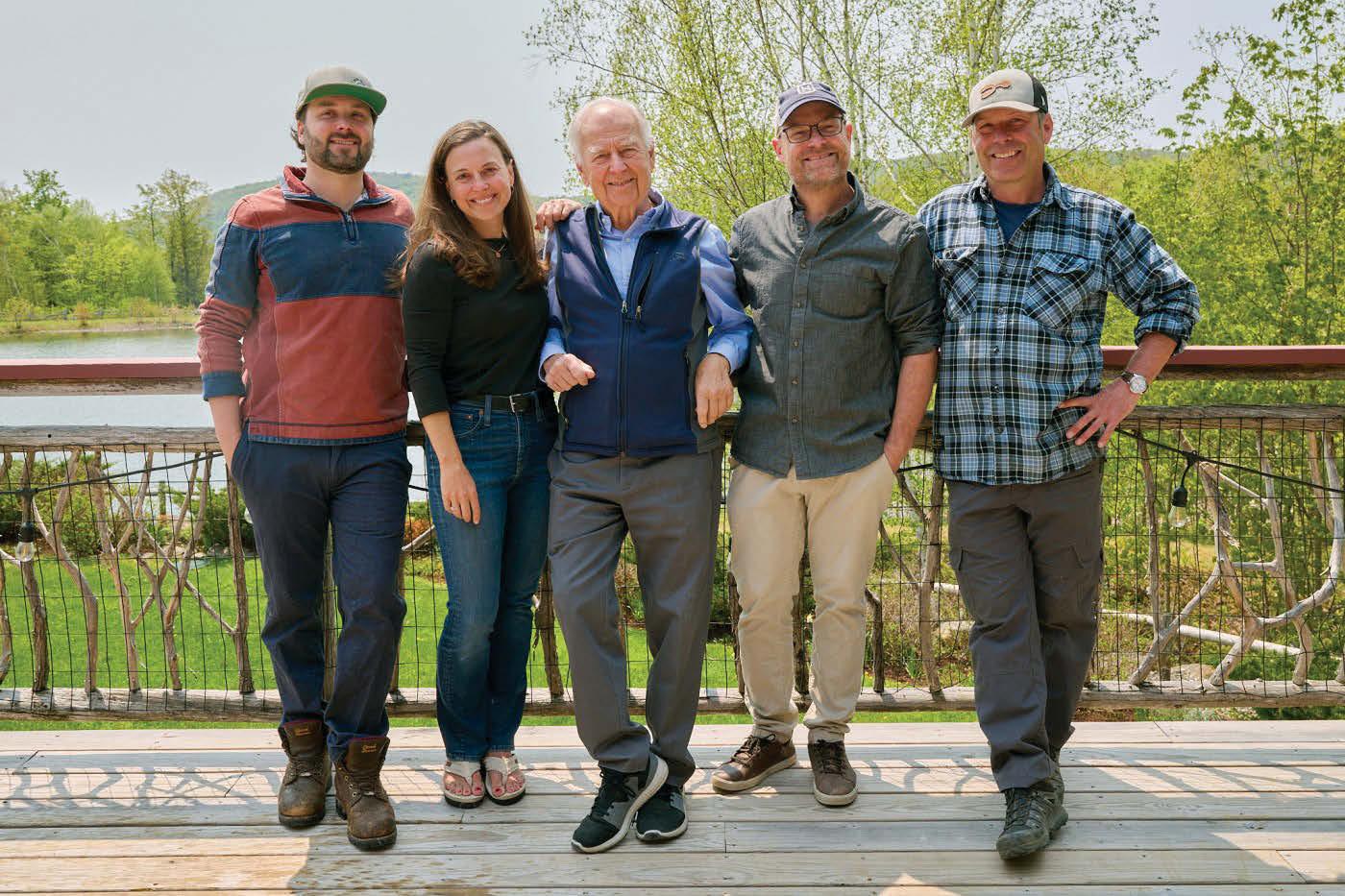



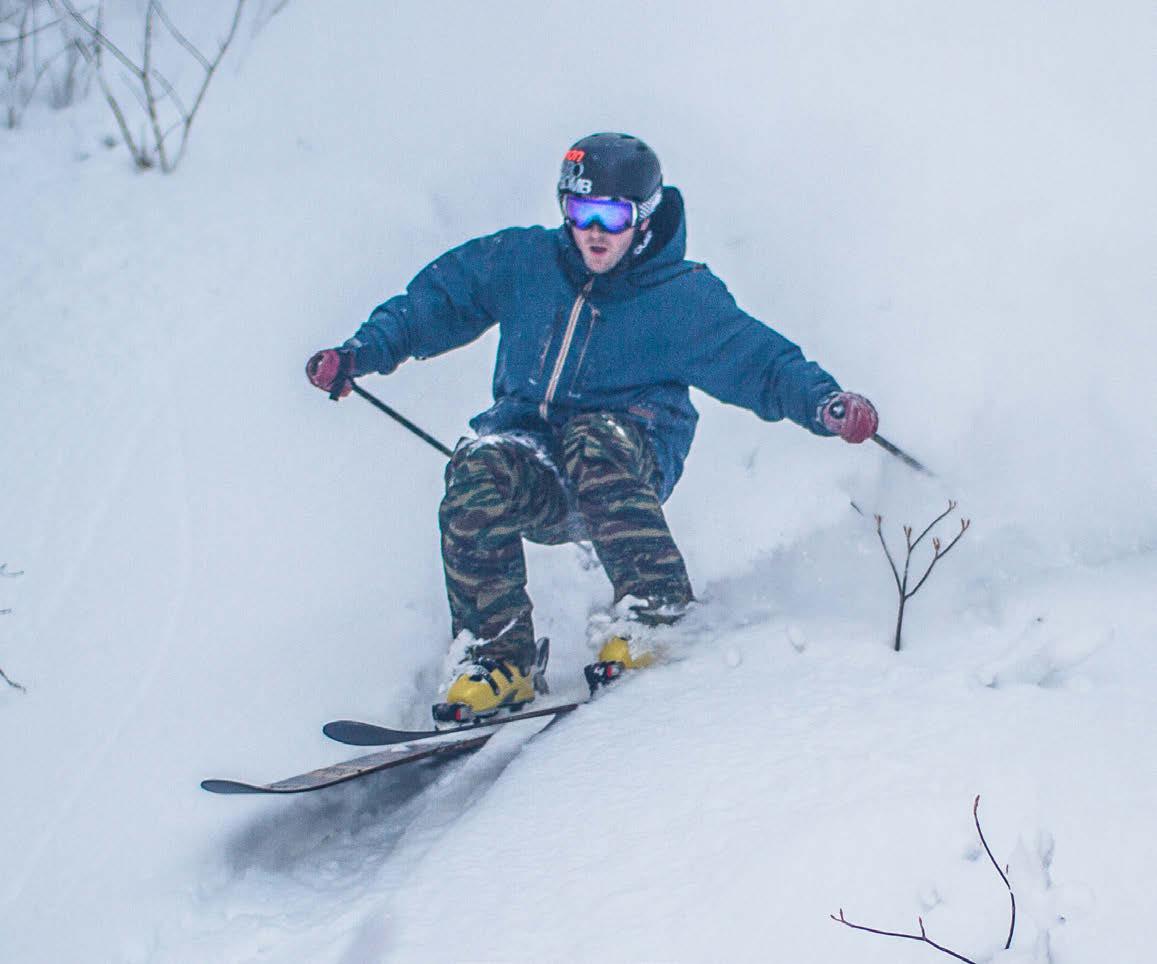
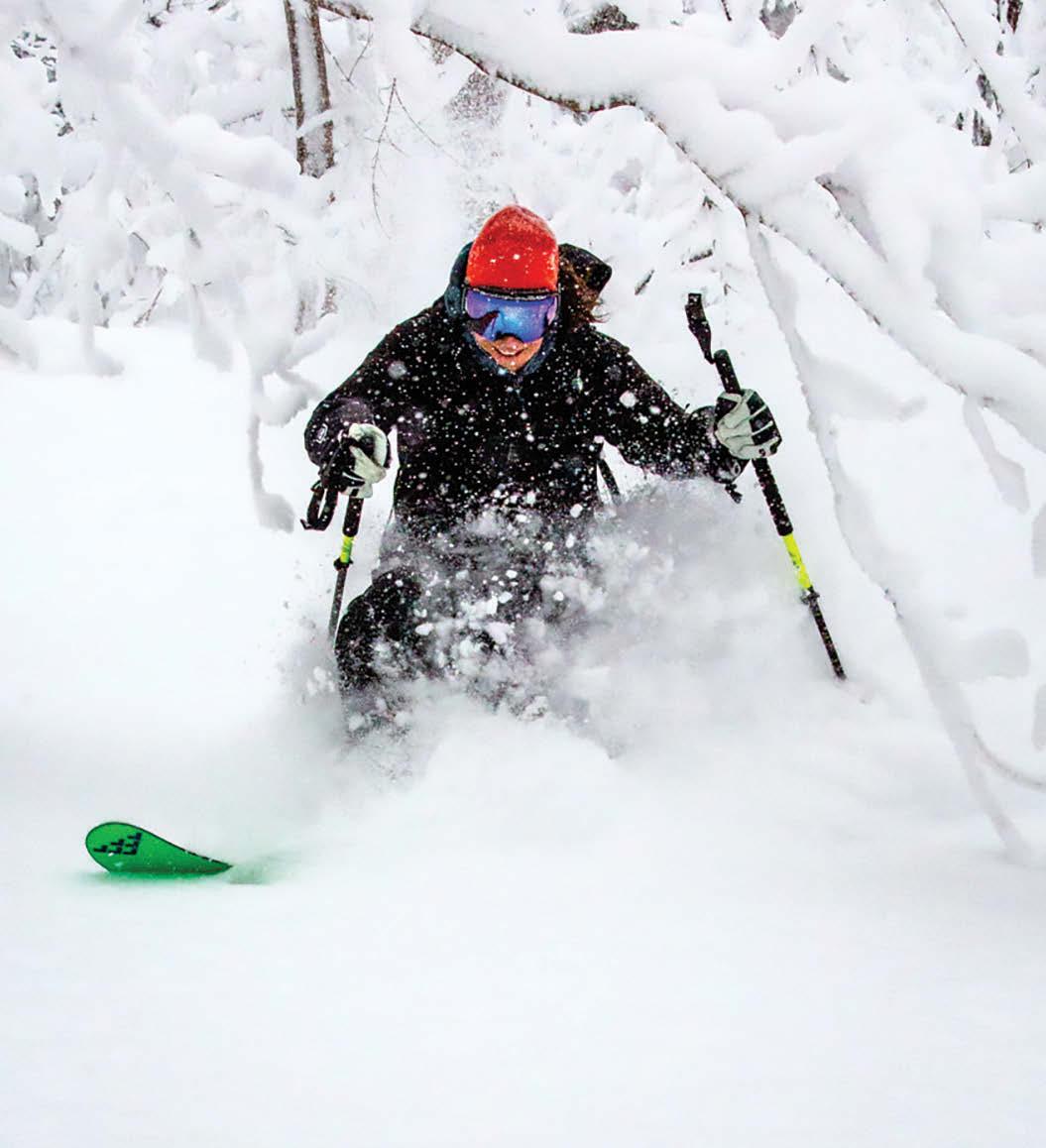 Clockwise from top left: Bolton is a family business for founder Ralph DesLauriers, pictured with Bolton’s new managers; his children Evan and Lindsay to his left and Adam and Eric to his right. Back in the era of one-piece suits, Adam DesLauriers and Gabbie Velasquez charge moguls on home turf. Dean Decas pokes around Bolton in January, 2024. Bolton CEO Lindsay DesLauriers (at right) and Skida founder Corinne Prevot (at left) on a recent Bolton Babe Force outing. Adam DesLauriers in January 2024, poking around Bolton’s backcountry. Photos (clockwise from top): Courtesy Bolton Valley, Hank DeVre, Jen Bennet, courtesy photo, Jen Bennet.
Clockwise from top left: Bolton is a family business for founder Ralph DesLauriers, pictured with Bolton’s new managers; his children Evan and Lindsay to his left and Adam and Eric to his right. Back in the era of one-piece suits, Adam DesLauriers and Gabbie Velasquez charge moguls on home turf. Dean Decas pokes around Bolton in January, 2024. Bolton CEO Lindsay DesLauriers (at right) and Skida founder Corinne Prevot (at left) on a recent Bolton Babe Force outing. Adam DesLauriers in January 2024, poking around Bolton’s backcountry. Photos (clockwise from top): Courtesy Bolton Valley, Hank DeVre, Jen Bennet, courtesy photo, Jen Bennet.
TIPS FOR TREE SKIING
By Eric and Rob DesLauriers
In their book, Ski the Whole Mountain , written with former Skiing Magazine editor Bill Grout and published in 2000, Eric and Rob DesLauriers share many of the tips they learned from skiing big terrain. The tips range from skiing steeps to dropping a cornice. Here, their advice on skiing trees:
Skiing well in the forest depends on developing your tactical awareness and planning while on the move. You have to look for the open spaces. Focus on the white between the trees and don’t be distracted by the trees whizzing by. Imagine if you stared at every car on a two-lane road? Sooner or later, you would hit one, for sure. The trick is simply to look ahead and relax. Look at your intended route, not the at the trees.
Because trees do not grow in a set pattern your line options are endless. In your favor is the fact that many people tend to follow existing tracks. This creates a “rut line” and by avoiding it you can often find better snow.
To ski the trees fluidly, you need confidence in your ability and some tactical rules:
Ski with a buddy. If something goes wrong, you need to have someone who can bail you out. Our partner Dean Decas fell into a a tree well once and almost lost consciousness before his tree skiing buddy dug him out.
Look at the gaps. Trees are like magnets. If you look at them, you’re likely to hit one. Look at the spaces between them instead and look for the light ahead.
Think about your turn placement. Usually, you want to turn above or below the trees, not next to them. If you think about it, you are skinniest when your skis are pointed straight downhill. Set up your move through tight spots by placing a turn right above a tight section. Turn into the fall line through the tight passage and exit into the open as you complete your turn. Think about where your boots are going to travel.
Control your speed. Always be ready to hit the brakes. You will, without a doubt, encounter unexpected obstacles (downed trees, cliffs, streambeds) so always ski at a speed where you can stop immediately or at least bail out.
Know your foliage. In the East, tree skiing is usually among hardwoods, evergreens or puckerbrush. You can usually bull through the branches of evergreens and plow through pucker brush that’s an inch or less in diameter. Just wear your helmet and goggles and let it rip!
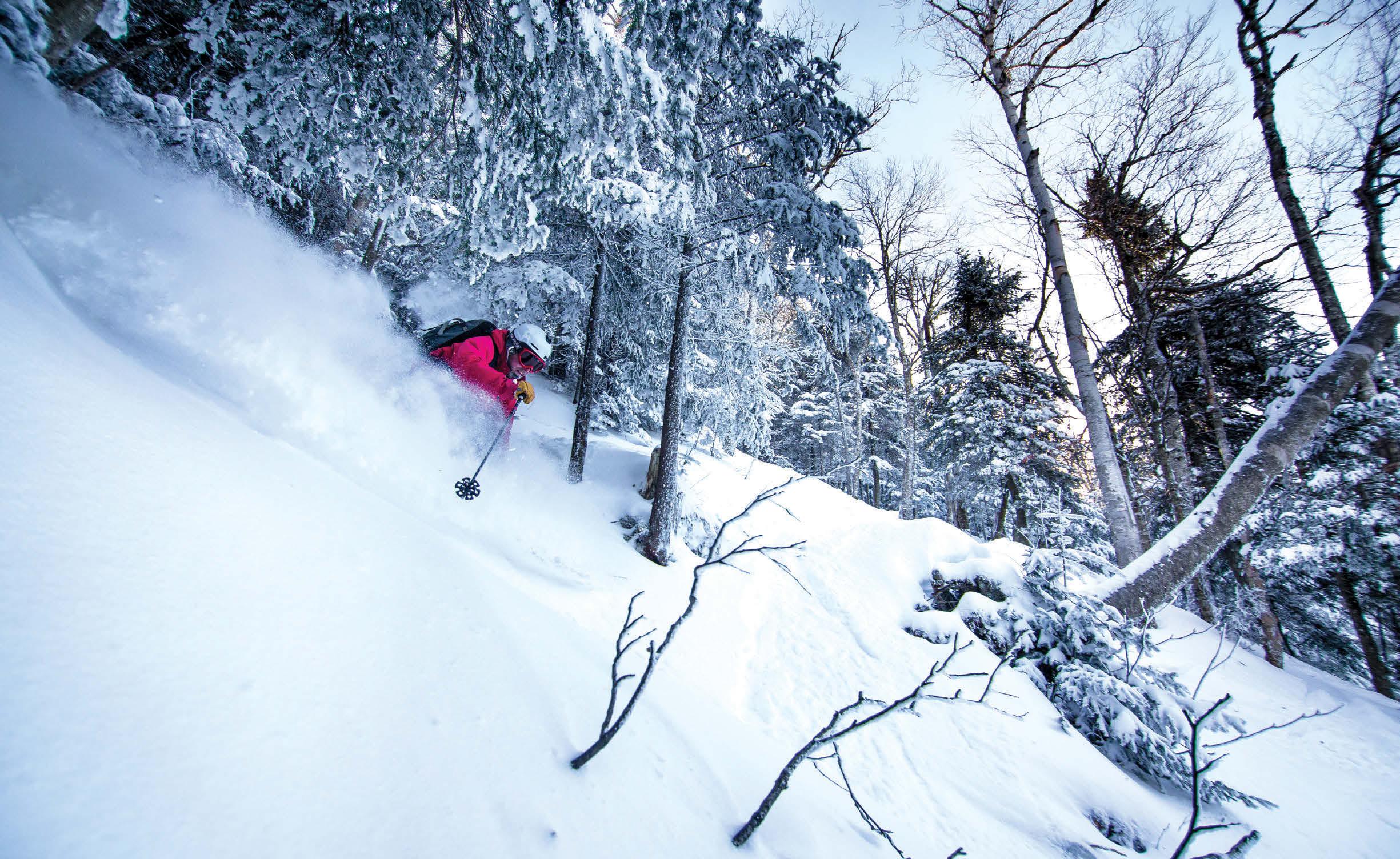 With acres of glades, guided tours and a rental program that has a wide array of AT skis, boots and splitboards, Bolton Valley has become Ground Zero for backcountry skiing . Photo this page and opposite by Ryan Denning.
With acres of glades, guided tours and a rental program that has a wide array of AT skis, boots and splitboards, Bolton Valley has become Ground Zero for backcountry skiing . Photo this page and opposite by Ryan Denning.
Before long, Eric and Rob DesLauriers and John and Dan Egan were the stars of Warren Miller’s feature about the two sets of brothers Double Exposure. The four were also part of The North Face’s Alpine Team and, starting in 1992, hosted X-Team advanced ski clinics for expert skiers.
“We ended up skiing all over the world together and it was just so much fun,” John Egan recalls. “There was no competition between us – we all shared knowledge and got better because we pushed each other. Of course, there was a lot of heckling, too. We called Eric “Suavè” because he was such a smooth skier.”
For John Egan, it was no coincidence that so many of these new “extreme” skiers were from Vermont. “Growing up skiing at places like Bolton or Mad River Glen we got a taste of what allmountain skiing was all about. These were the places that left the terrain natural; they didn’t run a bulldozer down and flatten out all the cliffs and rocks. The terrain left much to a young man’s imagination and what we could do with it. It allowed us to play in areas that seemed dangerous but were actually pretty safe—I mean you dropped maybe only 10 feet,” he says.
The DesLauriers also wrote a book Ski The Whole Mountain, with photos from their adventures and tips for everything from skiing trees and powder to catching air.
Between 1988 and 2000, Rob DesLauriers and one or more of his brothers starred in some 20 ski films. They also created and produced their own. In 1999 Rob directed and Adam wrote Higher on the Mountain following Scot Schmidt and Jim Zellers on their first descent of Mongolia’s Mount Belukha.
It was on a mountaineering trip to Mount Belukha that Rob met his future wife, a ski mountaineer from Telluride named Kit Katzenbach. Her grandfather had built the first chairlift in Stowe and she had grown up skiing New England. They married in 1999. Kit went on to win the World Freeride Tour twice and become the first person to ski the highest summits on all seven continents. Rob skied Mt. Everest with her, as well as four others. They settled in Jackson Hole, Wyo. Eric and his young family were already ensconced in the Lake Tahoe region.
Return of the Natives
In 1997, Ralph DesLauriers was forced to sell the resort he had been building for 30 years, the place where his five children had learned to ski. But in 2017, he was able to buy it back. His daughter Lindsay, 44, is now the president and CEO. An expert skier and mountain biker with a background in business and lobbying, she often leads the Bolton Babe Force (open to all women and those who identify as women) on forays such as the Backcountry Babes ski camps and, in the summer, mountain bike rides.
Lindsay took on the challenge of not just stabilizing a business that had been losing money but modernizing the ski area. Her first cliff to huck though was a steep one: Raising money to overhaul a failing water system that not only served the ski resort but also the town of Bolton Valley. She did it and her younger brother Evan, 36, took a role managing special projects and capital improvements. The 60 rooms in the base area hotel and Timberline Lodge were redone, the Sports Center overhauled, and in the past few

summers, the original gnarly mountain bike trails were revived and new, more family-friendly ones added.
Adam, now 50 and working on the marketing side, saw the opportunity that the growth of backcountry skiing was offering. In addition to Bolton’s 6 lifts and 71 trails and 300 in-bound acres of trails, there was more than 5,000 acres of terrain that could be explored.
Bolton Valley’s high base elevation (at 2,100 feet it is the highest in the Northeast) and western exposure facing Lake Champlain means it averages just over 300 inches of snow a year. Adam soon set up Bolton’s backcountry touring center and also invited the Catamount Trail Association to put on a weekly ski mountaineering race series on Tuesday nights. Thursday nights the resort hosts an alpine corporate race league and there is also night skiing five nights a week.
“Bolton was the first place to have a big backcountry program with splitboards, AT and tele rentals as well as guided tours and lessons,” says Dean Decas. With the Bolton Camp and Bryant Lodge backcountry huts a short skin away and the Catamount Trail leading over the ridgeline to the Trapp Family Lodge, it has become a Ground Zero for backcountry skiing in Vermont.
“The backcountry at Bolton is phenomenal,” adds John Egan. “And the Bolton backcountry program did it right: they maintain and really celebrate the backcountry.“
Last summer, Eric, now 60, returned. “The position overseeing mountain operations opened up and I saw an opportunity back here,” he said. Dean Decas was ecstatic. “I was so stoked when first the DesLauriers bought Bolton back and then Lindsay took over as CEO and then Adam launched the backcountry program. Now that Eric is there too – the gang is back,” said Decas.
The next thing he adds, a bit wistfully: “We have to get those X-Team camps going again. I’m going to talk to those guys about that.”
It’s not an improbable idea. John Egan, who lives in the Mad River Valley, remembers hosting X-Team clinics at Bolton. “Skiing at Bolton you really got to know the mountain and you really kind of fell in love with it because it was it was what skiing should be. It was for the family. It was affordable. It was inclusive. And here were some of the best skiers in the world doing a clinic—and they were the family that owned it! That was pretty cool.” n
vtskiandride.com Winter/Spring 2024 41
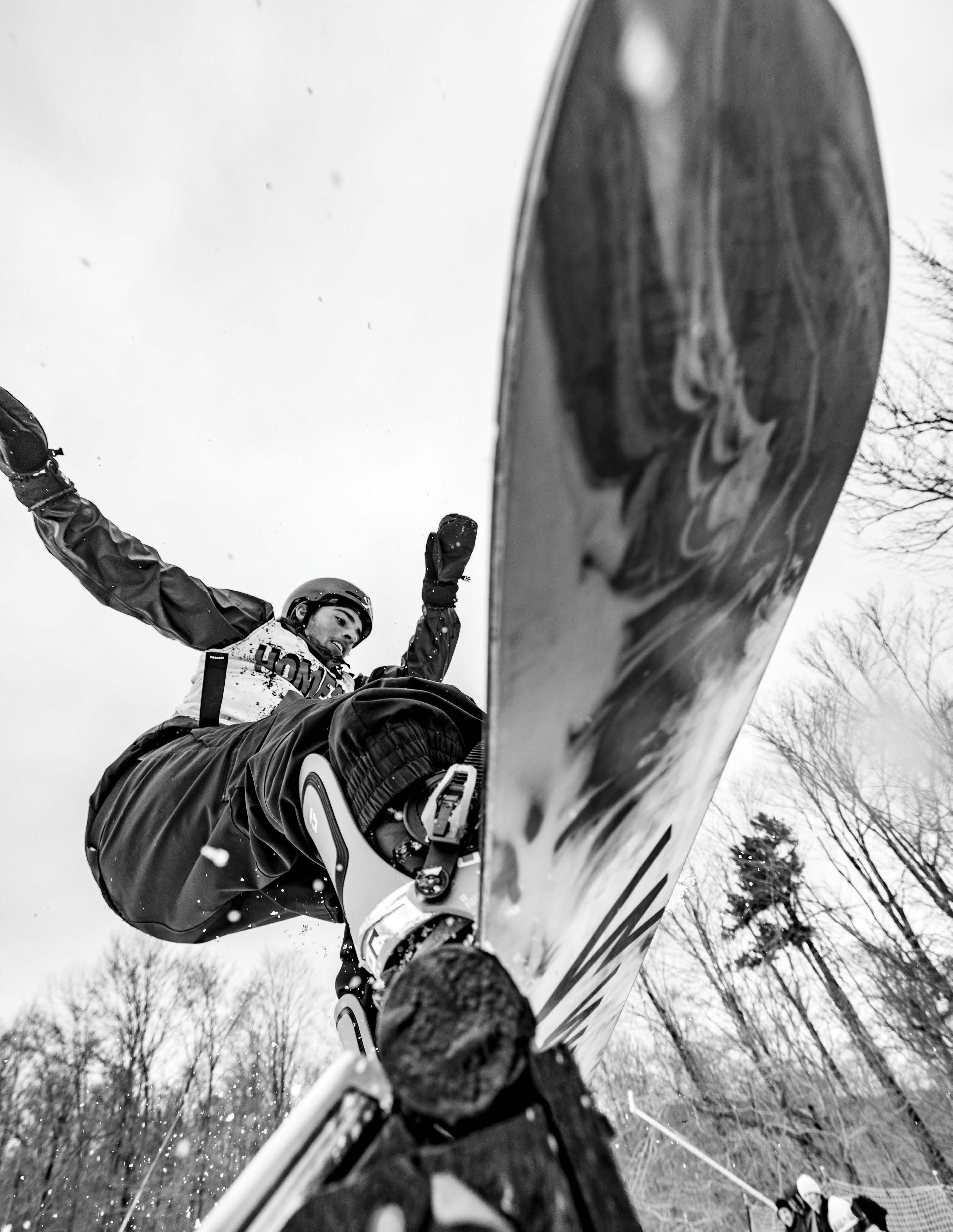
From 1985 to 2012, the U.S. Open at Stratton drew amateur riders and the best of the pros, such as Steve Hall, far right. Now, a new event called Homesick is reviving that spirit with a Ross Powers Retro Pipe and OG Downhill and bringing in a new generation with the Zebulon Rail Jam (this page).
Photo left by Gary Land, right courtesy Stratton Mountain Resort.

Zeb

They came home last spring: a constellation of snowboard stars formed at Stratton. Olympians Shaun White and Scotty Lago, local legends such as Paul Graves and Suzie Rueck, and the sports’ new disruptor, Stratton Mountain School grad and X Games gold medalist, Zeb Powell, 24 returned to Stratton
Stratton, one of the first mountains to allow snowboards on lifts. Stratton, where Jake Burton Carpenter tested many of his early designs. Stratton, where each March from 1985 to 2012 the renegade energy that had been building around the sport was focused. That’s when the top riders from around the world (along with several thousand passionate spectators) converged for the Burton U.S. Open of Snowboarding, a weekend of competition, shredding and just a bit of mayhem.
Stratton was where snowboarding broke free of its obscurity in the ‘90’s. This ‘breezy fad’ created a panic throughout the ski industry as it unleashed the raging hormones of adolescents. The scene at the half-pipe at the U.S. Open always felt like fireworks waiting to go off as people banged on the sponsor posters lining the half pipe and snowballs flew from wall-to-wall. The biggest method at the top of the pipe didn’t always get the top score but it always sent the crowd into a frenzy.
44 Winter/Spring 2024 vtskiandride.com
X Games medalist and Stratton Mountain School grad
Powell designed the Zebulon Rail Jam for Homesick, but he was equally happy in the Powers Retro Pipe. Both Powell and Olympic medalist Shaun White, opposite, were swarmed by the crowd.
Photo by Peter Cirilli; opposite, Dave Schmidt
Scott Lenhardt, a graphic designer known for designing more than 50 board graphics for Burton, summarized the old U.S. Open perfectly, “It became a place where you could literally watch the sport of snowboarding progress in front of your eyes. That’s the magic and power it had.” It was that magic that brought snowboarders from around the world to compete and spectators from up and down the East Coast for one of the largest snowboarding events in the world.
Photographer Gary Land was part of that scene, living it and shooting thousands of images. During the Covid pandemic, Land – now a celebrated photographer with clients such as New Balance, Delta Airlines and Red Bull – had a chance to sort through his old snowboard images. Land enlisted the help of an old friend and former Burton team manager Barry Dugan to help pull it all together.
The result of that project was the @eaststreetarchives Instagram followed by a 437-page tome also named East Street Archives that celebrated that remarkable era of snowboarding in Vermont and the Northeast. That was only the beginning.
Reliving those memories, especially around the U.S. Open, got Land thinking: Why not recreate the Open experience? The Homesick festival was born. On the Bomb Hole podcast Land explained it:
“ Homesick..It’s like a shred and arts festival. The reason why I call it Homesick? I was thinking about the right title, and I was like ‘Look, I lived there. I lived at Stratton,’ and I felt homesick about missing the U.S. Open, missing what it was like to see all my homies and my friends and to feel part of a family. That was gone. So, I said, ‘It’s my duty to bring that back and let these people have the proper high school reunion.’ That’s what I wanted. I don’t care. If you don’t want to ride. Don’t ride. Just come. Let me give you a hug. That’s it, man. That’s what I wanted it to be ,” Land said.
The invites went out. Held at Stratton last March, Homesick brought together legends as well as newcomers. Threetime Olympic gold medalist Shaun White, former pro and current NBC snowboarding announcer Todd Richards, Snowboard World Cup 15-time winner Tricia Byrnes, Olympic gold medalist and director of snowboarding at Stratton Ross Powers, X Games and U.S. Open medalist Keir Dillon and one of the OG’s of women’s snowboarding, Laurie Asperas. These were just a few of the legends who returned to Stratton along with X-Games medalist and Burton pro Zeb Powell. It also brought together a slew of industry veterans who hadn’t shared the same slope for decades. For many, that was the real jewel of the weekend.
Many things may have changed in snowboarding, but the youthful shredders of the 90’s, now hidden in somewhat
softer, grayer bodies, still love the sport they built. When the opportunity came up to relive those days, we made a pilgrimage.
As word spread so did the number of CONFIRMED riders, each celebrated with a post on the East Street Archives Instagram.
There were events both on and off the snow. As Dugan explains: “We designed the weekend intentionally with the OG Downhill first, to recognize the history of the earliest snowboard competitions, followed by the Power’s Retro Pipe, held on East Byrnes Side, the site of the original U.S. Open halfpipe, and concluding with the more current Zebulon Rail Jam, designed by generational talent Zeb Powell.”
Like the Open, the competition was open to anyone who was willing to drop $99 bucks on the entry fee. Like the Open, prize money was equal for women and men. Over 300 competitors signed up and the starting lists had riders from ages five to 67. Unlike the U.S. Open, however, there was a category for the 40+ crowd for each event.
Off the snow events included a very popular Vintage Board Room, with hundreds of decks from the 80’s and 90’s from collector Tim Mackenzie and Burton’s archive manager Todd Kohlman. Across from the Board Room, the Burton shop was converted into the Witness Photo Gallery featuring the top photographers from the era and the images that graced the pages of the now defunct Transworld Snowboarding and Snowboard magazines.
The OG Downhill got the luck of the draw with the weather as it was the only warm and sunny day of the weekend. Snowboard legends Mark Heingartner, Scotty Lago, Hobie Chittenden, and Ross Powers lined up with everyone else and took their turn snaking through the classic head-to-head dual slalom course.
Meanwhile, with the sun shining and the snow turning the

vtskiandride.com Winter/Spring 2024 45

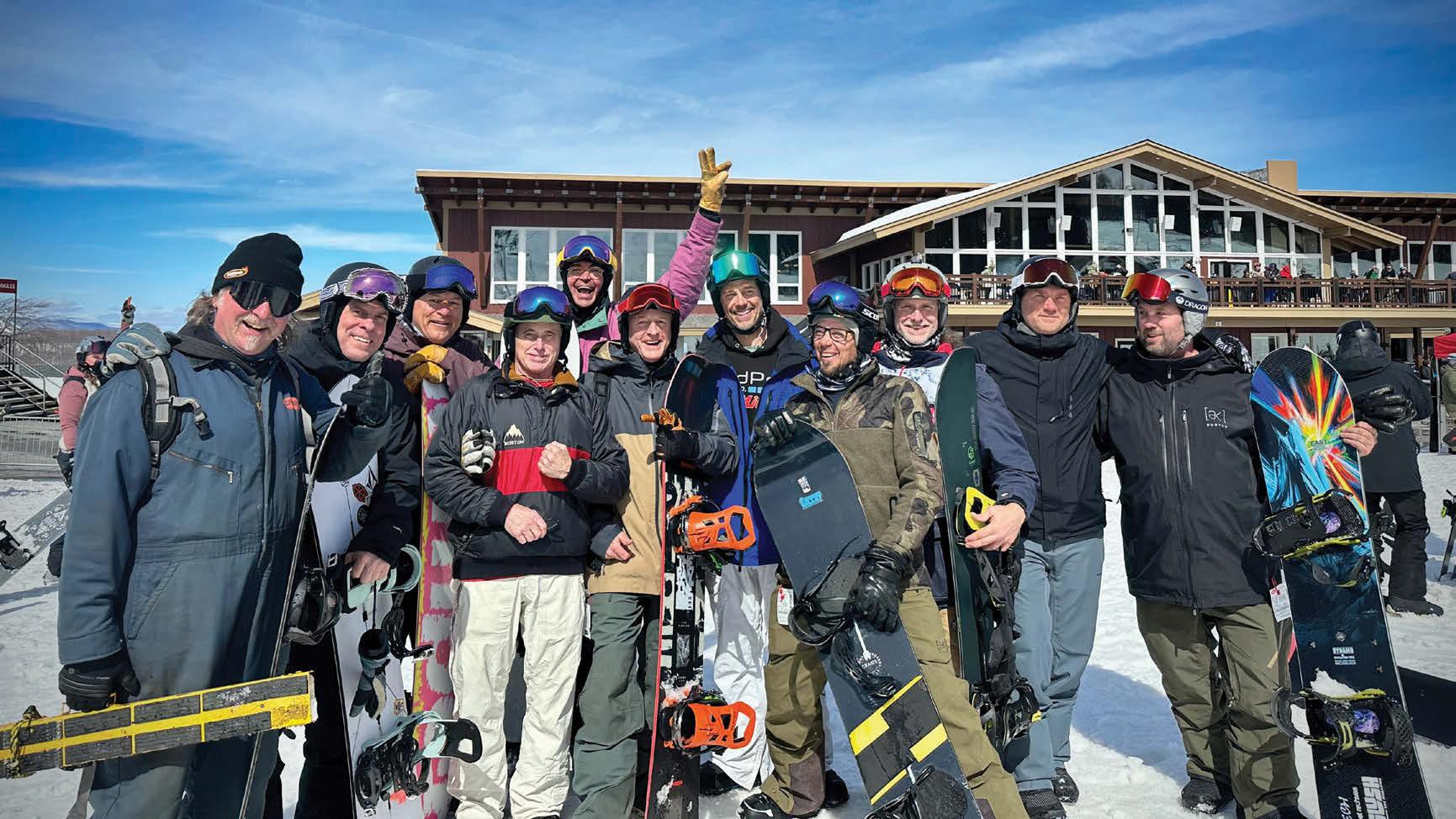
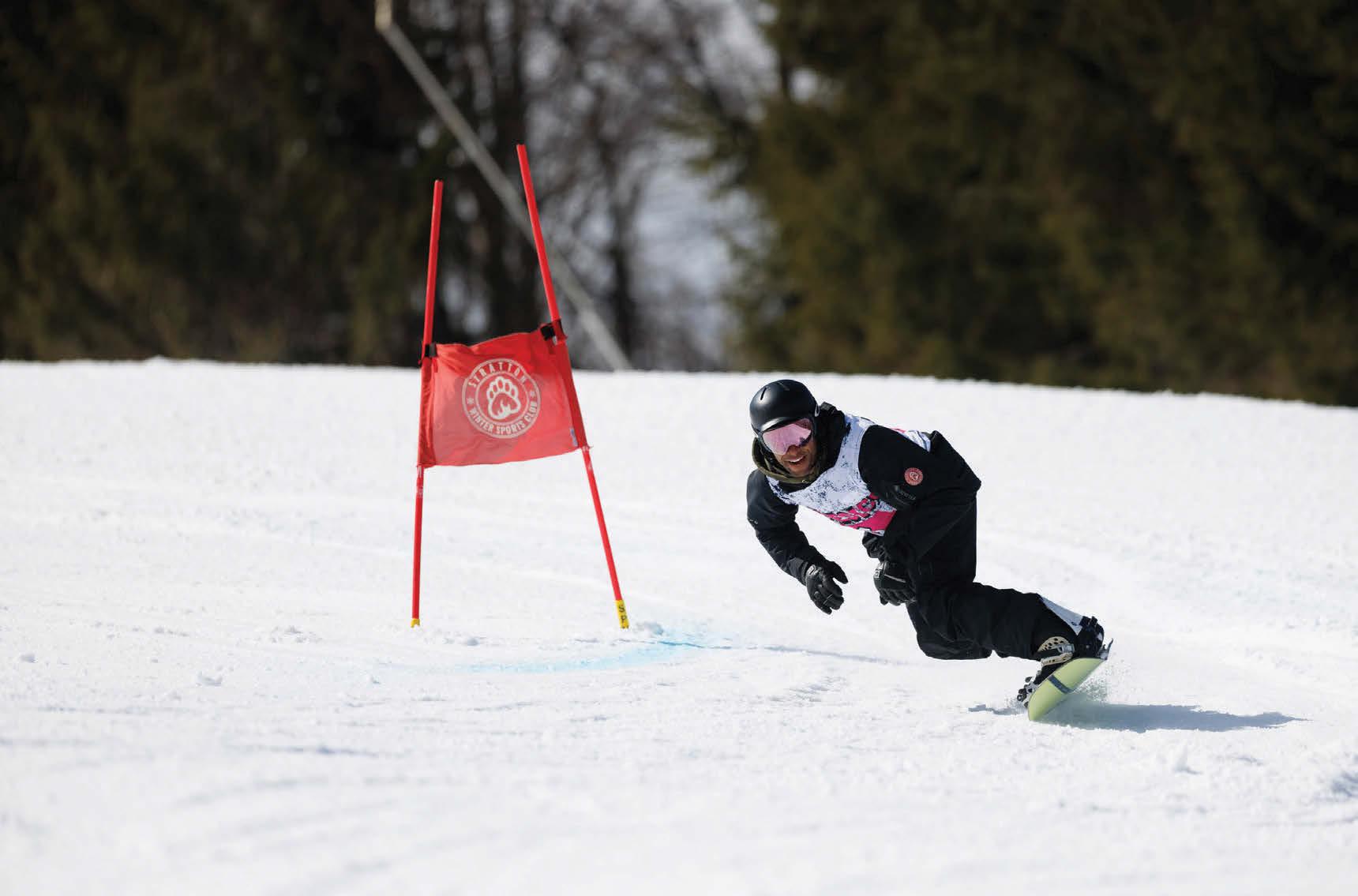
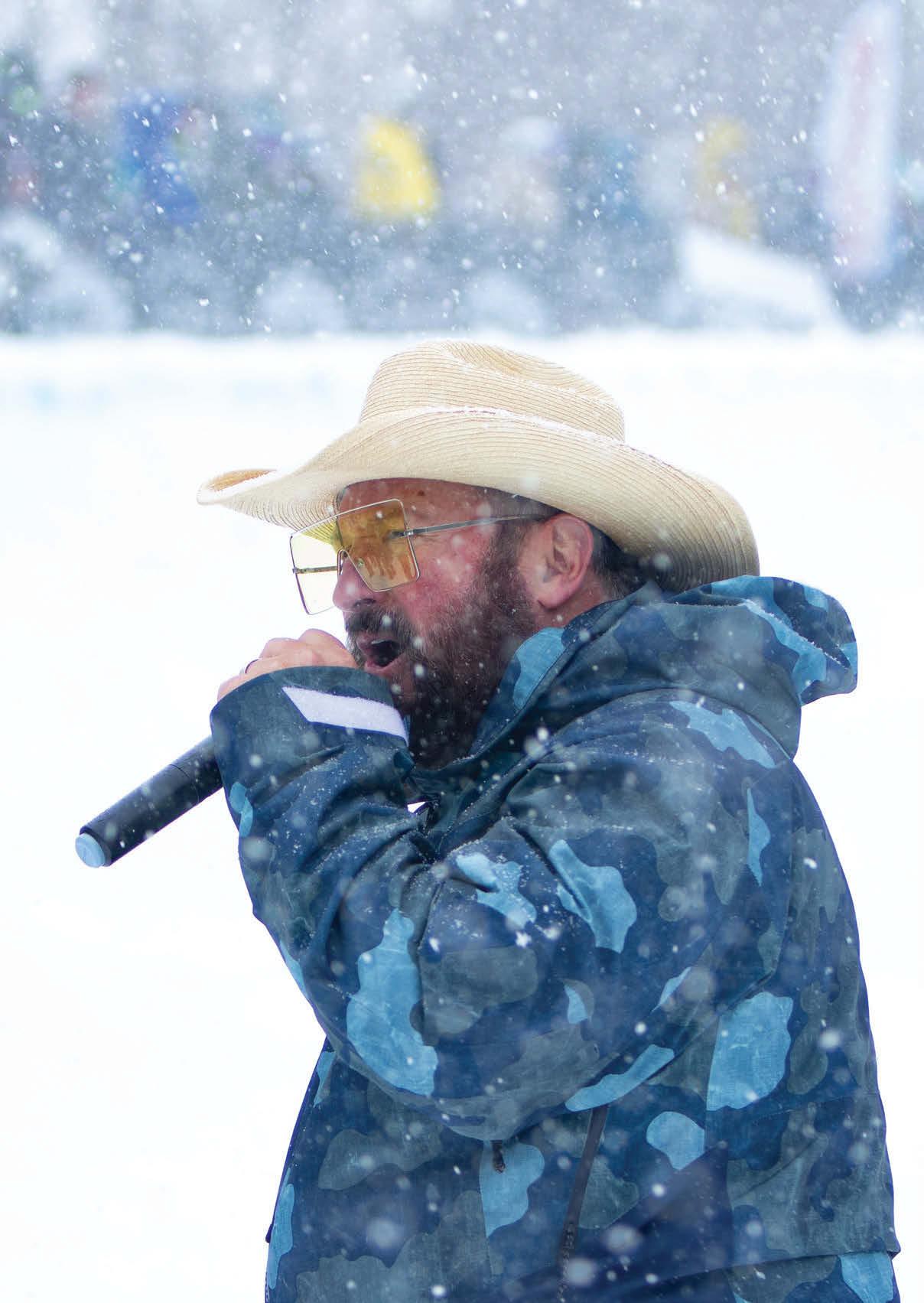




vtskiandride.com Winter/Spring 2024 47
With the Powers Retro Pipe packed with spectators (top), Homesick was a flashback to the ‘90s. Opposite, insets: Gangs of old friends and industry vets rode together. Raschid Joyce (opposite, bottom) ripped through the OG downhill course. The slalom was once a staple of the old U.S. Open when Andy Coghlan (this page, above middle left) was competing. This page, insets: Chris Copley (far left) once again announced, recalling the old days of the OG downhill (middle). Snowboard phenom Zeb Powell took selfies with adoring groms and got inverted on one of the features he designed for the rail jam event. Photo top by Peter Cirilli. Opposite insets: top by Dave Schmidt, bottom by Gary Land. This page, insets: right by Gary Land, middle left by Hubert Schriebl, middle left by Gary Land, far left by Peter Cirilli.
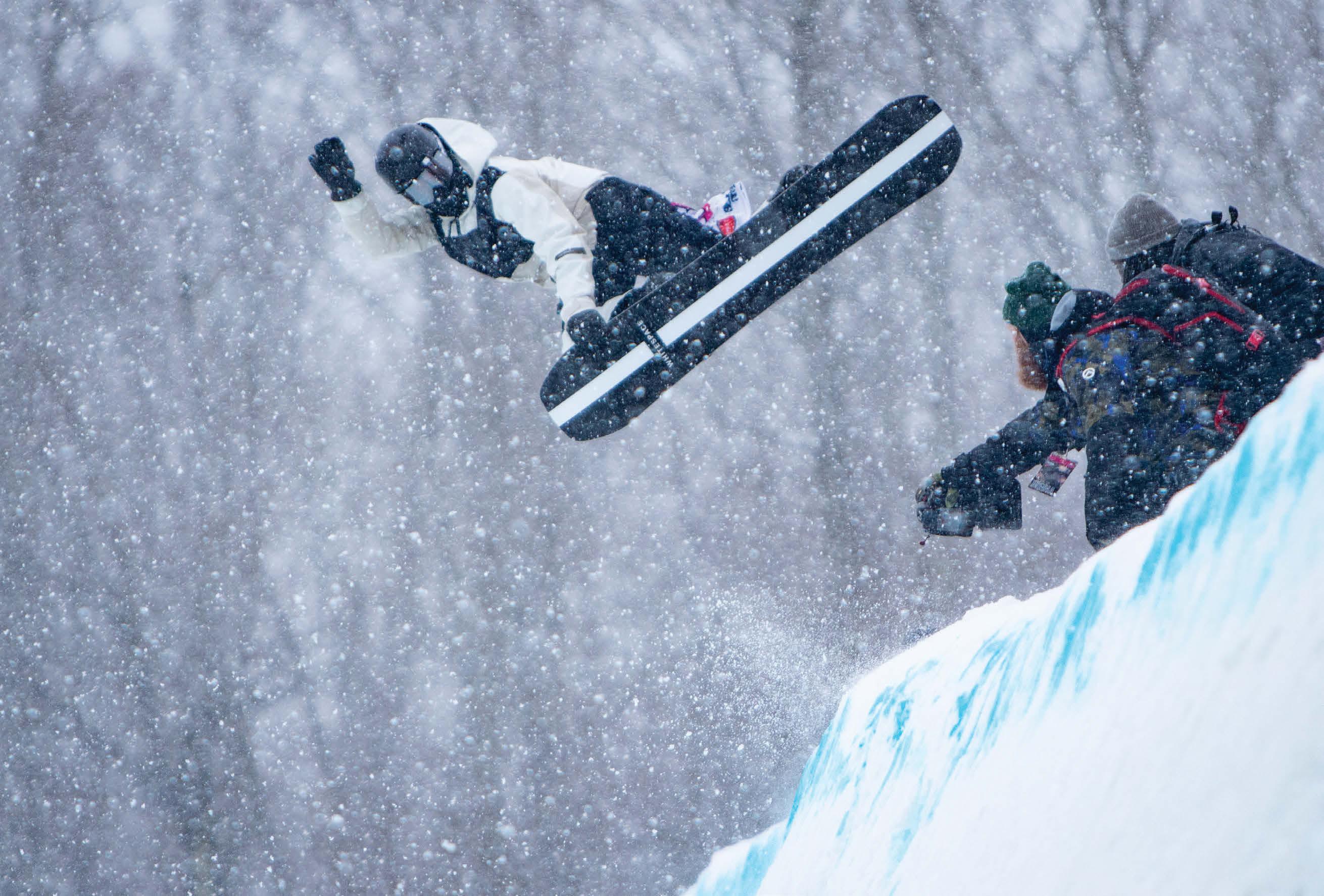

mountain into a giant slushy, a slew of industry vets, myself included, shredded laps on the gondola in a massive pack, most riding like we still thought we were 25.
Dave Olcott, former Underground Snowboard Shop manager and founder of Stimilon, one of the first snowboard park building companies, was among the group. He had this to say: “It was just great to see so many old faces again and ride with a huge posse of OGs with my kids. My girls have heard all the industry names over the years and it was cool to see their faces light up to meet our old crew.”
The pipe event had been the centerpiece of the old U.S. Open since it first appeared. However, today’s nearly extinct halfpipes have monster walls that cater mainly to the pros. For the Retro Pipe, Dugan said: “We want the pipe to be accessible for all ages and abilities. We are not going towards 18- to 22-foot walls.” The resulting pipe, designed by Ross Powers, was identical to what you would have found at the Open in the early ‘90’s. It proved to be perfect for the range of riders that dropped in.
Saturday arrived with a mixed bag of weather that didn’t deter anyone as the pipe was lined with spectators from top to bottom. Chris Copley, the former Burton New England rep who had announced the pipe event for years in the 90’s, picked up the mic again and proceeded to give endless commentary on the riding, the weather, the crowd, and anything else that crossed his mind, just as he did for years at the Open.
At the top of the pipe, legendary Grindrite board tuner Chris
48 Winter/Spring 2024 vtskiandride.com
Competitors ranged from five-time Olympian Shaun White, who took his turn in the pipe (above) to Harley Ruffle, age 5, (below), better known to his Killington crew as Lil’ Homie. Photo top by Dave Schmidt, bottom by Gary Land.
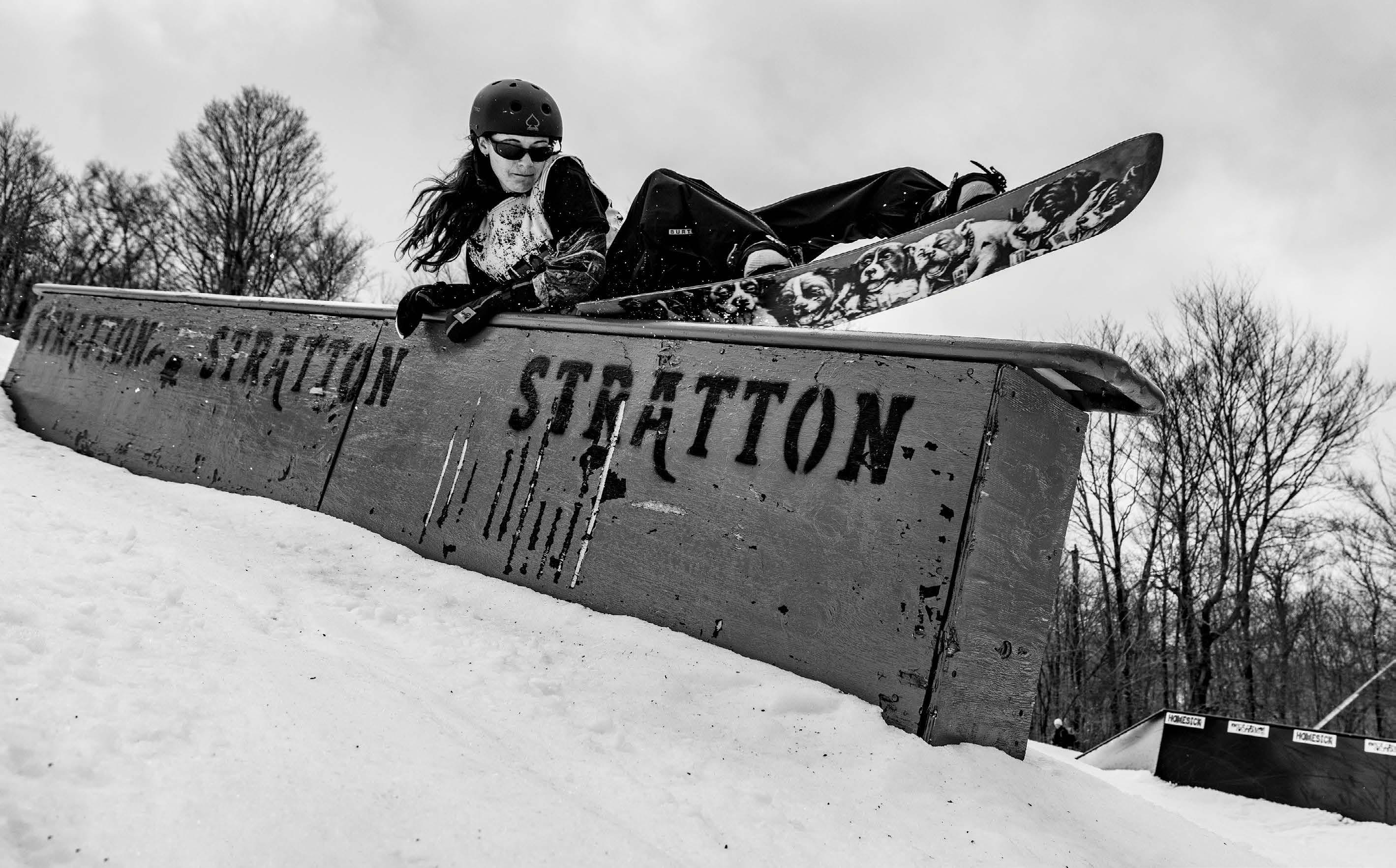
Doyle dusted off his files and scrapers and put fresh wax on boards. With a continuous flow of competitors and poachers throwing huge methods, hand-plants and 720’s, it was hard to tell that any time had passed since this party last got together. Greg Manning and other members of the VTSP (the Vermont Slope Posse) were back, reliving the days of the late 1980s when as high-school students in northern Vermont they had brought their moves from skateboarding and BMX to the slopes – riding their shred sleds on golf courses and toboggan hills until the ski resorts finally accepted snowboards. Members of the VTSP went on to win 13 World Cups and two Olympic medals.
At the bottom of the pipe, with the pen full of competitors and judges, Zeb Powell and Shaun White were engaged in a generational popularity contest as the groms navigated for selfies with them. They kept the throng of little ones happy with photos until White drove them into a frenzy by giving away a couple of his new Whitespace snowboards.
On Sunday it was time for the Zebulon Rail Jam where Zeb and others schooled everyone in how to push the boundaries, sliding and boosting in defiance of nature’s laws. Industry vets Pat Bridges and Dave Spruill announced the action, and awarded medals to a fabulous father-daughter combo, Veda Hallen and her dad Myles, who won their respective categories.
The awards ceremonies, which included cash and prizes, were a daily circus under Stratton’s clock tower.
Lenhardt wrapped up the weekend perfectly with this
comment “Nostalgia can be a tricky thing because it is meant to bring you back when in fact, you can’t really do that because of how time works. The cool thing about snowboarding and snowboarders is that simplicity always wins if it stokes you out. It seemed to me that everyone was pretty stoked to be there. The nostalgia part came in second place.”
The good news is that Homesick 2024 is locked in for March 22-24 with the same run of events. Already the list of CONFIRMED attendees on the East Street Archives Instagram is impressive. It includes current U.S. Team member Noah Avallone and former Olympians Shannon Dunn, Scotty Lago and Tina Basich, among others. Snowboard film stars and some-time Vermonters Jeff Brushie and Jake Blauvelt will be there, as will Ross Powers and Zeb Powell, pioneers Todd Richards and Paul Graves (who organized the 1982 National Snow Surfing Championship in Woodstock). The list will continue to grow. It will be another do-not-miss weekend and the largest event on the East Coast dedicated to snowboard culture.
As you may have noticed, there is no mention of results and that’s intentional. Yes, there were winners, but that just didn’t seem to matter to anyone. It was all about the hang.
Dave Schmidt worked at Burton from 1986 to 2003 and was VP of Global Sales for over 10 years. To learn more about the 2024 Homesick or find lodging visit stratton.com
vtskiandride.com Winter/Spring 2024 49
Vermonter, pro rider and snowboard engineer, Maggie Leon lays it on the line at the Zebulon Rail Jam.
Photo by Gary Land
T HE G L OR Y D A YS
The passion. The riding. The antics. The people. Photographer Gary Land and Barry Dugan are not just out to preserve the early days of snowboarding in Vermont, they want to resurrect the energy that was exploding back then and share it.
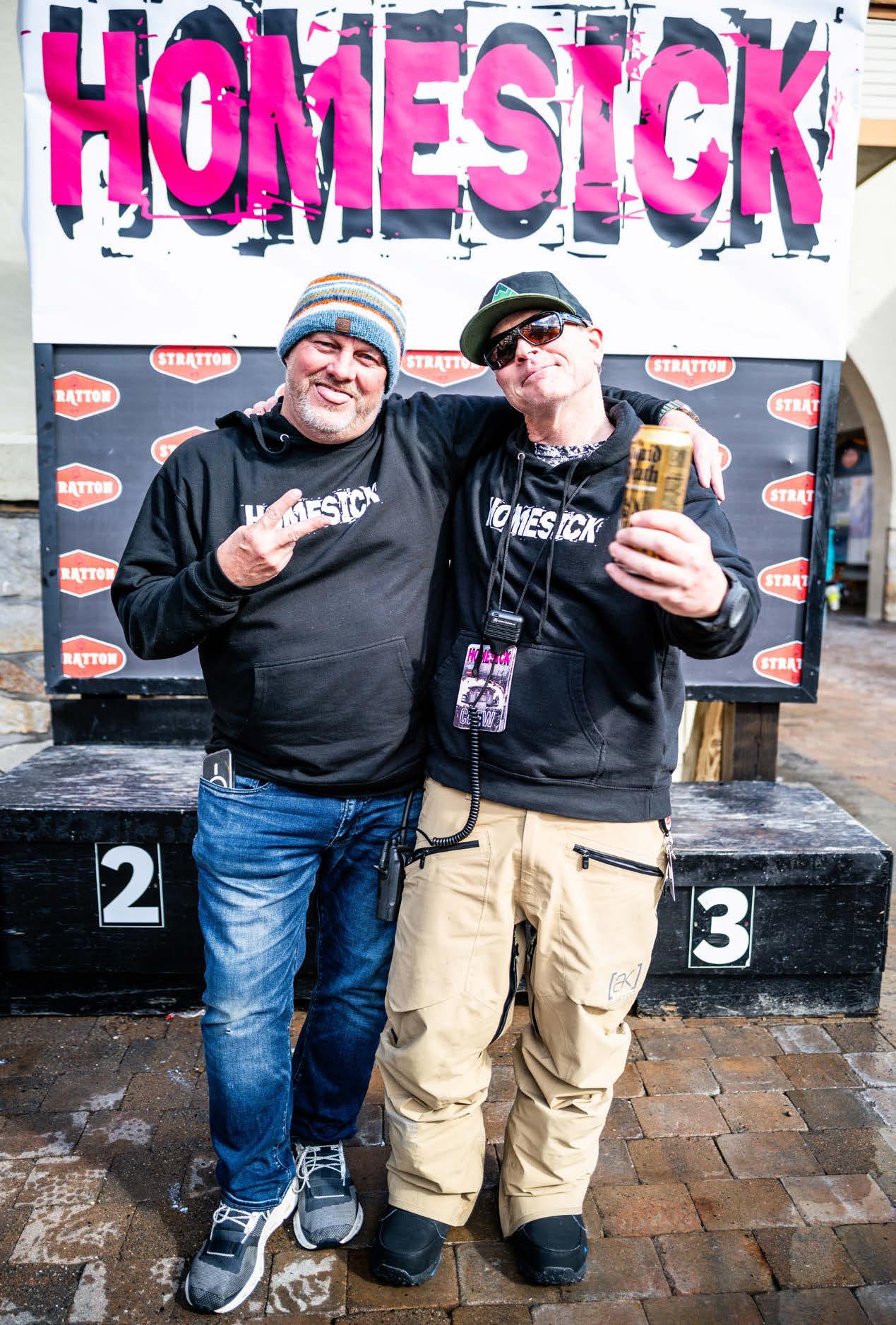
GARY LAND AND BARRY DUGAN
TEAMED UP IN THE 1990S. Flash forward 30 years and they are still working together. Their day jobs are at the award-winning Boston-based creative agency Gary founded, GLP Creative working with clients such as Nike, Puma, Under Armour, Titleist, NASCAR and Cadillac.
But a passion project in the past few years has been East Street Archives, an Instagram account, then a 437-page book of the same name and last spring, Homesick at Stratton. Homesick drew over 500 last year, including a who’s who of snowboarding and raised $30,000 for The Chill Foundation, started by Burton’s Jake and Donna Carpenter to bring board sports to underserved youth. This year, the festival is back to Stratton, March 22-24.
How did you go from @EastStreetArchives to the book to Homesick?
GARY : During the pandemic I was just missing everyone. I had time then to go back through my slides from the ‘90s and there were so many great memories. I wanted to create some sort of record of that time. So, I started digitizing the slides and posting them to the East Street Archives Instagram and getting in touch with all the old gang. That spawned the book – sort of a yearbook. Then Barry Dugan and I thought Hey, we should do an event, like a high school reunion, and Homesick was born. We’ve done this type of thing for clients so decided we’d do it for ourselves.
What were some of those memories? Like your first day snowboarding?
GARY: I was 24 and living in Virginia Beach, tending bar and struggling as a photographer. But I saw this snowboard ‘zine – Eastern Edge, out of Vermont — and thought snowboarding looked pretty cool. I immediately knew that I wanted to be part of this crazy new sport. So, I moved to Killington in 1993. I didn’t have a place to stay, I didn’t have a place to work but I got an apartment and a job at a ski shop that same day. The job was at Snowshed (I think it was) and my first day there I met the woman who would become my wife. The first time I went up the mountain I remember it was on the Bear Mountain Gonjala, as we called it – for reasons I won’t go into. The sky was so blue and there were all these snowcrusted trees. I was in awe. I got off, promptly fell on my ass and I was hooked. It was such a magical time.
BARRY: I was living in the Boston area and snowboarding on golf courses on the early, crude equipment. One day my girlfriend, now my wife, handed me The Boston Globe with an ad for a job at Burton in Burlington. I was fortunate to meet Emmet Manning and got my first job there. I worked at Burton for 10 years in sales and marketing and spearheaded the teams and promotions division. That’s when I met Gary and we started working together.
What kept you in Vermont?
GARY: The people were so cool and so welcoming. Neil Korn, who was putting out Eastern Edge, was like “Come shoot for us. You can crash here.’ And I did. After Killington, I spent three years living at the Eastern Edge office, sleeping on the couch. It was at the base of Stratton and each spring all the pros would come to Stratton to compete at the U.S. Open. That was like the Super Bowl and the NBA All-Star game for snowboarding and it was in my backyard! It was awesome.
BARRY: The friendships back then were just really organic. There was no social media, no texting. You had to talk to people. There was just so much growth and energy in Vermont around snowboarding. If you were into snowboarding, that was life for you. You really identified with it. It was what you wore, what music you listened to, it was watching the weather channel and waiting for the magazines and the film premieres to come
50 Winter/Spring 2024 vtskiandride.com
FIRST
At Homesick, organizers Gary Land and Barry Dugan (above, left and right) set up a gallery of images (top right0, many of which Land collected in his 437-page book East Street Archives. The CONFIRMED campaign shares the bios of some of the riders planning to attend the 2024 event. Photo top by Peter Cirilli, right by Riley Howland


out. It was beautiful! But there’s also no denying it: Snowboarding was really rebellious back then. We liked to poke, poke, poke at skiers— and the mountains were trying to figure out how to manage it. There were no terrain parks and the sport was fueled by a lot of creative testosterone.
How did you get Stratton to host Homesick?
BARRY: We knew the significance of Stratton and what it meant to us and what it meant to snowboarding. It definitely helped that Myra Foster, who has been there since the early days of the U.S. Open, is the marketing director there and that Ross Powers, two-time Olympic medalist is there running the snowboard program at Stratton Mountain School. I mean, Powers—two time Olympic medalist! That is someone to honor! That’s why we wanted to name pipe event for him.

How is Homesick different from what you might see at the X Games?
BARRY: We are sort of the anti-X Games. There are no velvet ropes, no admission ticket. You can drive up to Stratton, park for free, spectate for free hang out in the sponsor village for free. Pros and amateurs are all riding the same pipe. Last year it started out with heats, but it sort of devolved into a jam where a kid might find himself in the same pipe as Zeb Powell, but Ross [Powers] was cool with that.
GARY: But the beauty of Homesick was that it was a chance for anyone to ride the same pipe as Ross Powers or do a rail jam on the rail Zeb Powell just designed and rode. So many pro events now are roped off and you have the athletes and then the spectators. We wanted to break that down. Here, when somebody finished a run, they would get tackled by friends. Shaun and Zeb were just swarmed. Yeah, it felt like you were a part of this thing. We missed that and that’s what I wanted to bring back. It was such an intimate crowd and a lot of people came who hadn’t seen each other in many years. When Barry and I stepped up to the pipe on the day of the competition, we’re looking at people crying and going, Dude, I feel like I just took a step back in time, it looks exactly like it did in the 90s.
You got some really big names to Homesick… Shaun White, Zeb Powell, Tina Basich... How did you get them?
BARRY: Before the 2023 event we started this “CONFIRMED” campaign where we’d do a post on @ EastStreetArchives about someone who was coming. That went viral. The point of it was, we didn’t want it to just be the stars you know about but also some really good riders like Hobie Chittenden that you might not have heard of but who deserve recognition. We wanted to have people learn about them, too.
I’d worked with Shaun when I was at Burton and he was a kid – now he’s a sports star on the level of Tom Brady. Anyway, he contacted us and said “Hey, looks like you guys are doing something cool. I might be on the East Coast. ‘ So, we said, ‘Come on over!’
For 2024 we have riders coming from Austria, Germany and Switzerland as well as Jeff Brushie, Jake Blauvelt and other greats who didn’t make it last year. But it’s not just about the pros. We want everybody to come. Maybe you haven’t been riding in 5, 10 or 15 years, or you got a bum knee but you can still come and participate. We’ve got off snow exhibits. We’ve got a vintage boardroom. We have a photo gallery. We are paying tribute to a few of the legends in the “Dawning” exhibit. There are a lot of things we’re doing that will help educate the kids coming up and celebrate the history of snowboarding.
What’s next?
GARY: We’re working on another book, Witness, a four-decade history of snowboarding. I’d love to do what the Vermont Ski & Snowboard Museum is doing in Stowe but make it for snowboarding. There’s so much history there, so many cool relics and memorabilia. Everyone from that early era is getting older now. That’s a history we need to preserve. u
vtskiandride.com Winter/Spring 2024 51
MADMASSAGERIVER
CUSTOMIZED MASSAGE THERAPY
incorporates all types of massage techniques to ensure the best-individualized treatment for each client.
Perfect for any pre/post activities! Close to Sugarbush and Mad River Glen.
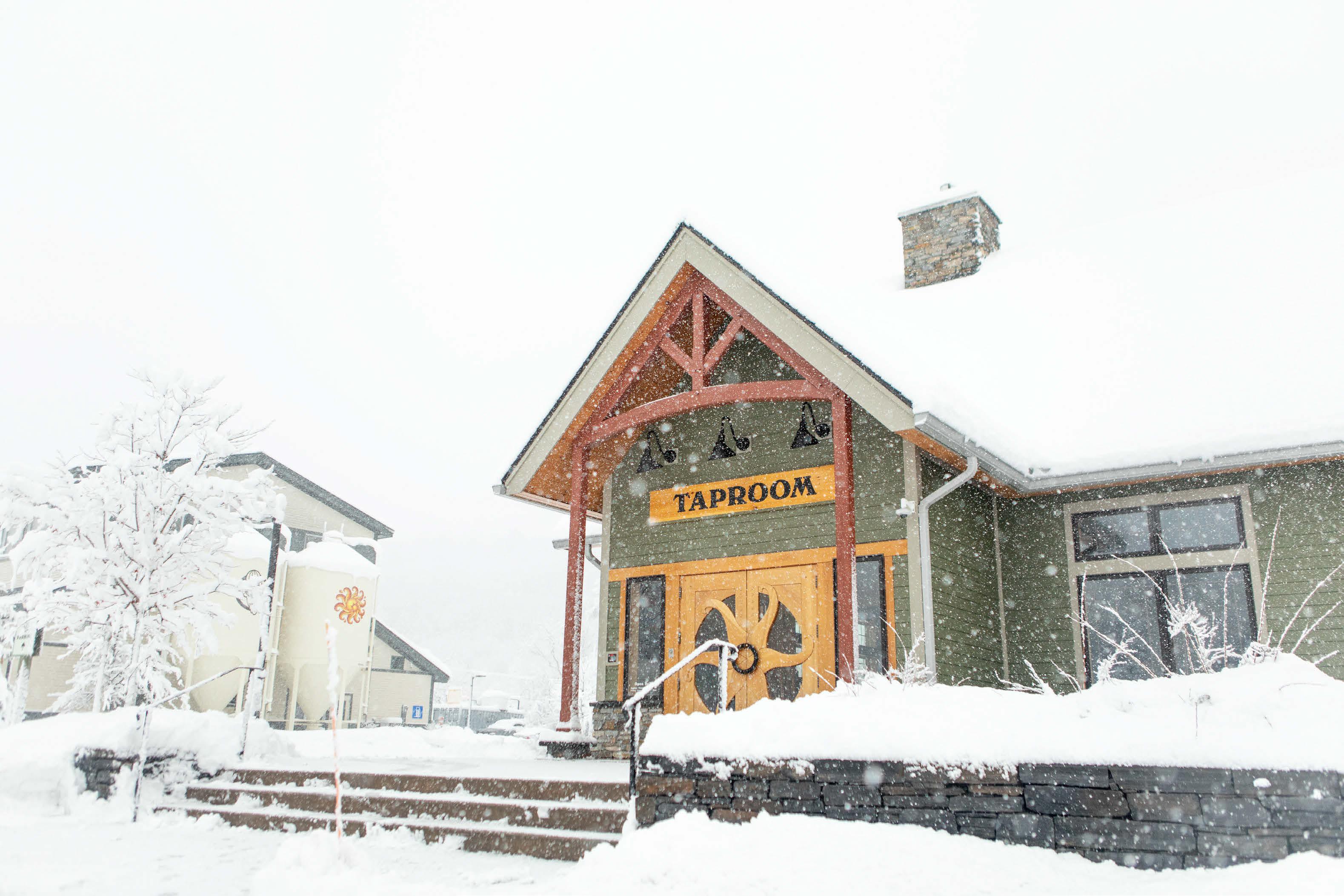




Guaranteed
Master the Moguls
You’re not a “good” skier unless you can ski the bumps. Here are four tips to get you there. By
Doug Stewart


As a ski instructor, I often hear: “I’m a good skier, I just can’t ski bumps.” That phrase doesn’t make sense: you aren’t a good skier unless you can ski bumps.
Groomed terrain doesn’t pass any judgments on your skiing. You can be out of balance and still feel like a legend on groomers. But in the bumps, balance and technique matter.
Earlier this season I was skiing at Stowe with Olympic gold medalist and mogul skier Donna Weinbrecht. She was crushing it, as always, but caught one mogul a little off. Still, she made a split-second recovery. Her comment: “It’s all about the recoveries!”
This is so true. I often think of mogul skiing as a series of linked recoveries. Balance is a dynamic thing and bump skiing really shows that; we are constantly moving in and out of balance while skiing.
As spring rolls in, the grooming will get more rare and the bumps will be growing, so start training with these four tips.
1. Absorb the terrain. Start by finding some rollers around the mountain. Ski into them slowly at first, and let your legs collapse and get short, like compressed shock absorbers, so your body stays level as you go over them and your skis stay on the ground. Catching air is awesome, but uncatching air is even more important when the terrain is uneven. See how well you can keep your skis connected on the snow as you add speed and hit terrain that is trying to send you up in the air. This absorption with your legs is essential to good bump skiing.
2. Ski flat and learn to skid. While on the groomers, carving with your skis up on high edge angles is a good time. In the bumps, even the icy ones, high edge angles don’t help much. Spend some time with your skis on less of an edge. Can you keep them flat and still make full turns? When making turns with flatter skis, you have access to a nice skid throughout the turn, and this is part of your speed control. Make sure to get the skis turned all the way across the hill and see if you can even slide down the hill a bit with the skis across the hill. Getting comfortable with this side slipping while skiing will be really helpful in the bumps.
3. Turn your legs, not your body. Great skiers have the ability to turn their legs more than their upper body, because when the going gets tough, it isn’t efficient to turn your whole body every time you turn your skis. While playing with side slipping, start to get your body, including your hips, to face straight down the hill while your skis point across the hill and you slide sideways. This is an essential move that will take some practice. When you finally feel your legs turning from your hips and you can get the skis fully across the hill while your upper body and hips remain facing downhill, your skiing will reach a new level of awesomeness.
4. Round off your turns. It usually helps to make a pretty short turn when skiing bumps, but that’s not always needed: You don’t have to turn on every bump. You can make wider turns and go right over bumps, as long as you have good absorption. If your turns have good shape, and you get your skis across the hill, you can keep your speed under control. There will be times when making a very straight turn and zipping down bumps will be the way to go, especially in the spring when things get a little softer and slower. But when the bumps are firm and fast, a rounder turn is ideal. A larger turn is easier to keep round and slow so even when skiing a tight line, keep the turns coming around and make them a little bit bigger. u
COACH vtskiandride.com Winter/Spring 2024 53
World Cup mogul skier Hannah Soar on her way to earning third place in moguls at the Jan. 16 World Cup in Waterville Valley, N.H. (top) and training for the Deer Valley World Cup. If you want to perfect your mogul game, Olympic medalist Donna Weinbrecht is hosts clinics at Killington in February and March. See killington.com for details. Photos courtesy U.S. Ski and Snowboard



BIG NIGHTS, BRIGHT MEMORIES Night skiing and après ski this winter. middleburysnowbowl.com MAKE TRACKS ALL WINTER LONG Season passes on sale now. rikertoutdoor.com


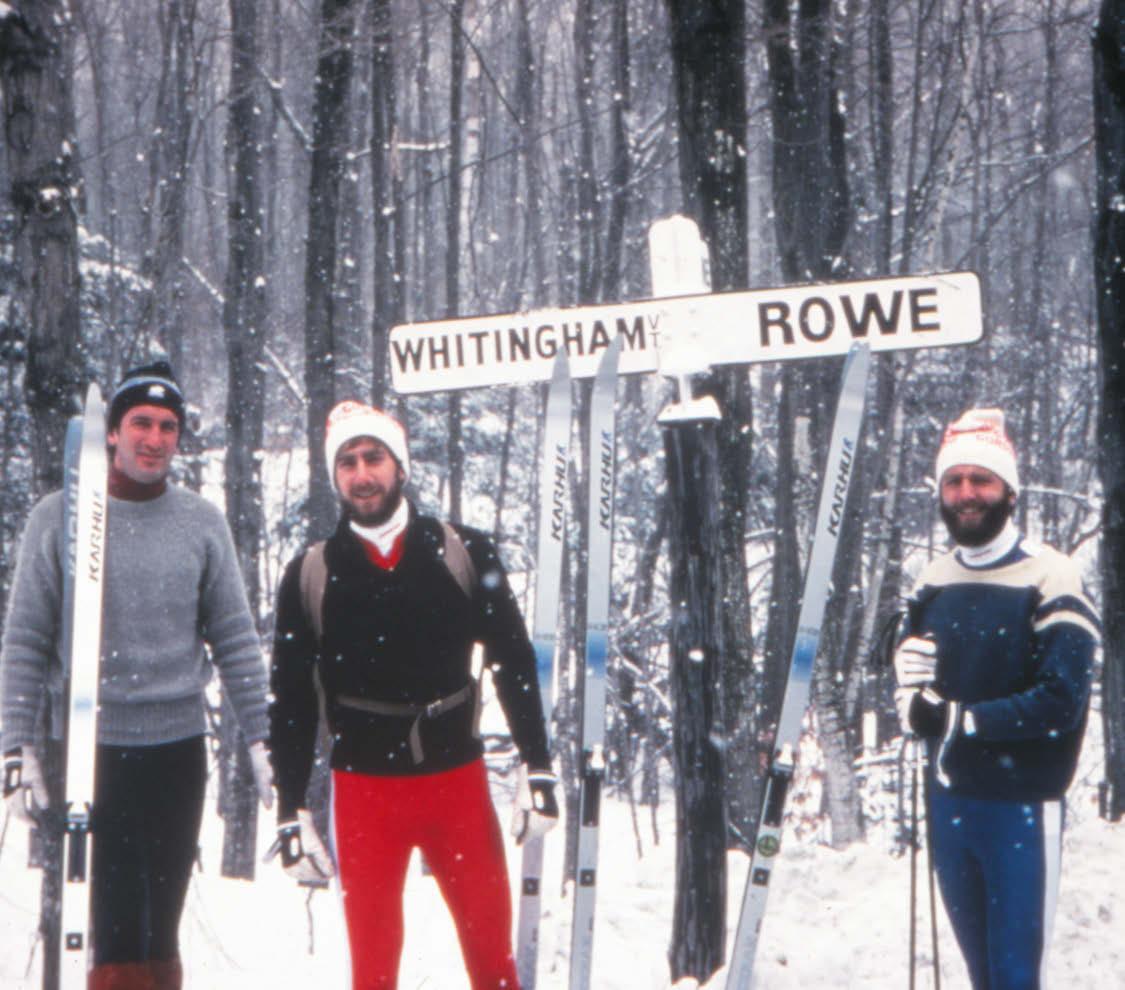
The Ruby Tour
Forty years ago, three friends skied and mapped a trail that would run the length of Vermont. Since then, the Catamount Trail has become a backbone of backcountry skiing. Now, the trio are skiing it again. By David Goodman.
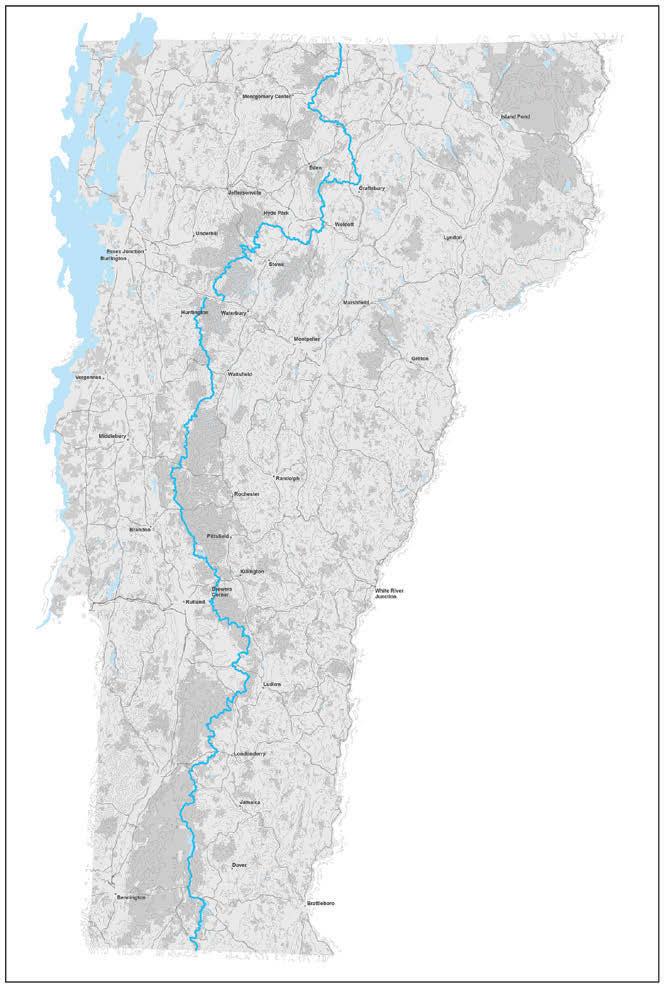
The mystique of the Catamount Trail was what lured me to Vermont.
That was back in the 1980s. I was living in Boston and had heard of a new 300mile winter route that runs along the Green Mountains, from the Massachusetts border to the edge of Quebec.
The mere idea of this trail intrigued me. Long-distance trails seemed a notion of a bygone era: In 1910, James P. Taylor, founding president of the Green Mountain Club, had envisioned Vermont’s Long Trail, a 272-mile footpath that follows the ridges of the Green Mountains. A decade later, Benton MacKaye, a planner, forester, and social reformer, proposed the idea of the Appalachian Trail, snaking some 2,000 miles from Georgia to Maine
Six decades later, it seemed we were at the start of something new: three 20-something
friends had just mapped out a long-distance ski trail. I wanted to ski it.
One particular section of the Catamount Trail caught my eye: the 9.4 miles that traversed the backcountry between Bolton Valley ski area and Trapp Family Lodge. It linked two storied ski centers.
In 1987, I traveled north with friends to explore this section of the three-year-old trail. We began climbing uphill from Bolton Valley Resort. Soon, I was breaking trail in knee-deep powder. We traversed the side of Bolton Mountain, then dropped into Nebraska Valley. Feathery flakes boiled up over my waist as I dipped down to carve telemark turns on the blank, white canvas. A few tumbles left me plastered in snow. We arrived hours later at the elegant Trapp Family Lodge. After an exhilarating tour through the Vermont outback, my partners and I were tired and happy for a warm drink.
Today, that section is often a well-skied highway. Catamount Trail has multiple inns along the route where you can bed down in luxury. Thanks to Vermont Huts Association, there are also a growing number of simple backcountry huts you can book. The Catamount Trail Association hosts multi-day tours of its 31 sections.
And starting Feb. 8, the three men who founded the Catamount Trail in 1984 will set off to ski it end to end again over 35 days, joined by friends and supporters along the way: The Ruby Tour, as they are calling it, so named for the 40th anniversary gemstone,
MAPPING A ROUTE
Back in the early 1980s, three recent grads were looking for their next adventure. Steve Bushey, a geography major at the University of Vermont, and Ben Rose, a recent Yale graduate, were friends from high school who had recently biked across the country together.
Paul Jarris, who had been a classmate and adventure partner of Bushey at UVM, was a fourth-year medical student at the U. Penn.
Following graduation from UVM in 1981, Bushey got a job as a mason in Charlotte, Vt. While working on a roof, he gazed at the undulating ridgeline of the Green Mountains and thought: Why not ski the length of Vermont?
vtskiandride.com Winter/Spring 2024 55
In 1984, Steve Bushey, Ben Rose and Paul Jarris (above, left to right) set out to ski a new route they had mapped that would connect Nordic and alpine ski areas the length the state.
RETRO VT
Today, he acknowledges this was a crazy idea. “The great thing about chasing something when you’re 22 or 23 years old, is you don’t think of all the labor and misery and cost,” he told me. “You just think about the dream.”
Bushey continued to ruminate. “I began trying to put together the pieces of a puzzle. The Long Trail was a mentor, a pattern. But as a geographer I needed to find out where other trails were,” he said.
In 1982, Bushey got a job with Northern Cartographic to write a cross-country ski atlas of Vermont. “That gave me the opportunity to collect lots of maps and visit ski centers from north to south. That was kind of the fieldwork.” He subsequently pursed a master’s degree in geography at Carleton University in Ottawa. For his master’s thesis, he created a route for an end-to-end ski trail the length of Vermont.
In 1984, Bushey recruited his old friends Rose and Jarris to spend three weeks skiing from Massachusetts to the Canadian border, linking inns and cross-country ski centers that they had contacted in advance for help with their mission. They incorporated the nonprofit Catamount Trail Association (CTA) the day before they began.
When the trio set off on March 1, 1984, they were not just skiers – they were evangelists. “We would be out there skiing and meeting people, selling this idea of this Long Trail for skiers,” said Bushey. “We collected our first members as we were skiing.”
From the start, the three friends had a vision for the Catamount. They wanted this trail to reach beyond skiing. Their project was as much about building community as it was about finding the next sweet turn.
Four decades later, the Catamount Trail is now what Vermont’s former Commissioner of Forest, Parks & Recreation Michael Snyder has called “the backbone, literally and figuratively, of cross-country skiing in Vermont, which has put us on the map for end-to-end skiing.”
A BACKCOUNTRY EVOLUTION
In recent years, backcountry skiing – loosely defined as skiing ungroomed terrain that is typically (but not always) beyond the boundaries of established ski centers – has evolved, and the CTA has had to adapt.
During the past decade, a grassroots skiing movement has emerged to create managed glade zones for downhilloriented backcountry skiing. Part of the impetus has been to rein in rogue glading, in which saw-wielding skiers cut down trees without the landowner’s permission or respect for forest stewardship goals.
“It becomes a tragedy of commons, and [the shared resource] breaks,” said Snyder. “It’s not sustainable. Glading was part of [skiing’s] past but it cannot be part of our future – or we won’t have a future.” It is also illegal: cutting a single tree on public land can incur fines of

up to $500. In October, 2023, a court ordered a New Hampshire man to pay $75,000 in fines for cutting ski glades on Vermont state forest land in Hazen’s Notch.
In 2013, a group of skiers formed what is now called the Ridgeline Outdoor Collective (originally Rochester/Randolph Area Sports Trails Alliance, or RASTA), with the goal of working with public land managers to create glades and approved backcountry ski zones. In 2014, ROC and the Green Mountain National Forest forged a first-in-the-nation partnership for a pilot project to cut and manage glade zones –areas where trees are thinned to create downhill ski routes. In 2014, ROC became the first chapter of CTA. There are now six chapters throughout Vermont, from the Southern Vermont Trails Association at one end of the state to the Northeast Kingdom Backcountry Coalition (NEKBC) at the other. The Western Massachusetts Backcountry Alliance has also joined.
The Catamount Trail Association is now a leader in the burgeoning grassroots backcountry ski movement. “The CTA is a national model,” said Todd Walton, executive director of Winter Wildlands Alliance, an organization that represents more than 100 environmental and grassroots ski groups around the country.
“In the Northeast,” Walton continued, “you have this really interesting partnership between private and public landowners. That doesn’t necessarily happen in the big western states. CTA has been an example of how to successfully work with the policymakers and landowners and land managers.”
GROWING PAINS – AND GAINS
“Backcountry skiing has been the only growth category in skiing for the last 6 to 8 years, and it’s been rising in double digits for several years,” said Walton, adding that
The blue markers of the Catamount Trail are familiar to many. Today, the Catamount’s 31 sections are well mapped and described on the CTA website. They range from the heavily skied Bolton-Trapps route to more secluded backcountry, each about a day’s ski or 8-13 miles long.
56 Winter/Spring 2024 vtskiandride.com
the growth of the sport was accelerated by the Covid-19 pandemic. It hasn’t stopped. In 2022-23, the Ski Industries of America trade group reported that there was a 16% increase in people ski touring over the previous year.
Usage of the Catamount Trail has reflected this surge. The number of skiers on the Bolton-Trapp Trail – that segment of the fledgling CT I first skied in the 1980s –more than doubled from 2018 to 2020. A typical Saturday will see around 70 skiers on this section, with peak days approaching 200 skiers. In the Brandon Gap glade zones managed by ROC, the number of skiers increased 70 percent between 2017 and 2020.
The Catamount Trail has been an important economic contributor to rural communities. A 2018 economic impact study done by SE Group for the CTA showed that day skiers on the Catamount Trail spend more than $300 per ski party, and more than $1,500 per party when they stay overnight in local accommodations. The study also found that skiers of just the Bolton-Trapp Trail (section 22 of the CT) generated $1.2 million in annual sales, $184,000 in yearly federal, state, and local taxes, and support 20 jobs.
That success, however, has come with challenges. The rise in users has posed problems ranging from inadequate parking to conflicts with landowners.
“There are real challenges and strains around community infrastructure,” explained Williams. “As interest and use grows, the onus is on us to do more to support users, support sustainable use of the resources, and do more intensive work with landowners to keep it open.”
Conservation and land stewardship have been cornerstones of the CTA’s work from the start. The organization acquired its first trail easement in 1994. It then set an ambitious goal of permanently protecting the entire 310-mile trail. Today, more than 70 percent of the Catamount Trail is permanently protected.
“I think the Catamount Trail has a bright future,” said Snyder, while noting that expanded access should be done thoughtfully. “We have to have a backcountry that maintains its character…that doesn’t turn into a Disneyland version of itself. It’s about backcountry, not just skiing.”
The greatest long-term challenge to the Catamount Trail, however, is one beyond the CTA’s control: the changing climate. A study sponsored by the climate action group Protect Our Winters projects that the average number of days with snow cover in New England will decline by 50 to 75 percent in the coming decades, depending on greenhouse gas emissions.


vtskiandride.com Winter/Spring 2024 57 RETRO VT
SKIING HUT TO HUT OR INN TO INN
Whether you want to connect sections of the Catamount Trail in luxury or attempt a backcountry thru-ski, there are a number of places to bed down along the way. These range from historic backcountry huts, such as the Bolton Lodge to cozy trailside inns such as Blueberry Hill Inn in Goshen to posh resorts, such as the Mountaintop Inn in Chittenden or the Trapp Family Lodge in Stowe. Interactive maps at catamounttrail.org show places to stay along the way.
Thanks to the Vermont Huts Association, there are also a number of backcountry huts located on or near the trail that you can book. These include newer purpose-built huts, such as the one at Grout Pond in southern Vermont, that have gas stoves, cookwear and bunks with mattresses. Prices range depending on the hut and they must be reserved and paid for ahead of time at vermonthuts.org

Other studies forecast that most ski areas in southern New England will be out of business by 2040, and there will not be skiing anywhere in New England by the end of the century.
In 2023, two skiers attempted to ski the entire route as a way to call attention to the challenges that climate change has brought. School teacher Bill Burrell wrote about his plan to ski the length of the trail for this magazine. “Last winter, on some sections of the Catamount Trail, there were 16 days that lacked sufficient snow for me to train. With less and less snow, I wonder why I would ever want to attempt a self-supported thru-ski on North America’s longest backcountry ski route,” he wrote.
The weather was not in his favor. Burrell encountered horrendous conditions and was forced to abandon his trek. A few weeks later, New Hampshire endurance athlete Torey Lee Brooks set out to do the same route, supported, as the subject of the short film 300 Miles Melting. In 2023, Brooks and Ann Coleman were the only two to complete the trail, end to end. Since 1984, only 141 thru-skis have been recorded.
“You can only do so much trail maintenance without snow,” said Greg Maino, a former director of communications for CTA. “We are looking for ways to improve our backcountry zones to the point where they can be skied with as little snow as possible.”
CT co-founder Steve Bushey noted that “the climate is pushing the trail uphill” into the snowier zones. He thinks the CTA’s embrace of higher-elevation glade skiing makes sense both recreationally and as a
response to climate change.
Bushey reflected on how far the Catamount Trail has come since he and his friends pushed off at a trailhead four decades ago. “I find it really remarkable that it has not only fulfilled the original vision of an end-to-end trail, but it’s grown way beyond that in terms of creating a community and network of Vermont skiers and outdoors people and land conservationists.”
With a laugh, he added, “We thought this might be a long shot, but it was worth going to the game to play. It captured the interest of a huge number of people, and it paid off. People joined up, put their shoulders to the wheel, and pushed that big boulder to the top of the hill.”
THE BACKYARD BACKCOUNTRY
The Catamount Trail that lured me north some 37 years ago is now just minutes from where I live. It is a familiar place, but each time I return, it feels new and exciting.
One morning, I pull into the trailhead to find skiers chatting, laughing, and putting skins on their skis. As quickly as they appear, they disappear up the trail following the distinctive blue cat’s paw blazes.
I slide up the trail and soon branch off to a favorite glade. Other skiers have vanished into their own snowy worlds. The woods are teeming with explorers, but I am embraced by the solitude. I peer down from the top of a beautiful hardwood grove. Ribbons of white lace the woods. A path that I have never seen before beckons. I glide forward, accompanied only by the sounds of my breathing and the snow brushing softly against my skis. Cold smoke erupts around me. u
RETRO VT
58 Winter/Spring 2024 vtskiandride.com
Catamount Trail pioneers Jarris, Rose and Bushey on their maiden trek with Tony Clark, the founder of the Blueberry Hill Inn and trail system at his Goshen property.







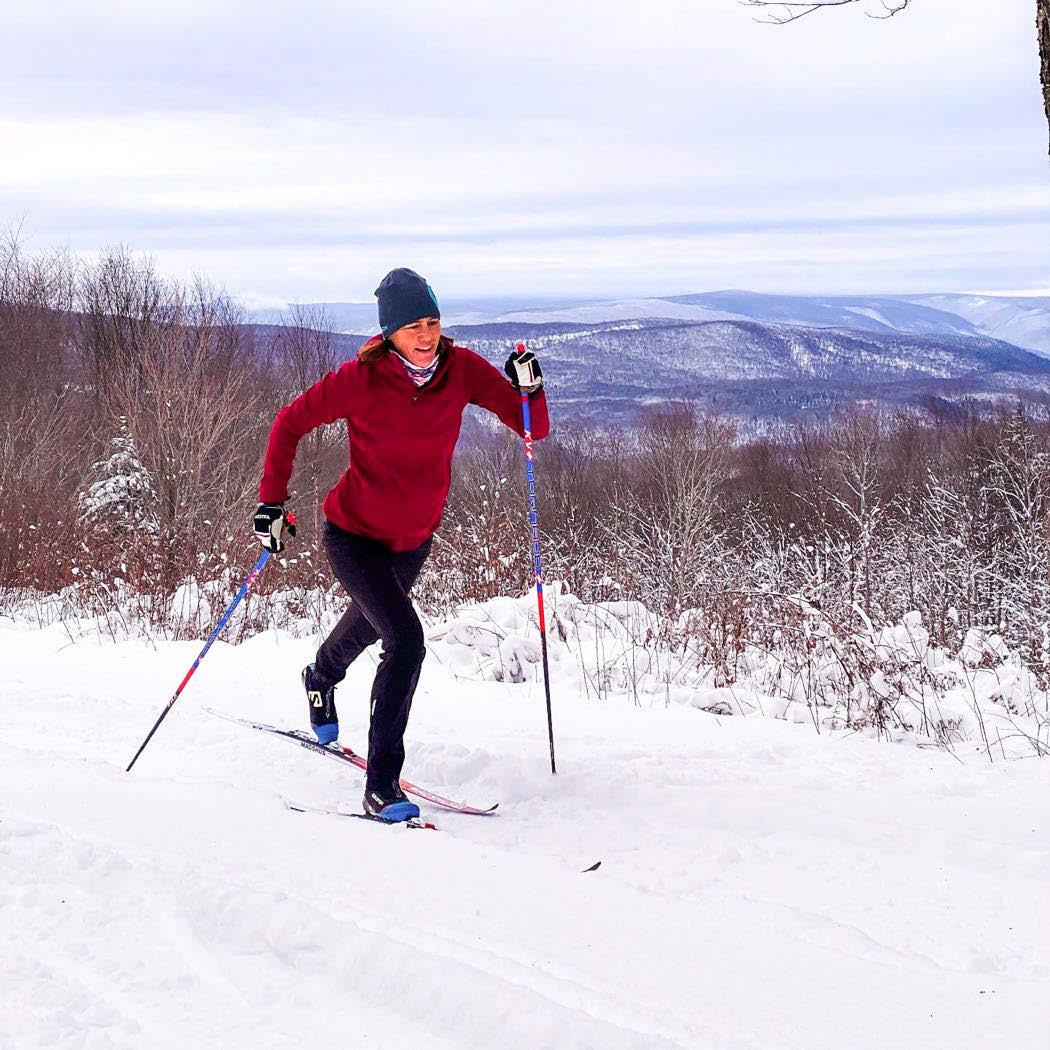
VERMONT AND NEW HAMPSHIRE DAYS
Being a local has its perks. Vermont and New Hampshire residents can take advantage of their geographic status and ski or ride Pico Mountain on Mondays, Thursdays and Fridays for just $51! That includes all day access to big mountain skiing with small mountain charm at Vermont's friendly mountain. Online purchase and valid VT/NH identification are all that's required to score this deal. Offer not valid on peak dates.
Scan code to learn more and purchase or visit picomountain.com/tickets.

 KILLINGTON, VT
KILLINGTON, VT

THE GREEN MOUNTAIN CALENDAR
FEBRUARY
2 | Burton Mystery Series, Stowe
Five-time Olympian Kelly Clark and Olympian and X Games champion Danny Clark and 20 participants from the Chill Foundation will be in Stowe for the first Mystery Series event to come to Vermont. Riders of all abilities will have a chance in the banked slalom. Plus product giveaways, demos and a BBQ. Burton.com
3 | Kandahar Mountain Race, Mad River Glen
The second leg of the MRG Triple Crown, the Kandahar channels the spirit of all -mountain races that were once commonplace. The version held in the 1980s began on Creamery, descended onto Moody’s, before taking on (Grand) Canyon. At the bottom of Canyon, racers went straight across Easy Way, over the cliff on One Way, and over S-Turn Cliff onto Lower Periwinkle and finished by the Double. The modern version still rewards those who can ski gates as well as terrain on the trail. madriverglen.com
3 | NE Rando Skimo Race, Bromley
“The Sun” race is for recreational skiers interested in a fun Saturday challenge, as well as elite ski mountaineers. The race’s unique dual format gives everyone a chance to participate and learn from the best, including World Cup champions and U.S. National Team members. Mass start time is 10:30 (no advance announcement,). Stay for schwag, food, and beer (non-alcoholic!). nerandorace.blogspot.com
10 | ADK Tour de Ski, Lake Placid, NY
The fourth stop on the ADK Tour de Ski is at Scott’s Cobble Nordic Center in Lake Placid. paulsmithsvic.org/adk-tour-de-ski/
10-11 | Donna Weinbrecht Mogul Camp
Rock the bumps with Olympic gold medalist and world champion mogul skier, Donna Weinbrecht, and Killington’s top coaches. Open to intermediate and advanced skiers, men and women. Repeats March 9-10. Killington.com.
10 | Party in the Peace Park with Danny Davis, Killington
Shred with illustrious pro snowboarder Danny Davis in Killington’s very own Peace Park as Danny helps us open it up in style. Come for the smooth transitions, stay for the autographs, live music, and complimentary burritos courtesy of MTN DEW. Killington.com
14 | Cloud 9 Nuptials, Mount Snow
Here’s your chance to have a free wedding or renew your vows at the top of the Cloud 9 lift at Mount Snow, a tradition that’s been going on for years. Mountsnow.com
18 | Tuck It! Magic Mountain, Londonderry
The East’s only radar-gunned ski and ride speed event. There’s a $1500 purse for the top 3 finishers on the line, with $1000 for 1st place and other prizes/awards by age group, male, female, ski, snowboard. It’s an all-out speed race–no gates–just a go for it speed tuck down a groomed Show Off. magicmtn.com
17-18 | Harris Hill Ski Jump, Brattleboro
The world’s top male and female ski jumpers compete on a 90-meter jump, and soar more than 300 feet at speeds of nearly 60 mph. The event has a festive atmosphere for the whole family with food, music, and a beer tent. harrishillskijump.com
18 | Andy Parry Tell A Friend Tour, Killington
This traveling freeskiing demo tour focuses on fun and eating pizza! Come ski with Andy Parry and crew at one of our Woodward Killington Mountain Parks. Stay tuned for full list of guest skiers and demo products. killington.com
25 | ADK Tour de Ski, Lake Placid, NY
The fifth stop on a new cross- country ski race series is at the Adirondack Mountain Club’s Cascade Welcome Center. paulsmithsvic.org/adk-tour-de-ski/
22-26 | Lake Memphremagog Winter Swim Festival, Newport
Join swimmers of all abilities from around the world who travel to Newport to plunge into a pool cut into the ice and compete for fun and prizes. kingdomgames.co
24-25 Kare Anderson Telemark Festival, Bromley
Come join expert tele skiers at Bromley Mountain with clinics all weekend for all skill levels whether you’re a beginner or advanced. Cap off the weekend with a race to test your skills. Bromley.com
25 | Extreme Challenge, Smugglers’ Notch
The Smugglers’ Notch Ski and Snowboard Club hosts this chance for junior and adult freeskiers and riders to show their big mountain skiing. Spectators will be treated to a birds’ eye view from Madonna I lift. Smuggs.com
25 | 79th Stowe Derby, Stowe
Ski from near the top of Mt. Mansfield’s Toll Road trail all the way to town or wherever the 20K course runs. Also, a 6K short course and 16K fat bike division. mmsc.org
MARCH
1 | Vertical Challenge, Burke
A series of free casual ski and snowboard races held at ski resorts throughout the Northeast. The VC includes a festival element, featuring activities for all ages and prizes. Skiburke.com
1-2 | Slash & Berm Banked Slalom, Killington
Snowboarders gather at The Stash terrain park to take advantage of the natural terrain and all the creative elements the mountain has to offer for a great cause: proceeds from the event will be donated to the Friends of Rutland Skatepark. Killington.com
2 | Vertical Challenge, Smugglers’ Notch
A series of free casual races held at ski resorts throughout the Northeast. The VC includes a festival element, featuring activities for all ages and prizes. Smuggs.com
2 | Carinthia Classic, Mount Snow
The Carinthia Classic is back and powered by Rockstar. Watch top freestyle athletes throw down on the Junkyard terrain park and compete for a piece of the $20K prize purse, plus enjoy a live DJ, giveaways, and more. Mountsnow.com
23| Jack Jump World Championships, Mount Snow
Watch as racers careen down the slopes on homemade jack jumps, single skis with seats mounted to them. It’s a Vermont tradition. Mountsnow.com
3 | Vertical Challenge, Bolton Valley
A series of FREE casual ski and snowboard races held at ski resorts throughout the Northeast. The VC includes a festival element, featuring snowy activities for all ages and prizes. Boltonvalley.com
5 | John Kearns Memorial Town Meeting Day, Mad River Glen
Vermont high school, middle school and elementary school students ski for FREE! A Town Meeting Day tradition, U12 and U14 racers descend on MRG for the annual John Kearns Memorial Race. madriverglen.com
8-10 | Red Bull Slide-In Tour, Killington
X Games gold medalist Zeb Powell returns to Killington with another stacked roster of Red Bull athletes. Don›t miss your chance to meet and ride with the pros. Killington.com
9 | Vermont Splitboard Festival, Middlebury Snow Bowl
Demos, tours, a vendor village and clinics on all things splitboard. Event is free but you must have a Snowbowl uphill pass ($10). splitboardvt.com
vtskiandride.com Winter/Spring 2024 61
THE GREEN MOUNTAIN CALENDAR
9-10 | Vermont Open Banked Slalom, Stratton
Riders will give it their all in a downhill slalom course featuring berms, bumps, jumps and rollers twisting down Big Ben. Riders will be individually timed, and the fastest at the end of the weekend will go home with trophy prizes. Registration will be capped at 300 riders: 150 riders in 17 years old & under, and 150 riders 18 years old & over. stratton.com
10 | The Bobcat Loppet, ADK Tour de Ski, Paul Smith’s VIC, NY
The last stop on the ADK Tour de Ski is the Bobcat Loppet at Paul Smith’s VIC. paulsmithsvic.org/adk-tour-de-ski/
10-11 | Donna Weinbrecht Mogul Camp
Rrock the bumps with Olympic gold medalist and world champion mogul skier, Donna Weinbrecht, and Killington’s top coaches. Open to intermediate and advanced skiers, men and women. Repeats March 9-10. Killington.com.
10-11 | Castlerock Extreme, Sugarbush
Skiers and rider compete in a challenging and technical freeski run down Castlerock’s infamous Lift Line. Categories for 14 and under, and 15 and older. sugarbush.com
16 | Rockefeller Challenge, Mad River Glen
The last event of the MRG Triple Crown, and an annual test of fearlessness and speed, the Rockefeller is a downhill-to-uphill ski race. Starting on the Practice Slope, competitors try to carry their speed down a designated race lane and up the Rockefeller trail. Like the sport of ski jumping where the skier who goes the farthest wins. madriverglen.com
16 | 12th Annual 24 Hours of Stratton, Stratton
A one-of-a-kind opportunity to ride Stratton at night under lighted trails into sunrise. See how much vertical you can rack up. Compete in the Vertical Uphill Challenge, the team costume contest, or on-hill scavenger hunt. There’s also a ski and snowboard flat boots race, an outdoor glow dance party and nighttime team trivia. New in 2024 is the #Shred4Nate alpine slalom race for mental health and suicide prevention. stratton.com
16 | The Pig Race, Blueberry Hill, Ripton
Get ready for the revival of the ‘Pig Race’—a classic Nordic ski event at Blueberry Hill trails with a legacy dating back to the 1970s, founded by Tony Clark. The 2.5, 7.5 and 15km selftimed ‘races’ guarantee jumps, spills, singletrack challenges, agility obstacles, and maybe a touch of early spring mud. Rain or shine, snow or no, the race will go on! Post-race, indulge in wood-fired pizza topped with savory pork (or veggie options), sip on good Vermont beer. Prizes for standout vintage ski outfits, epic falls, and more! blueberryhilltrails.com
16 | Vertical Challenge, Pico
A series of FREE casual ski and snowboard races held at ski resorts throughout the Northeast. The VC includes a festival element, featuring snowy activities for all ages and prizes. Killington. com
16-17 | Blauvelt Banks, Bolton Valley
Pro rider Jake Blauvelt designs a banked and bermed course that’s the blank palette for an expression session like no other. Benefits the Waterbury Skatepark. Boltonvalley.com
17 | Vertical Challenge, Bromley
A series of FREE casual ski and snowboard races held at ski resorts throughout the Northeast. The VC includes a festival element, featuring snowy activities for all ages and prizes. Bromley.com
22-24 | Homesick, Stratton
Celebrate the history and progression of snowboarding, the sport that got its start at Stratton with legends, pros, and up-and-comers. Watch the events, peruse the WITNESS Photo Gallery, get nostalgic in the Vintage Board Room, learn what it means to stand sideways from the beginning with The Dawning Exhibit. Ride demo snowboards, and après with live music and legends of the sport. stratton.com
23-24 | Reggaefest, Sink or Skim, Duct Tape Derby, Mount Snow
It’s a wild weekend with live reggae music in the main base area throughout the weekend, plus Sink or Skim pond skim on Saturday and the famous Duct Tape Derby (make your craft and race down the mountain) on Sunday. Mountsnow.com
23-24 Maple Open House Weekend, Statewide in Vermont
Around Vermont maple sugarhouses open their doors to the public, many offering up samples of sugar on snow and talks on how maple syrup is produced. For a list of participating sugar maker, see vermontmaple.org.
30 | Spring Brewfest Weekend, Smugglers’ Notch.
Enjoy a mix of local craft and regional brews as well as classic favorites! Don’t miss samples from Vermont’s best brews. A DJ spins the tunes, too. smuggs.com
APRIL
1-2 | Sugar Slalom, Stowe
Originating as a celebration of the arrival of spring and the tapping of maple trees, the Sugar Slalom is held in a Mardi Gras atmosphere complete with music, fantastic ski racing, and festive costumes. A slopeside party keeps with the theme of celebrating Vermont maple sugaring season. The race also features maple sugar-on- snow, doughnuts and pickles at the finish line – the perfect spring treat! mmsc.org
6 | Bear Mountain Challenge, Killington
The annual mogul competition and springtime party heats up once again as amateur bumpers take to the slopes of Outer Limits to battle for a place in the finals. The top 32 men and 16 women will compete in a head-to-head competition. Killington.com
7-8 | Solar Eclipse - White Out, Jay Peak
Directly in the path of the solar eclipse, Jay Peak celebrates with talks from meteorologists at Clips & Reels, performances by Pink Talking Fish (a band that covers Pink Floyd and the Talking Heads) and special lodging packages. Jay Peak.com
13 | Vertical Challenge, Jay Peak
A series of casual ski and snowboard races held at ski resorts throughout the Northeast. The VC includes a festival element, featuring snowy activities for all ages and prizes. Jaypeak.com
14 | Mad River Triathlon, Waitsfield
After nearly a decade, the Mad River Triathlon is back. The race starts with a 5 mile run, followed by a 6 mile canoe or kayak paddle in the Mad River. Racers will then hop on bikes for a 10 mile gravel ride to the base of Sugarbush - Mt. Ellen, where they will hop on AT/tele/splitboard setups for a 2 mile skin and ski to the finish. madriverpath.org/ madrivertriathlon
20 | Dazed and Defrosted, Killington
Celebrate the season with soft bumps, cold brews, and of course, great live music. Your finest spring attire is greatly encouraged. It’s also Season Passholder Appreciation Day: Beast 365, Winter 23/24, and Midweek passholders will be eligible to receive a free BBQ lunch. Killington.com
20 | Rasputita, Jay Peak
One of the nation’s best-loved gravel bike events, Rasputitsa celebrates 10 years with a new start at Jay Peak. Amateurs and pro cyclists come from all over the country to ride the muddy, snowy dirt roads of the Northeast Kingdom in a fun event that features Pearl Jam cover band Five Against None this year. Jaypeak.com
62 Winter/Spring
2024 vtskiandride.com
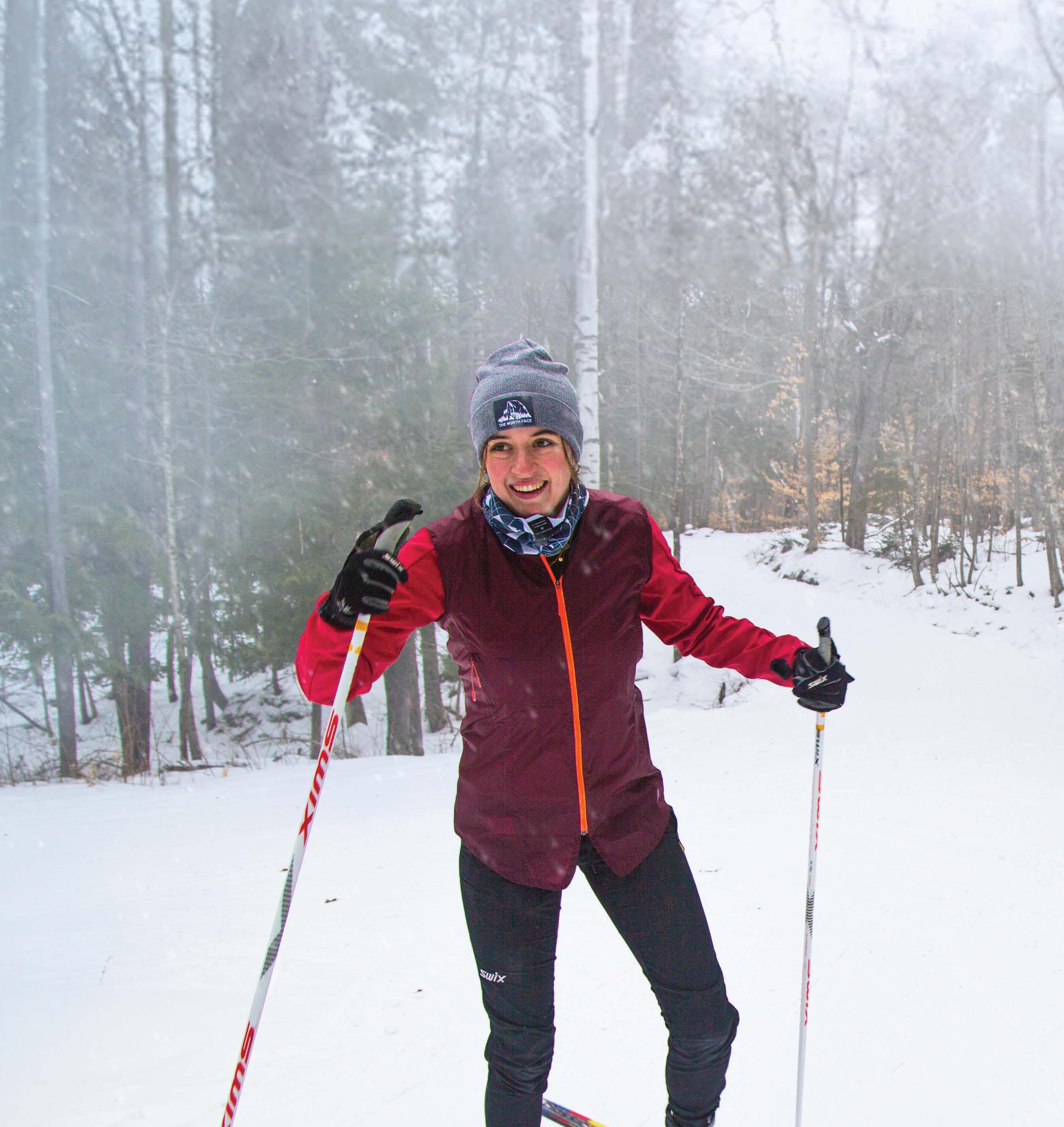


FLAGSHIP SHOP: 37 Church St, Burlington, VT | NEW, ESSEX STORE: 21 Essex Way #116, Essex, VT | SATELLITE SKI & BIKE SHOP: Riders Outpost, 7575 Main St, Waitsfield, VT SHOP ONLINE: gearx.com | 888.547.4327 | @outdoorgearexchange SKI. RIDE. CLIMB. BIKE. HIKE. RUN. CAMP. ADVENTURE. NEW, USED AND DISCOUNTED GEAR AT THE BEST PRICE. UNMATCHED SELECTION FROM TOP BRANDS KNOWLEDGEABLE, EXPERT STAFF HUGE DEALS ON BIKES & BOATS Vermont’s favorite gear shop. Save big on this season’s skis, boards, boots and bindings Why buy skis at OGE? Award-winning service. • Custom Boot Fits • Ski Mounts, Tunes & Skin Trims • Phantom Wax Ski Treatment
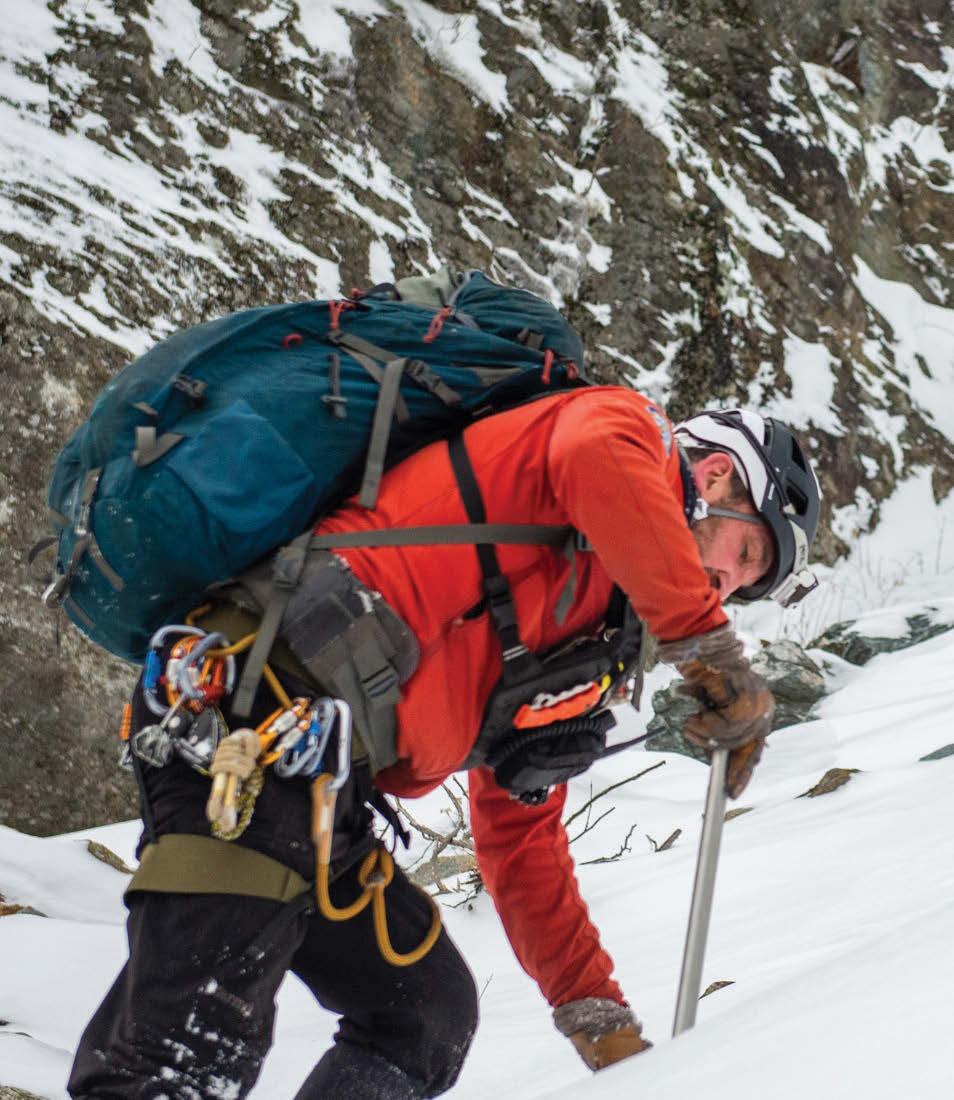
ORescue Chief
Why is this happening so often at Killington?
By Lisa Lynn
n Saturday, January 20 when several groups of skiers were reported lost on the back side of Killington Mountain, Drew Clymer got a call at around 2:30 pm and then another at 5:30. The temperatures were in the single digits and some of the 23 lost skiers were as young as 5. In 2022, Clymer took over as the Search and Rescue Coordinator for Vermont’s Department of Public Safety. Clymer came into this role after 7 years volunteering for one of the preeminent search and rescue teams in the East, Stowe Mountain Rescue.
How many people get lost in backcountry of Vermont each year?
Recently, quite a lot. All the press was about the 23 who were found on Saturday. Keep in mind that they didn’t all start out together –there were three or four different groups of them. We were lucky that most of them ended up in the same place, an area called Brewers Brook that’s 2.5 miles from the nearest road. But what most people don’t know is that on Friday, in the same area, we had 15 people lost!
On Thursday we had five. I don’t think we had any on Wednesday, but we had maybe four on Tuesday and two on Monday. So do the math –and that’s just one week! Then I had a couple of calls from lost skiers at other ski resorts in the midst of all that.
Are people just following others’ tracks into the backcountry?
There’s been a pent-up demand for backcountry skiing. But let me stress that these were not backcountry skiers who were lost, they were resort skiers who ducked a rope. They didn’t have AT gear or skins, or extra food or headlamps or any of the things that you should be carrying in the backcountry. To get to where they were, they had to pass a sign that says: “The woods are as lonely dark and deep as they were 100 years ago.”
To start with, the price of entry to the backcountry there is pretty low. You don’t need to hike or skin to somewhere. The terrain on the backside of Killington is also very remote. It’s not like you are going to ski down to a road.
What happens when a call comes in?
The first call is to 911, then I get notified and it’s my job to alert the people I think can best handle the situation. In this case, the first call I made was to Rescue Inc. I knew two of their people, backcountry skiers Dave Coppock and Joel Blumenthal, were in that area. They both have been on the Killington Search and Rescue squad and are now part of Rescue Inc. Dave found the first group pretty quickly and was able to guide them out but it was a long walk. At about 5:30 we got a call that another group was lost. Killington Search and Rescue (KSAR), Killington Fire/Rescue, Killington Resort Ski Patrol, and State PSAP/Dispatch were all notified and helped.
Were they lucky they had cell coverage?
Yes, very lucky. I always tell people, the minute you even think about calling make that call. Turn on your location sharing on your cellphone. Often, we can look at a map and talk to someone and guide them back to a trail. Also, be prepared to communicate just the most important basics: how many are in your party, what’s the health status of the members, where was your last known location, where is your car parked. You should also be prepared to wait as it may take a while to find you so try to build a fire and stay warm. Most of all, stay calm. During the Killington rescue, I could hear people —adults — going nuts in the background but I managed to stay on the phone with a 16-year-old girl named Grace who was amazing. She got us the answers, stayed calm and was a great communicator. I told her “You’re now in charge of the group.”
How did you get into search and rescue?
I feel like it’s what I was born to do. I’ve worked in public service. I’ve been an arborist, so that gave me familiarity with ropes and heights. I’ve been a lifelong surfer, which gave me familiarity with rough water rescues. I have always been a backcountry hiker and skier and an avid backcountry hunter. I was encouraged by a friend to join Stowe Mountain Rescue and then sought every opportunity to improve my skills. SMR does a great job of training and providing access to outside certifications.
64 Winter/Spring 2024 vtskiandride.com
CHAIRLIFT Q/A



 Matthew Nofziger, MD, SVMC Orthopedics
Matthew Nofziger, MD, SVMC Orthopedics





































































































































 Gary and Melanie (pictured at left) did much of the design for the home themselves. Each bathroom features a different, bold schematic using tiles sourced through Floor Coverings International. One of the owners’ bathrooms has black walls tiles (Emser Alchemy Silver), while a guest bathroom features Glazzio’s Magical Forest Periwinkle Dust subway tile (opposite, top).
Photos opposite by Lisa Lynn
Gary and Melanie (pictured at left) did much of the design for the home themselves. Each bathroom features a different, bold schematic using tiles sourced through Floor Coverings International. One of the owners’ bathrooms has black walls tiles (Emser Alchemy Silver), while a guest bathroom features Glazzio’s Magical Forest Periwinkle Dust subway tile (opposite, top).
Photos opposite by Lisa Lynn

 The main living area (above) is open with antique brass doors from the Hotel Saranac closing off a cozy library. The couple found the doors at Architectural Salvage in Essex Junction and had them refinished by Champlain Metals. The kitchen (opposite page, top) opens onto the living room. Its pergola-like crossbeams set it apart and echo the lines of the porch and the facade of windows (opposite bottom). Porcelain wall tiles —Porcelanosa Statuario— provide a light, airy feel to one of the owners’ bathrooms (below).
The main living area (above) is open with antique brass doors from the Hotel Saranac closing off a cozy library. The couple found the doors at Architectural Salvage in Essex Junction and had them refinished by Champlain Metals. The kitchen (opposite page, top) opens onto the living room. Its pergola-like crossbeams set it apart and echo the lines of the porch and the facade of windows (opposite bottom). Porcelain wall tiles —Porcelanosa Statuario— provide a light, airy feel to one of the owners’ bathrooms (below).













 Clockwise from top left: Bolton is a family business for founder Ralph DesLauriers, pictured with Bolton’s new managers; his children Evan and Lindsay to his left and Adam and Eric to his right. Back in the era of one-piece suits, Adam DesLauriers and Gabbie Velasquez charge moguls on home turf. Dean Decas pokes around Bolton in January, 2024. Bolton CEO Lindsay DesLauriers (at right) and Skida founder Corinne Prevot (at left) on a recent Bolton Babe Force outing. Adam DesLauriers in January 2024, poking around Bolton’s backcountry. Photos (clockwise from top): Courtesy Bolton Valley, Hank DeVre, Jen Bennet, courtesy photo, Jen Bennet.
Clockwise from top left: Bolton is a family business for founder Ralph DesLauriers, pictured with Bolton’s new managers; his children Evan and Lindsay to his left and Adam and Eric to his right. Back in the era of one-piece suits, Adam DesLauriers and Gabbie Velasquez charge moguls on home turf. Dean Decas pokes around Bolton in January, 2024. Bolton CEO Lindsay DesLauriers (at right) and Skida founder Corinne Prevot (at left) on a recent Bolton Babe Force outing. Adam DesLauriers in January 2024, poking around Bolton’s backcountry. Photos (clockwise from top): Courtesy Bolton Valley, Hank DeVre, Jen Bennet, courtesy photo, Jen Bennet.
 With acres of glades, guided tours and a rental program that has a wide array of AT skis, boots and splitboards, Bolton Valley has become Ground Zero for backcountry skiing . Photo this page and opposite by Ryan Denning.
With acres of glades, guided tours and a rental program that has a wide array of AT skis, boots and splitboards, Bolton Valley has become Ground Zero for backcountry skiing . Photo this page and opposite by Ryan Denning.













































 KILLINGTON, VT
KILLINGTON, VT




